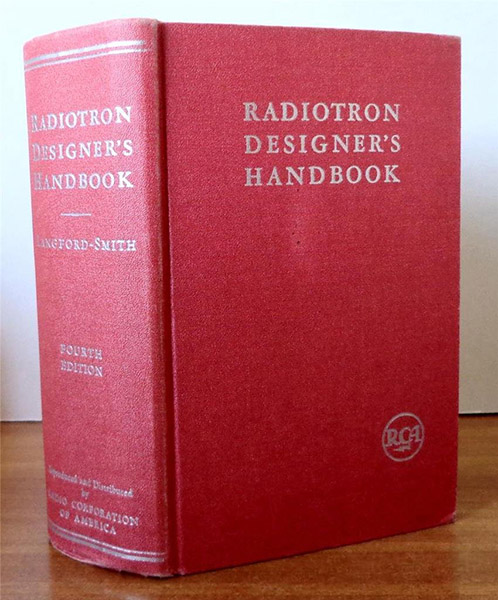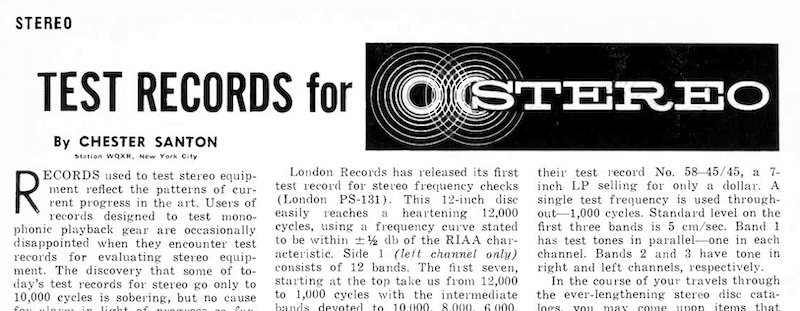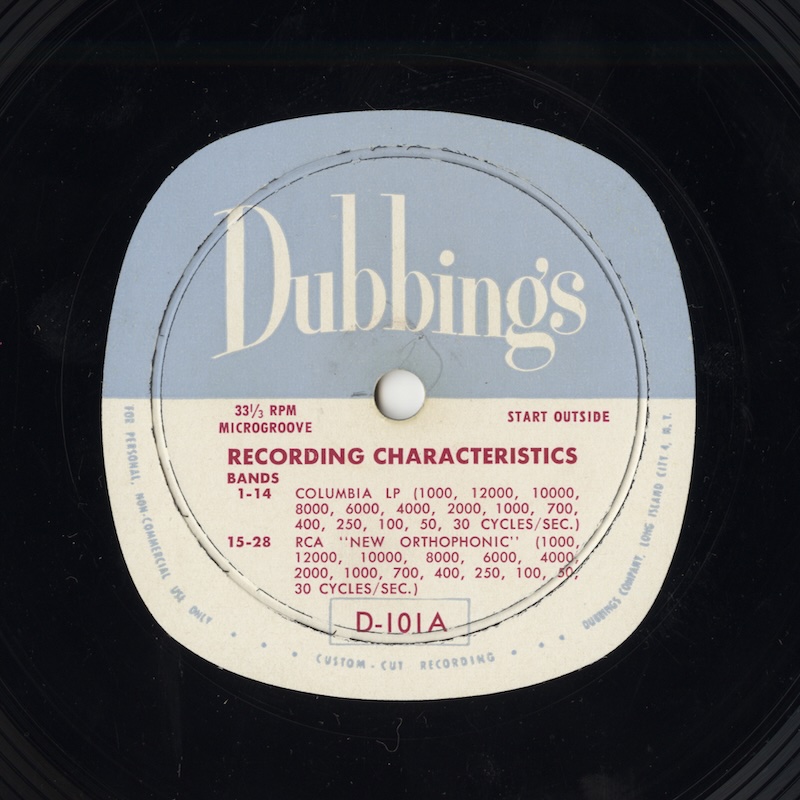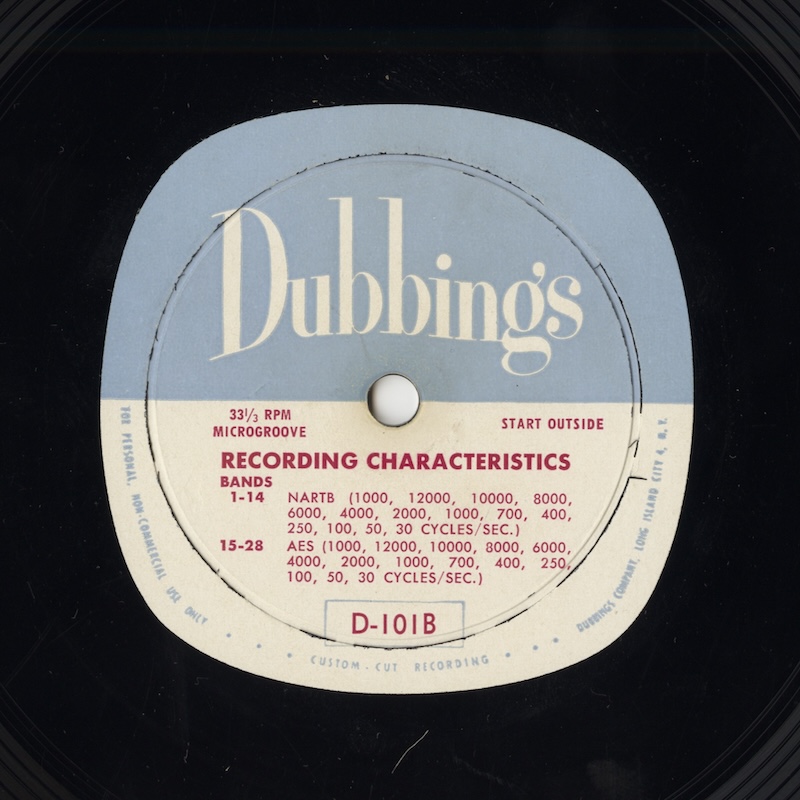EQカーブの歴史、ディスク録音の歴史を(私が独りで勝手に)学ぶ本シリーズ。前回 Pt.20 では、1954年〜における米国の各レーベルの RIAA 対応状況について各種資料から追いました。また、過去〜現在における EQ カーブ調査の系譜についてまとめました。
On the previous part 20, I looked for trace of how the U.S. labels migrated to RIAA, after the standardization of RIAA Recording and Reproducing Standards in early 1954, by researching various documents and magazines. Also I examined the genealogy of the studies and researches on EQ curves, from past to the present.
多忙等のため少し間があいてしまいましたが、今回の Pt.21 です。もともとは、今回を最終回として、今まで触れられなかった小トピックのほか、ここまでの学びの総括を行い、全体をどのように捉えるのがもっとも論理的整合性が高いと考えられるか、を考察するつもりでした。
After a long absence, here’s the Pt. 21. Initially I was thinking to make this part the summary and conclusion part of the entire series, including some other minor topics, as well as my final consideration of the history of the EQ curves, based on the whole study I have conducted, to find the most logical and consistent.
しかし、その「小トピック」のひとつを書き始めてみると、予想以上に分量が増えてしまったため(笑)、今回は、録音カーブの視点から眺めた「テストレコード」についてのみ扱うことにします。
However, once I started writing one of the “minor topics”, it became longer and longer… so this time I’m going to deal only with a variety of “Test Records”, from the viewpoint of disc recording curves.
ですので、当連載はもう少しだけ続く予定です(笑)
So this series of articles will be continued for a little while longer 🙂
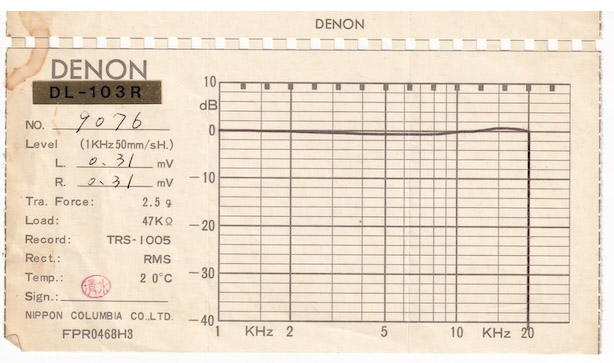
Frequency response graph sheet (Nippon Columbia FPR0468H3) that came with DENON 103-R Serial No. 9076, plotted using JVC TRS-1005 test record.
私が所有する DENON 103-R カートリッジ(シリアル番号9076)に付属してきた、JVC TRS-1005 テストレコードを使った特性グラフシート(日本コロムビア FPR0468H3)
毎回書いている通り、筆者自身の学習過程を記したものですので、間違いの指摘や異論は遠慮なくお寄せください。
As I noted in every part of my article, this is a series of the footsteps of my own learning process, so please let me know if you find any mistakes on my article(s) / if you have different opinions.
いつものように長くなってしまいましたので、さきに要約を掲載します。同じ内容は最後の まとめ にも掲載しています。
Again, this article become very lengthy — so here is the summary of this article beforehand (the same summary are avilable also in the the summary subsection).
周波数応答特性チェックに代表される各種テストレコードは、放送局や録音スタジオ、再生機器メーカなど、プロフェッショナルユースで長らく使われてきた。その際、厳密な測定は専用の機器などを使って行われた。
Various types of test records, as typified by frequency response characteristic checks, have long been used throughout the professional field, including broadcast stations, recording studios, and audio equipment manufacturers. In such cases, strict tests were conducted using specialized measurement equipment.
プロフェッショナル仕様の厳密なテストレコード以外にも、オーディオブームだった1950年代〜1980年代には、オーディオチェックレコード(ハイファイデモンストレーションレコード)を含め、再生機器の性能を聴感チェックするための民生用テストレコードが多種リリースされていた。
In addition to these strictly professional test records, a wide variety of consumer-use test records, including Hi-Fi demonstration records (a.k.a. “audio check records”), were released from the 1950s to the 1980s, when the audio boom was in full swing for aural checks of the performance of consumer equipment.
フォノカートリッジの応答特性チェックには、従来、ターンオーバー周波数より下を定振幅、それより上を定速度というカーブでカッティングされたテストレコードが使われてきた。この特性は、1950年頃までは、録音EQを抜いたカッターヘッド自体の特性であった。
For checking the response characteristics of phono cartriges alone, most test records were originally cut using a curve with a constant amplitude below the turnover frequency and a constant velocity above it. This curve was the same one as most cutterheads themselves had (without the recording equalizers) prior to around early 1950s.
フラットカッティングが可能になったフィードバックカッターが浸透したおよそ1950年代中頃〜後半頃からは、上のカーブの盤に加え、1kHz 以下は特定の録音特性(通常RIAA)、1kHz 以上は定速度、というカーブでカッティングされたテストレコードが主流となった。これは、当時使われていた主要なカッティングアンプに較正用ポジションとして用意されている特性(高域プリエンファシスのみオフ)、と同じであった。
Since mid-late 1950s, around when the feedback cutterheads (that enabled flat cutting) became penetrated in the mastering studios, most test records had been cut using a curve with a specific recording curve (typically RIAA or its equivalent), except constant velocity above 1kHz. This curve was accomplished by selecting the “TEST/FLAT” position (i.e. without the high-frequency pre-emphasis portion of the recording curve), that most recording amplifiers at the time were equipped with.
一方、カートリッジとフォノEQをあわせた総合応答特性チェックには、当時使用されていた特定の録音カーブでカッティングされたテストレコードが用意されていた。
On the other hand, for checking the overall response characteristics of the phono pickups and phono preamps (phono EQs) combined, test records cut with the specific recording curves that were actually used at the time.
RIAA規格策定前には、1942/1949 NAB カーブ(500B-16)、78回転用 ffrr カーブ(350N-5.5)、LP用 ffrr カーブ(500N-10.5)、Columbia LP カーブ(500C-16)、Bartók カーブ(630C-16)など、さまざまなカーブでカットされた周波数テストレコードが存在していたが、ステレオLP登場の頃には RIAA カーブによる周波数テストレコードしか存在しなくなっていた。
Prior to the establishment of the RIAA Standards, there existed a variety of frequency test records cut with various curves, such as the 1942/1949 NAB curve (500B-16), 78rpm ffrr curve (350N-5.5), LP ffrr curve (500N-10.5), Columbia LP curve (500C-16), Bartók curve (630C-16) and others. However, by the time the stereo LP was introduced, only frequency test records with the RIAA curve (time constants: 75μs, 318μs and 3,180μs) existed.
複数の録音再生カーブで収録された周波数テストレコードが、Dubbings (1953年) と Folkways (1954年) から1枚ずつリリースされていたが、これらは非常に例外的なものであった。
Only two test records containing test tones with multiple recording/reproducing curves — one from Dubbings Company (1953), the other from Folkways (1954) — are known to exist. Such test records are very exceptional and rare.
LP黄金期の米国では、当初は RCA Victor 12-5-49 が、1960年代中頃からは NAB Test Record が、それぞれデファクトスタンダードの基準レコードとして、米国内のほぼ全てのカッティングスタジオで使用されていた。前者は New Orthophonic 特性、後者は1964年 NAB 特性を規定するテストレコードで、共に RIAA 特性と数学的に同一定義である。
During the golden years of LP records, RCA Victor 12-5-49 and NAB Test Record was used as the de facto standard reference records in almost all cutting studios in the States. The former conforms to the New Orthophonic curve, the latter to the 1964 NAB curve — both sharing the same mathematical definition as that of the RIAA curve.
Contents / 目次
- 21.1 Diversity of “Test Records”
- 21.2 List of “Test Record List” Articles
- 21.2.1 “Frequency Test Records” by Richard H. Dorf (Radio-Electronics, Oct. 1948)
- 21.2.2 “Test Record List” (Audio Engineering, Sep. 1949)
- 21.2.3 “TEST RECORDS for STEREO” by Chester Santon (Radio-Electronics, Mar. 1959)
- 21.2.4 “A Short Guide to Test Records” by R.D. Durrell (High Fidelity, Dec. 1963)
- 21.2.5 “Test Records” by Arnold Schwartz (db, Apr. 1969)
- 21.2.6 “Test Discs” by Hugh Ford (Studio Sound, Feb. 1975)
- 21.3 Some More of the Test Records from My Collection
- 21.3.1 Decca Microgroove Frequency Test Record (Decca LXT 2695, c. 1952-1953)
- 21.3.2 “New Orthophonic” Frequency Test Record (RCA Victor 12-5-49, c. 1952-1953)
- 21.3.3 The Measure of Your Phonograph’s Equalization (Dubbings D-101, 1953)
- 21.3.4 Sounds of Frequency (Folkways FX-6100, 1954)
- 21.3.5 Stereophonic Frequency Test Record (London PS-131, 1958)
- 21.3.6 Stereo Test Record (Riverside RLP-1100, 1959)
- 21.3.7 Frequency Test Record (Victor Japan TRS-1001, c. mid-1960s)
- 21.3.8 Audio Technical Records (DENON / Nippon Columbia XL-7001/3, 1973)
- 21.3.9 Test Record for Cartridge File (SONY YESA-46, 1977)
- 21.3.10 Testing Your Equipment by DENON/PCM (DENON / Nippon Columbia OW-7401-ND, 1977)
- 21.3.11 Audio Test Record (Technics SFC-TR100, c. 1979)
- 21.3.12 Frequency Vinyl Disc / Service Vinyl Disc (TOYOKASEI TYO-1003, 2010)
- 21.4 Even Some More of the Test Records found on the internet
- 21.5 The summary of what I got this time / 自分なりのまとめ
21.1 Diversity of “Test Records”
今回は、1940年代〜にリリースされていた テストレコード に関する話題をみていきます。
In this Pt. 21, we’re going to look at the topics of test records released from the 1940s onward.
いわゆる「テストレコード」には大きく分けて2種類あります。
There are two main types of so-called “test records”.
1つ目が、特に1950年代〜1970年代に多数リリースされた、高音質音源を収録した「ハイファイデモンストレーションレコード」、「オーディオチェックレコード」、あるいは「聴感によるテストレコード」などです。これらは主として民生用オーディオユーザ(オーディオマニア)向けのリリースです。
The first is “high-fidelity demonstration records” which contains high-quality sound sources and sometimes being called as “audio check records”, or “listening test records”, most of of which had been released in large numbers especially from the 1950s to the 1970s. These are primarily releases for avid consumer audio users (a.k.a. audiophiles).
一例として、手元にはこんな盤があります。
As an example, here’s such a disc in my collection.
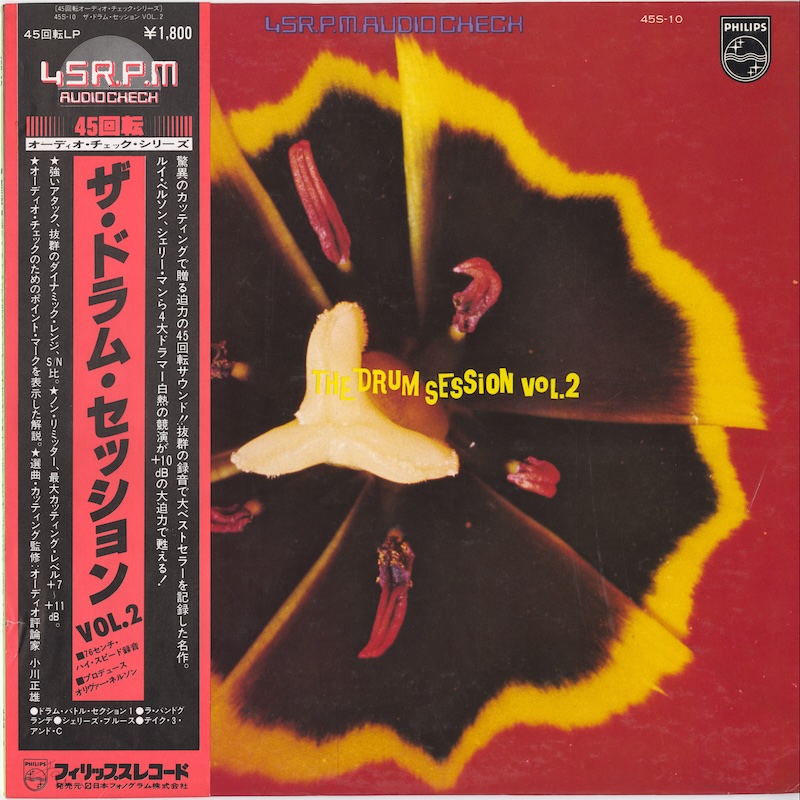
The Drum Session Vol. 2 / Louie Bellson, Shelly Manne, Willie Bobo, Paul Humphrey
(Philips / Nippon Phonogram 45S-10, 1977)
example of “audio check record” or “listening test records”, from my own collection
excerpts from Philips / Nippon Phonogram SFX-10001/2
聴感テストレコードの一例
Philips / Nippon Phonogram SFX-10001/2 (1975) の抜粋盤
76cm/s マスター(あるいはその2ndジェネレーションコピー)から45rpmでカッティングされた、リスニングチェック目的でリリースされたレコード
通常リリースの優秀録音盤や、トラッキングが難しいカッティングがされた盤などが、オーディオマニアによってリスニングチェック用レコードとして使われていたことから、さまざまなレーベルがオーディオチェック用と銘打った盤を制作、多数リリースし始めました。
Discs containing excellent recordings of regular releases, or discs that were difficult to track with pickups — such records were used by audiophiles for listening / tracking tests. Gradually, various labels started to manufacture and release special discs entitled “audio check records”.
それだけ、当時のオーディオブームには勢いがあったということなのかもしれませんね。
Perhaps this shows how vigorous the high fidelity audio boom was.
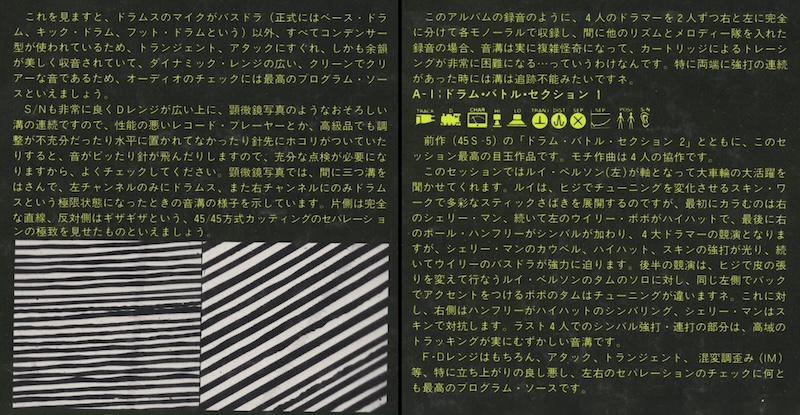
excerpt from 45S-10 liner-notes
45S-10 ジャケ裏のライナーノーツの抜粋
各トラックに添えられたアイコンは、「無線と実験別冊 オーディオ・チェック・レコード」(誠文堂新光社, 1976)から流用したものとのこと
このような、既存音源をコンパイルして「オーディオ・チェック・レコード」と銘打ったリリースは、特に1970年代の日本で多かったのかもしれません。
Such releases, in which various recordings were compiled and labeled as “audio check records”, may have been particularly common in Japan in the 1970s.
そして2つ目が、厳密な「計測用のテストレコード」で、カートリッジやフォノイコライザを中心にした再生機器の各種特性をチェック・計測・調整するためのものです。こちらは主としてプロフェッショナルユースであり、一般市場には流通しない盤も多くありました。
And the second is strictly “test records for measurement / calibration”, used to check, measure, and adjust various characteristics of playback equipment, especially phono cartridges and phono reproducing equalizers. These records were mainly for professional use, and many of them were not distributed to the general market.
後者には、例えば「周波数応答計測用テストレコード」があります。スイープ信号(または複数のスポット周波数信号)が、ディスクごとに決められた録音レベル(通常、cm/s at 1kHz で規定)で記録されており、実際に再生してみて高精度計測機器を使いレベルを正確に調べることで、一連の再生機器が正しく設定されているかを確認するために使われます。
Such records include “Frequency Response Test Records”, for example. A sweep signal (or a series of spot frequency signals) is recorded at a recording level determined for each disc (usucally specified in cm/s at 1kHz), and is used to verify that a series of playback equipment is set up correctly by actually playing it back and using high-precision measurement equipment to accurately check the level.
市販カートリッジによっては、出荷前に測定された特性グラフが付属している場合があり、以下のような周波数応答特性をプロットしたグラフが添付されているのを目にしたことがあるかもしれません。
Some commercially-available phono cartridges may come with a frequency characteristic graph measured prior to shipment, and you may have seen the following plotted frequency response characteristcs attatched to the cartridge.
そういった場面で JVC TRS-1005(1kHz〜50kHz のスイープ信号) や JVC TRS-1007(20Hz〜20kHz のスイープ信号)といった、周波数応答計測用テストレコードが使われています。
Test records for frequency response measurement, such as JVC TRS-1005 (1kHz to 50kHz sweep signal) and JVC TRS-1007 (20Hz to 20kHz sweep signal) have been used in such situation.
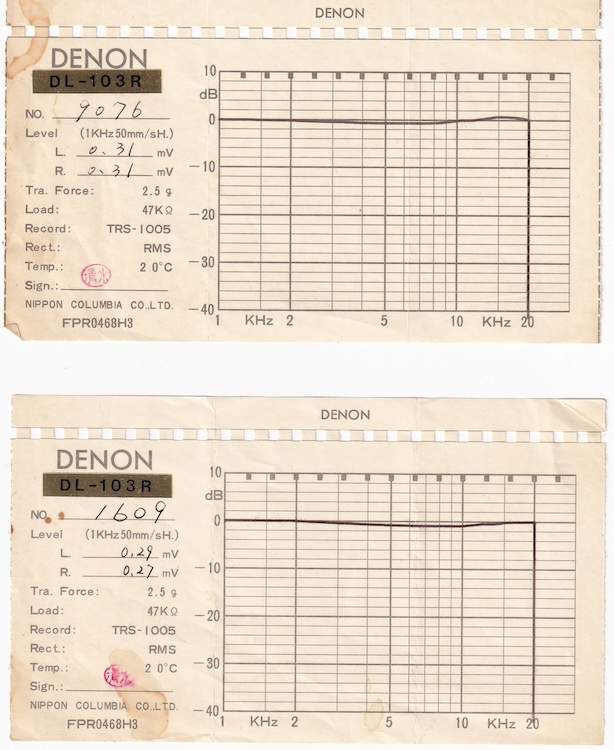
Frequency response graph sheets that came with DENON 103-R, plotted using JVC TRS-1005 test record.
私が所有する DENON 103-R カートリッジに付属してきた、JVC TRS-1005 テストレコードを使った特性グラフシート
定速度フラットな 1kHz 以上の領域を使用し計測されている
JVC TRS-1005 は 1kHz〜50kHz の全帯域で定速度フラットでカッティングされています。JVC TRS-1007 の場合、20Hz〜1kHz は RIAA 特性、1kHz 以上は定速度フラット(高域プリエンファシスをOFF)、という、いわゆる「500R-FLAT」で記録されています。
The JVC TRS-1005 is cut with constant velocity flat over the entire frequency range from 1kHz to 50kHz, while the JVC TRS-1007 is recorded with RIAA recording characteristics from 20Hz to 1kHz and constant velocity flat above 1kHz (i.e. RIAA’s high frequency pre-emphasis being turned off) — totally, so-called “500R-FLAT”.
つまり、両者とも、1kHz 以上の帯域は定速度フラットでカッティングされているわけで、共に「500R-FLAT」(318μs, 3180μs)と言って差し支えないでしょう。
In other words, both are cut at constant velocity above 1kHz, and both can be safely said to be “500R-FLAT” (318μs, 3180μs).
この録音特性は、Fairchild 641、Westrex RA-1574-D / RA-1703、Neumann LV60 / VG-66、Ortofon GO-741 など、当時使われていたほぼ全てのカッティングアンプに備わっていたテストポジションの特性でした(詳細は 本稿 Pt. 19 を参照)。
This recording characteristic was the one for the “TEST POSITION” of almost all cutting amplifiers in use at the time, including Fairchild 641, Westrex RA-1574-D / RA-1703, Neumann LV60 / VG-66, and Ortofon GO-741 (see also: Pt. 19 of my article for details).
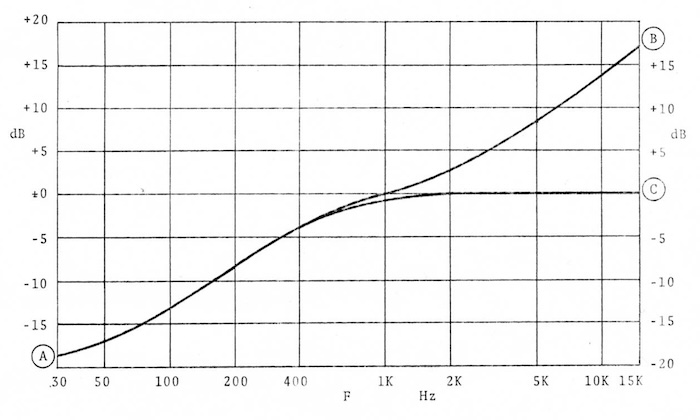
source: “Appendix C: The R.I.A.A. Frequency Response Characteristic for Disc Recording”.
Line AB is the RIAA characteristic of RA-1703, while line AC is the “response with the 75 μs high-frequency emphasis portion of the RIAA curve omitted, and is the response recorded with the switches on the RA1703 amplifiers in their FLAT position”.
Please note that about 1dB difference with or without HF pre-emphasis
Westrex RA-1703 インプットアンプ(RIAA録音イコライザ内蔵)の付属文書より
(A)〜(B) が RIAA 録音特性 (RIAAポジション)、(A)〜(C) は「RIAAカーブのうち 75μs高域増幅部分を割愛したもので、RA1703をFLATポジションにした時の特性」。
高域プリエンファシスの有無で 1kHz に約1dB差があることに注意
一方、DENON XL-7001 / XL-7004 やその再プレスである 日本オーディオ協会 AD-1 など、ターンオーバー250Hz、高域プリエンファシスなし、ベースシェルフなし、いわゆる「250N-FLAT」で記録されているものもあります。こちらの例はのちほど セクション21.3.8 で紹介します。
On the other hand, other test records for frequency response measurement, such as DENON XL-7001 / XL-7004 and their repress, Japan Audio Society AD-1, are recorded with a turnover of 250Hz, with no high-frequency pre-emphasis, with no bass-shelf — so-called “250N-FLAT”. This example will be presented later in Section 21.3.8.
これらの周波数特性計測用テストレコードの多くが、1kHz ないし 500Hz 以上の帯域が定速度フラット(すなわち高域プリエンファシスオフ)にされているのは、テストトーンのレベルとカッティング/トレーシング能力の兼ね合いです。
In many of these measurement test records, the frequency range above 1kHz (or above 500Hz) is cut with constant velocity (i.e. no high-frequency pre-emphasis), because of a bit complicated matter between test tone levels and cutting/tracking ability.
通常の音楽とは異なり、基準録音レベルの 1kHz の信号と同一の高いレベルのまま、高域プリエンファシスありで 10kHz や 15kHz の信号をカッティングすることは、カッターヘッドに高負荷がかかってしまったり、記録ができたとしても再生が困難となり、非現実的だからです(Pt. 1、Pt. 12 セクション 12.2.3 および コラム も参照)。
Unlike normal music sources, cutting a 10kHz or 15kHz tone signal with high-frequency pre-emphasis at the same high level as the reference 1kHz signal would be impractical, because of the high load of the cutter head;, and even if successfully cut, the difficulty of tracing/tracking would arise when it is reproduced (see also: Pt. 1, Pt. 12 Section 12.2.3 as well as its column).
1kHz 以上が定速度フラットのテストレコードは、主として、フォノイコライザを抜きにした、ピックアップ(フォノカートリッジ)単体の特性測定のために使用されます。
Test records with constant velocity flat above 1kHz are primarily used to measure the characteristics of the phono pickup (phono cartridge) alone, without phono pre-amplifier.
一方、基準となる 1kHz の録音レベルをかなり下げた上で、RIAA などの録音特性で全帯域をカッティングしたテストレコード、というのもあります。こちらの場合は、ピックアップ(フォノカートリッジ)とフォノイコライザの総合的な応答特性チェックに使われます。
In contrast, there is also a test record in which the reference recording level was lowered considerably and the entire frequency range was cut using RIAA or other recording characteristics. In this case, such record is used to check the overall response characteristics of the phono pickup (cartridge) plus phono preamplifiers.
その他、周波数応答特性計測用テストレコード以外にも、標準録音レベル、クロストーク測定、位相チェック、トレーシング性能チェック、など、さまざまなチェックを行う目的のトラックが収録されたテストレコードもあります。
In addition to the test records for measuring frequency response characteristics, there are also other test records that contained tracks intended for various checks, such as standard recording levels, crosstalk measurements, phase checks, tracing performance checks, and others.
| Sweep (Gliding) Tone / スイープ信号 |
|---|
| Continuous sine tone varying smoothly from low to high or vice versa used for phono pickup response test, total response check w/ phono EQ test, etc. Left-only and Right-only tones are also used for checking crosstalk 低音から高音(あるいはその逆)まで周波数を徐々に変化させるサイン波信号 フォノカートリッジの応答特性計測、およびフォノEQと合わせた特性計測などに使われる 左のみ、右のみの信号は、クロストーク計測にも使われる |
| Spot Frequency Tones / スポット周波数信号 |
| Distributed sine tones varying from low to high or vice versa used for phono pickup response test, total response check w/ phono EQ test, etc. 低音から高音(あるいはその逆)まで複数の固定周波数を収録したサイン波信号 フォノカートリッジの応答特性計測、およびフォノEQと合わせた特性計測などに使われる |
| Reference Level / 基準レベル |
| Fixed sine tone (usually 1kHz), recorded at a specified level, in cm/s at 1kHz used as a reference to calibrate frequency response, volume checking, adjusting cutting level, etc. usually expressed in cm/s 単一周波数のサイン波信号(通常 1kHz) 周波数応答較正用の基準、ボリュームチェック、カッティングレベル較正などに使われる 通常 cm/s の単位で表記される |
| Phase Check Signal / 位相チェック信号 |
| For home use: in-phase and out-of-phase signals to check connections of cartridge lead wires and/or speaker cables For professional: a set of signals with L/R phase varied often calibrated using oscilloscope with Lissajous figures ホームユースは正相・逆相音源が収録、リードワイヤやスピーカケーブルのチェック用 プロフェッショナル向けは、左右の位相をさまざまに変えた信号が収録されていることが多い 後者は、オシロスコープを使ったリサージュ波形の確認が一般的 |
| Wow and Flutter Measurement Signal / ワウ・フラッター測定信号 |
| A fixed tone (usually 3.15kHz or 3kHz) for checking turntable rotation instability, eccentricity of center hole, disc warp, etc. usually measured using a special device, consisting of FM demodulator, weighting filter, etc. 固定信号(通常 3.15kHz や 3kHz) ターンテーブルの回転ムラ、センターホールの偏心、版の反りなどのチェック FM復調器や重み付けフィルタなどで構成された専用の測定器で計測する |
| Non-Modulated Groove / 無音溝 |
| A Silent groove with no modulation, for measuring S/N ratio, etc. sometimes cut using specially crafted non-vibrating cutterhead 無変調の溝(無音)、S/N比の測定などに使われる 振動系を一切持たない特製カッターヘッドでカッティングされる場合もある |
これらの計測用テストレコードを使い全帯域を厳密に測定するには、それぞれ専用のフォノイコ回路が必要になります(Pt. 19 セクション 19.2.6 のコラム も参照)。
These test records require its own dedicated compensation circuit (phono preamp) for exact measurement of the full bandwidth (see also: Pt. 19 Section 19.2.6 Column).
例えば、有名な応答特性計測機器 Brüel & Kjær 4416 には、高域プリエンファシスなしの RIAA カーブ(500R-FLAT)用の特性が用意されており、その特性でカッティングされた同社の周波数テストレコードでの計測を可能としています。
For example, one of the famous response test unit Brüel & Kjær 4416 has de-emphasis circuits buit-in, including “for RIAA w/o high-frequency de-emphasis” (500R-FLAT). It is intended for use with B&K’s own frequency test records for precise measurement.
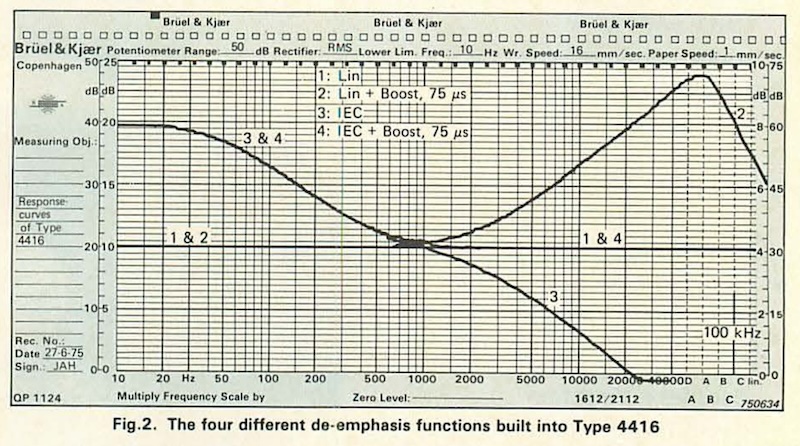
source: “Brochure for Brüel & Kjær 4416 Response Test Unit, QR 2009 / 2010 / 2011 Test Records”.
Brüel & Kjær 4416 応答テストユニット
(同社 QR-2009〜2011 テストレコードと組み合わせて使う前提)
に掲載された、4つのデエンファシス特性
1: 完全フラット(FLAT)
3: IEC (RIAA) 再生特性 (500R-13.7, 75μs + 318μs + 3,180μs)
4: 3 から高域デエンファシスのみ抜いたもの (500R-FLAT, 318μs + 3,180μs)
テストレコードによっては、ライナーノーツに専用フォノイコの回路図が掲載されているものもあります。
Some test records have a dedicated phono compensation circuit diagram in the liner-notes.
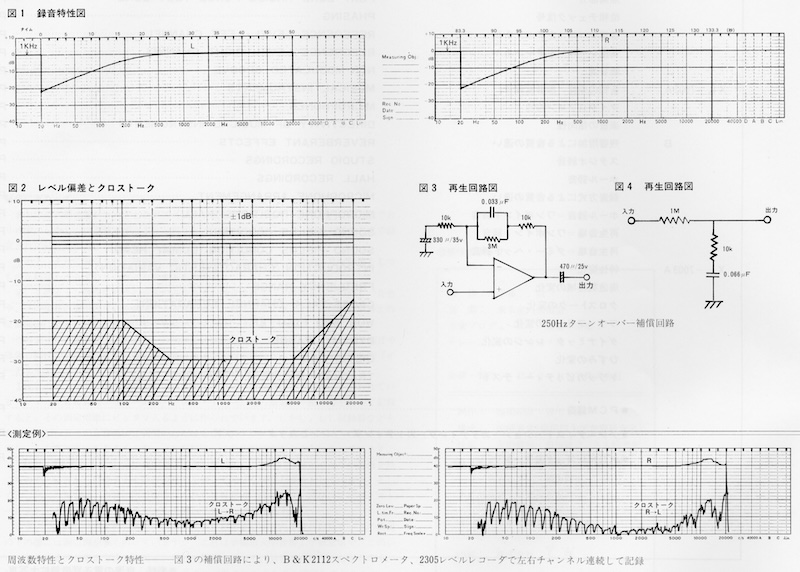
Recording Characteristics, Replay Compensator Circuits, and Frequency Response of DENON XL-7001 (XL-7004) Tracks A-1 & A-2
from the booklet of DENON XL-7001/3
from my own collection
XL-7001 A-1 と A-2 の録音特性カーブ(250N-FLAT)、専用の再生補償回路図、測定例が掲載されている
専用の計測機器がない場合、21世紀の今ならば、ADCでハイレゾ録音し、各種PCアプリを使って簡易計測することも可能です。
Even if dedicated measurement equipment is not available, it is possible to make high-resolution recording with an ADC (Analog-to-Digital Converter) and use various PC software applications to make simple measurements (thank you we live in the 21st century).
一例として、以下の優れたサイトで非常に平易に解説されているものが参考になるでしょう。
Below link is an example of such measurement with PC. This is an excellent website, explained in very plain words, and is very helpful.
また、有名なサイト Audio Science Review のフォーラムでも、各種テストレコードをPCで計測した結果が多数投稿されているスレッドがあり、参考になります。
There is also a thread in the forum of the well-known website Audio Science Review, where many results of measurements of various test records using PC have been posted, which are very helpful and informative.
もちろん、これら「聴感テスト用・デモンストレーション用レコード」と「計測用レコード」のほかにも、A面が厳密な計測用でB面が聴感テスト用、など、両者の中間的なテストレコードも多数あり、主にオーディオマニア向けにさまざまな種類がリリースされていました。
Of course, in addition to these “records for listening tests and demonstrations” and “records for measurements”, there were also many other test records that were intermediate between these two, such as Side-A for strict measurement and Side-B for listening tests. Various types of such records had been released mainly for avid audio hobbyists (audiophiles).
「Jazz & Audio Invitation To DENON PCM」(DENON YW-7401-ND, 1978)
B面冒頭の「オーディオ基本チェック」
このトラック以外は、DENON PCM ジャズの実際の音源
Track B-1 “Testing Your Equipment” on DENON YW-7401-ND (1978)
All the others on this record are DENON PCM Jazz performances
日本では、1976年にオーディオチェックレコード専門のムック「オーディオチェックレコードのすべて」まで出版されていました。
In Japan, there was even a mook (magazine-like publication) solely focused on audio check records, entitled “Everything about Audio Check Records” – published in 1976.
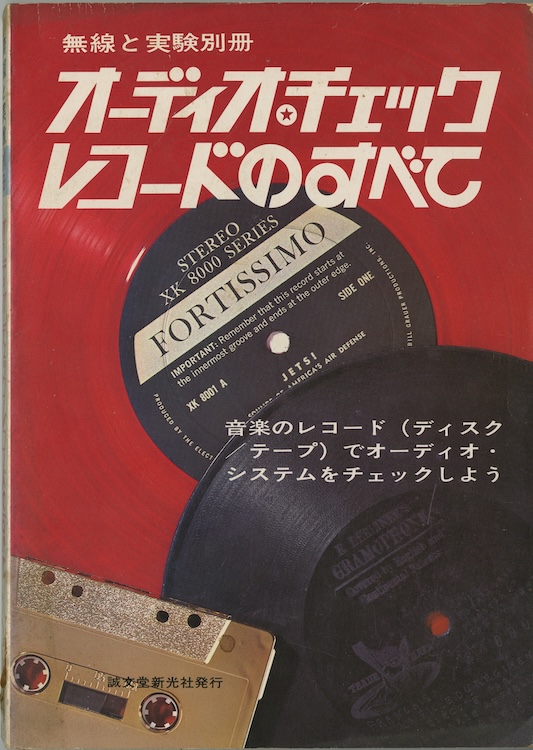
無線と実験別冊 オーディオチェックレコードのすべて
誠文堂新光社, 1976
聴感テストに使える優秀録音盤の紹介が大半だが、周波数テストレコードも巻末に掲載されている
“Everything about Audio Check Records”, a Japanese 198-page book, issued in 1976, listing many demonstration records/tapes and frequency test records/tapes.
ただ、マスタリングスタジオのプレイバックモニタ環境やカッティング機材の調整、放送局のターンテーブル周り、カートリッジ開発製造、オーディオ機器開発製造など、厳密な計測とチェックが求められるプロフェッショナルな現場においては、「計測用テストレコード」がリファレンスとして使われてきました。
However, “measurement test records” have been primarily used as a reference in professional settings where strict measurement and checking are required, such as playback monitoring environments and cutting environments in recording studios, turntables and peripherals in the broadcast stations, audio component manufacturers, cartride manufacturing plants, etc.
21.2 List of “Test Record List” Articles
技術専門誌や趣味のオーディオ雑誌などに掲載された、テストレコードを特集した記事は、かなりの数が存在しました。特に、周波数応答計測用テストレコードは、スタジオエンジニア向け雑誌などで頻繁に特集されていました。
There had been quite a few articles featuring test records that appeared both in technical magazines and hobby audio magazines. In particular, frequency response test records were frequently featured in magazines for studio engineers.
例えば、Pt. 9 セクション 9.2.5 で、Electronics 誌1945年11月号 に掲載された記事「Crystal Pickup Compensation Circuits」を紹介しましたが、その中で1945年当時のプロフェッショナル向けテストレコード数種が言及されていることに触れました。マグネットカートリッジとは全く異なる特性を持つ圧電式カートリッジで、市販のレコードを満足に再生可能な補正回路(フォノイコ)を用意すべきか、という記事でした。
For example, in Pt. 9 Section 9.2.5, I mentioned the article “Crystal Pickup Compensation Circuits” in the Nov. 1945 issue of Electronics magazine. In this article, several professional test records which were available at the time are mentioned. The article was about whether a piezo-electric cartridge, which has completely different characteristics from a magnet cartridge, should have a special compensation circuit (phono EQ) capable of satisfactorily reproducing commercial records.
その記事の中で、民生用再生システム用に Audiotone No.78-1、Columbia 10003-M、RCA Victor 84522、そして放送局用に RCA Orthacoustic 2485 と Western Electric TRL-100、という合計5枚の周波数テストレコードが紹介されていました。特に前者3枚のテストレコードは、1940年代当時の技術論文や解説記事中で頻繁に登場していました。以下再引用します。
Three frequency test records for consumer equipment, Audiotone No. 78-1, Columbia 10003-M, RCA Victor 84522, as well as two test records for broadcast equipment, RCA Orthacoustic 2485 and Western Electric TRL-100, were mentioned in that article. First three test records frequently appeared in technical papers and commentary articles of the 1940s. Below is the excerpt of the article, quoted here again:
Test records provide convenient and precise means for testing and adjusting the response of playback systems. (… snip …) Most test records are recorded with a constant amplitude characteristic up to the turnover point, and a constant velocity characteristic above the turnover point.
テストレコードは、再生システムの応答特性をテストし調整するための、便利で正確な手段を提供する。(…中略…) 多くのテストレコードでは、ターンオーバー周波数以下は定振幅特性で、ターンオーバー周波数以上は定速度特性で記録されている。
Among American-made lateral test records are Audiotone No.78-1 (250 cps turnover), Columbia Frequency Record No.10003-M (300 cps turnover), and R.C.A. Frequency Record No.84522 (500 cps turnover). These are 78-rpm records intended for use with home record players.
そのような米国製の横振動テストレコードには、Audiotone 社の No.78-1(ターンオーバー 250Hz)、Columbia 社の周波数レコード No.10003-M(ターンオーバー 300Hz)、そして RCA 社の No.84522(ターンオーバー 500Hz)などがある。これらは全て78回転盤であり、家庭用レコードプレーヤを念頭においたものである。
For broadcast test work R.C.A. Orthacoustic No.2485 (500 cps turnover) and Western Electric Test Record TRL-100 (250 cps turnover) 33⅓ rpm records are available.
放送テスト用には、RCA Orthacoustic No.2485(ターンオーバー 500Hz)と Western Electric テストレコード TRL-100(ターンオーバー 250Hz)という2枚の33⅓回転盤がある。
“Characteristics of Shellac Pressings”, Crystal Pickup Compensation Circuits, B.B. Bauer, Electronics, Nov. 1945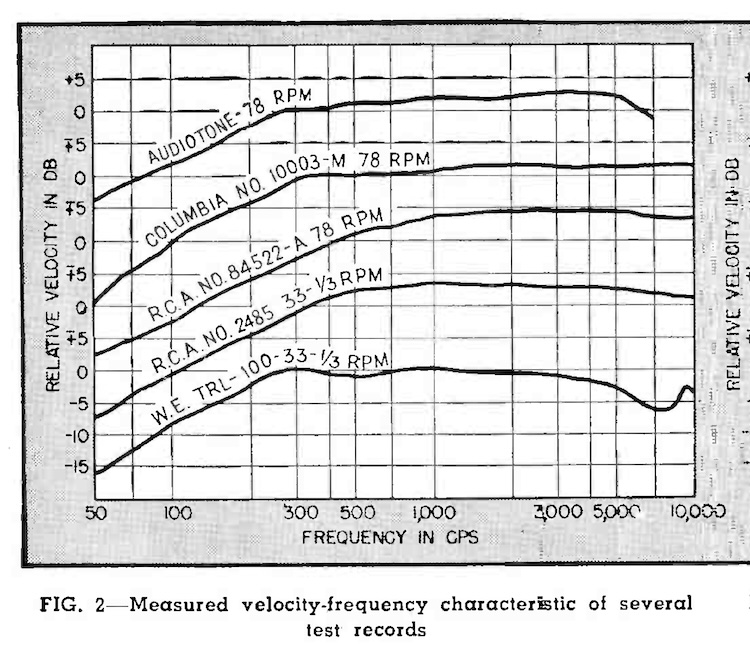
source: “Crystal Pickup Compensation Circuits”, B.B. Bauer, Electronics, November 1945, pp.129.
5枚の周波数テストレコードの特性グラフ
後年の計測グラフにくらべて、計測結果が意外とざっくりの値であることが興味深い
frequency response plots of five test records at the time
see the rough result of the measurements at the time (compared with more recent plots)
その他、RCA Victor が1953年に発行した、当時のラジオやオーディオのエンジニア向けの絶対的リファレンスだったであろう素晴らしく内容が充実した書籍「Radiotron Designer’s Handbook 4th Edition」の 753〜757ページ にも、1952年当時入手可能だったプロフェッショナル向けテストレコード一覧が掲載されていますので、興味のある方はご覧ください。
One of the others can be found on pp.753-757 of “Radiotron Designer’s Handbook 4th Edition”, a wonderfully comprehensive engineering book published by RCA Victor in 1953, that would have been the absolute reference for radio and audio engineers of the day. The list of professional test records available in 1952 is also included in the book. Please take a look if you are interested.
以下、本セクションでは、全てをみていくことはできませんが、過去のさまざまな雑誌等に掲載された「テストレコード一覧」記事のほんの一部を紹介します。
Below I am introducing some of such “Test Records Lists” articles found in past magazines etc., although not all are covered here.
21.2.1 “Frequency Test Records” by Richard H. Dorf (Radio-Electronics, Oct. 1948)
まず最初は、Radio-Electronics 1948年10月号 に掲載された「Frequency Test Records」です。この雑誌は1929年創刊の Radio-Craft 誌が前身で、ちょうどこの1948年10月号が、誌名を変更した最初の号にあたります。
The first is an article entitled “Frequency Test Records”, which appeared in the Oct. 1948 issue of Radio-Electronics magazine. This magazine was originally Radio-Craft, first published in 1929, and the Oct. 1948 issue was the first issue under the new name.
執筆者は Schober Organ Corporation の創業者にしてエンジニアの Richard H. Dorf 氏です。本稿 Pt. 9 セクション 9.2.6 に登場した「Practical Disc Recording」(1946)の著者でもあり、最も有名な著作は「Electronic Musical Instruments」(1955)でしょう。
The author is Richard H. Dorf, founder and engineer of the Schober Organ Corporation. He is also the author of “Practical Disc Recording” (1946), which already appeared in Pt. 9 Section 9.2.6, and his most famous book would be “Electronic Musical Instruments” (1955).
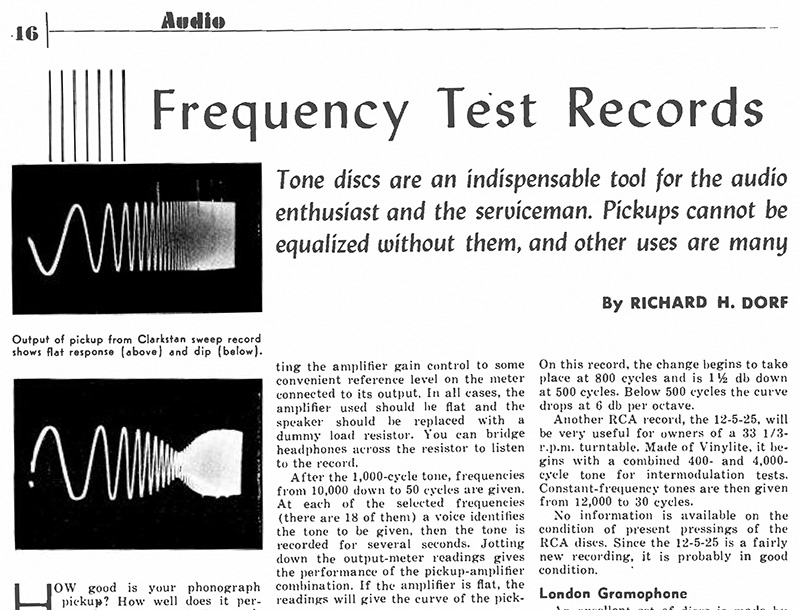
source: Radio-Electronics (formerly Radio-Craft), Vol. XX, No. 1, Oct. 1948, pp. 46-48.
1948年6月18日に Columbia Long Playing Microgroove レコードが発表されました(Pt. 11 参照)。その4ヶ月後の記事ですが、マイクログルーヴのテストレコードはまだ掲載されておらず、全てワイドグルーヴの33⅓/78回転盤のみとなっています。
Columbia unleashed Long Playing Microgroove records on June 18, 1948 (see: Pt. 11), and four months later, Mr. Dorf’s article was published. The article still does not list any microgroove test records — only wide groove 33⅓ and 78 rpm records are featured.
掲載盤はすべて、再生機器の周波数特性をチェック・計測・調整するための厳密な「計測用テストレコード」などで、当然ながらすべてモノーラル盤です。
All of the discs listed are strictly “frequency response test records” for checking, measuring and adjusting playback equipment. Of course, all discs are monaural.
当該記事冒頭は次のように始まります。
The article begins as follows:
HOW good is your phonograph pickup? How well does it perform? How Correct is the equalizer you have bought or built to go with it? You can find the answers to these questions with very little trouble and expense by using standard frequency records. At least one of these discs should be in the record library of every audio enthusiast. Radio servicemen who are called on to install and repair changers and hi-fi phono systems are missing a good bet too, if they don’t keep a tone record in the shop.
あなたの電蓄のピックアップはどのくらい優れているか? その性能は? あなたが買った、あるいは自作したフォノイコはどの程度正確か? 周波数レコードを使うことで、ほとんど手間と費用をかけず、これらの質問に対する回答を得ることができる。オーディオ愛好家のレコードライブラリに少なくとも1枚は入っているはずである。レコードチェンジャーやHi-Fiレコードシステムの設置や修理を行うラジオサービスマンも、店にトーンレコードをストックしていなければ、最良の仕事ができないことになる。
Phonograph pickups are not easy to calibrate with ordinary equipment. To check an amplifier, all you have to do is to connect an audio oscillator to the input and a voltmeter to the output and start twisting dials. But you can’t check pickups without a frequency record unless you use expensive custom-built laboratory equipment.
電蓄のピックアップを通常の機器で較正するのは簡単ではない。アンプをチェックするには、入力にオーディオ発振器を、出力に電圧計を、それぞれ接続し、ダイヤルを回すだけで良い。しかし、高価な特注の実験装置を使わない限り、周波数レコードなしでピックアップのチェックを行うことはできない。
Five firms make the test discs which are most easily available in this country. Each company makes several different records, each designed for a special purpose. To choose the proper one for your own needs, note the description of each record carefully and check the information against your own problems.
この国で最も入手が容易なテストレコードを製造しているのは5社ある。各社はそれぞれ特定の目的のために設計されたレコードを数種類製造している。自分のニーズに合ったテストレコードを選ぶには、各レコードの説明を熟読し、自分の問題と照らし合わせて情報を確認すること。
“Frequency Test Records”, Radio-Electronics, October 1948, pp. 46-48.続いて、米国で当時入手可能だった、5社のさまざまなテストレコードが紹介されています。
It is followed by various test records from five different firms that were available in the U.S. at the time.
| Cat. No. | Content |
|---|---|
| Columbia | |
| 10003-M | Shellac, 12-inch, 78rpm, 1kHz, 10,9,8,7,6,5,4,3,2,1.5,1kHz, 800,500,300,200,150,100,70,50Hz 300N-FLAT |
| 10004-M | Shellac, 12-inch, 78rpm, 1kHz, 10,9,8,7,6,5,4,3,2,1.5,1kHz, 800,500,300,200,150,100,70,50Hz |
| RCA Victor | |
| 12-5-5 (Old No. 84522A) |
Shellac, 12-inch, 78rpm, continuously varying tone, 10kHz to 30Hz 500N-FLAT |
| 12-5-25 (460625-6) |
Vinyl, 12-inch, 33⅓rpm 400/4000Hz intermodulation test; 12,11,10,9,8,7,6,5,4,3,2,1kHz, 700,400,300,200,100,70,50,30Hz 500N-FLAT |
| London Gramophone | |
| T-4996(A) | part of Album No. LA 32 Shellac, 12-inch, 78rpm glide freq., 14kHz to 3kHz ffrr (300N-5.5) |
| T-4996(B) | part of Album No. LA 32 Shellac, 12-inch, 78rpm glide freq., 3kHz to 10Hz ffrr (300N-5.5) |
| T-4997 | part of Album No. LA 32 Shellac, 12-inch, 78rpm glide freq., 14kHz to 10Hz ffrr (300N-5.5) |
| T-4998(A) | part of Album No. LA 32 Shellac, 12-inch, 78rpm 14,13,12,11,10,9,8,7,6,5kHz 500N-FLAT |
| T-4998(B) | part of Album No. LA 32 Shellac, 12-inch, 78rpm 4,3,2,1kHz, 400,250,100,55,30Hz 500N-FLAT |
| Universal Microphone | |
| D61B | Vinyl, 12-inch, 78rpm, inside start 50Hz to 2kHz, 200Hz to 500Hz, 500Hz to 10kHz, 1kHz, 400Hz 500N-FLAT |
| Clarkstan | |
| 1000A | Vinyl, 12-inch, 78rpm sweep freq., 10kHz to 70Hz 500N-FLAT |
| 1000D | Vinyl, 12-inch, 78rpm sweep freq., 15kHz to 5kHz 500N-FLAT |
| 100A | Vinyl, 16-inch, 33⅓rpm sweep freq., 10kHz to 60Hz NAB (500B-16) |
ご覧の通り、ほとんどの盤でターンオーバー周波数 500Hz、そして 1kHz より上は等速度フラット、つまり、いわゆる 500N-FLAT で記録されています。
As you can see, most test records are recorded with a turnover frequency of 500Hz, and constant velocity flat above 1kHz — so-called “500N-FLAT”.
これは、フラットカッティングが可能なフィードバックカッターが普及し始める1950年代より前は、ターンオーバー周波数はカッターヘッド自体の特性(および微調整)により設定されており、米国の多くのスタジオで、録音EQ装置を外してフラットにカッティングすると「500N-FLAT」になるように調整されていたからでしょう(Pt. 6 セクション 6.1.1 参照)。
This is arguably because, prior to the 1950s, when feedback cutters capable of flat cutting began to become popular, the turnover frequency was set by the characteristics (and fine tuning) of the cutterhead itself, and many U.S. studios followed the practice of adjusting to be “500N-FLAT” when cut flat with the recording EQs removed (see also: Pt. 6 Section 6.1.1).
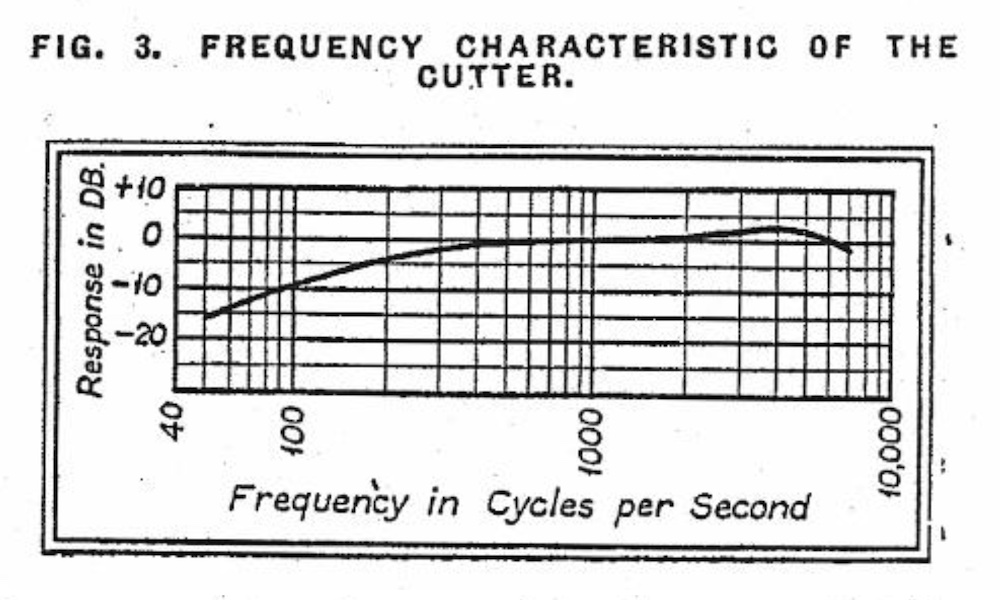
source: “An Instantaneous Recording Head”, George J. Saliba, Communication and Broadcast Engineering, March 1937 (archived at World Radio History), p.8
Presto 1-B カッターヘッドの裸特性、500Hz 以下のスロープがゆるい
Uncompensated frequency response of Presto 1-B Cutterhead: slope below 500Hz is shallower then 6dB/octave
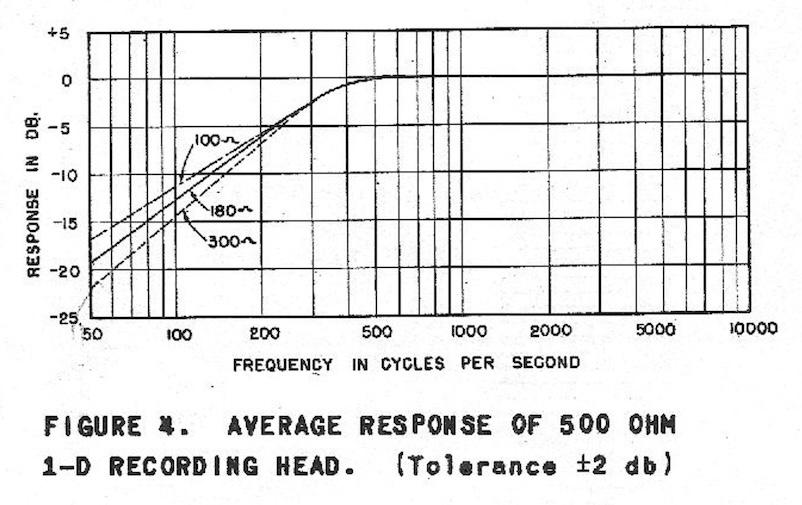
source: “Presto Recording Corp. 1-D Recording Head Instructions,
補正回路を追加し、500Ω版の Presto 1-D で最終的に得られる記録特性
500Hzより下は定振幅、上は定速度での記録となっている(誤差±2dB)。
これを「フラット」とし、さらに録音EQで特性を作っていった
1-D recording characteristics with additional compensator network, resulting in “constant amplitude below 500Hz, constant velocity above 500Hz”
this was used as “recorder FLAT”, then additional recording EQ was applied
例外として、Clarkstan 100A が NAB カーブ(500B-16)、3枚組セットの London album LA-32 の2枚が 78回転盤用 ffrr カーブ(300N-5.5)で記録されています。前者は米国の放送局の規格に沿った録音特性、後者は英Deccaで当時使用されていた録音特性です。
As exceptions, Clarkstan 100A was cut with NAB curve (500B-16); two of the three-disc set London album LA-32 were cut with ffrr curve for 78rpms (300N-5.5). The former is the recording characteristic in accordance with the U.S. broadcast standard (NAB) at that time, and the latter is the recording characteristic used by U.K. Decca at the time.

source: CLARKSTAN CORP. Brochure (at Pacific T.V. website).
ここでは 1000A / 1000D 共に FLAT と書かれているが、同パンフレットに「Constant amplitude below 500 CPS and constant velocity above 500 CPS」(500N-FLAT)と書かれている
ここでいう「recorded flat」とは、カッターヘッドの特性のみを使い、録音EQは一切使わずカッティングした、という意味と思われる
また、この記事では Columbia 10004-M は「ターンオーバー500Hz、1kHz 以上はフラット」と書かれていますが、実際には「NABカーブ、ただし1kHz以上はフラット」です。これについてはのちほど セクション21.2.2 のコラム でまとめて触れます。
Also, the article states that the Columbia 10004-M has a “turnover of 500Hz and is flat above 1kHz”, where in fact it is a “NAB curve, but flat above 1kHz” — this will be discussed later in Section 21.2.2 column.
同記事中、さらに興味深いことに、テストレコードのマスター自体の劣化の話として、以下の記述を認めることができます。テストレコードとはいえ、全ての盤が必ずしも完璧に同一特性を備えているとは限らない、という興味深い指摘となっています。
More interestingly, in the same article, the following statement is recognized, talking about the deterioration of the tesot record master itself. It is an interesting point to note that even though they are test records, not all of them necessarily have the very same characteristics.
Because of the age of the masters from which these Columbia records are pressed, the 10003-M is not flat at the high frequencies. Tests of several recent samples show that response begins to drop off at about 2,000 cycles and is down 9 db at 10 kc. About the same effect is present with the 10004-M.
コロムビアがプレスしたマスターが古いため、10003-M は高域がフラットではない。最近のサンプルをいくつかテストしてみたところ、約2kHzでレスポンスが落ち始め、10kHzでは9dBもレスポンスが低下した。10004-M においても同様の現象が見られた。
“Frequency Test Record”, by Richard H. Dorf, Radio Engineering, October 1948, p. 46 & 48.また、テストレコードも、再生条件によっては劣化から免れられません。至極当然のことですが、この件について厳密に調査した1961年の学術論文「Some Aspects of Wear and Calibration of Test Records」があることに触れておきます。
Test records are also not immune from deterioration under certain playback conditions. It is quite obvious, but I should mention that there is a 1961 academic paper entitled “Some Aspects of Wear and Calibration of Test Records”, that rigorously investigates this matter.
著者は、Shure のカートリッジ開発セクション筆頭の Roger Anderson 氏で、最初期ステレオカートリッジ Shure M3D の筆頭開発者としても知られている方です。
The author is Roger Anderson, the head of Shure’s cartridge development section, who is also known as the lead developer of Shure’s early stereo phono cartridge, Shure M3D Stereo Dynestic Cartridge.
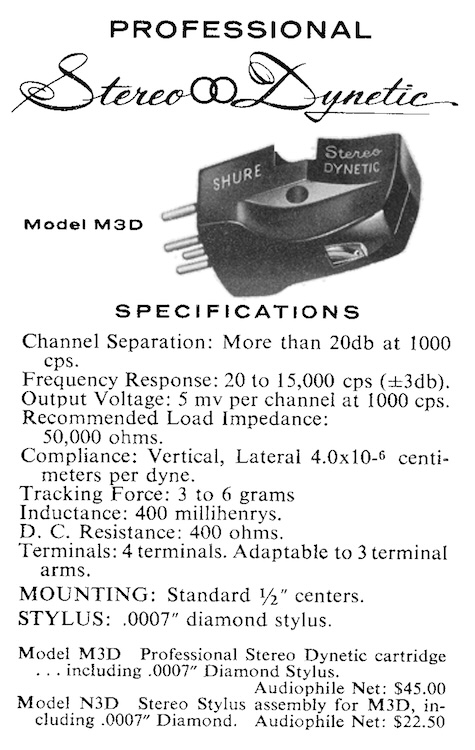
source: Shure General Catalog No. 59, p.24.
1959年 Shure 総合カタログに掲載された M3D ステレオカートリッジ
同記事執筆時点ではワイドグルーヴのテストレコードしか存在していませんでしたが、Columbia がまもなくマイクログルーヴLP用の周波数テストレコードをリリース予定であることにも触れられています。
It also mentions that Columbia will soon be releasing frequency test records for microgroove LPs, although only wide-groove test records existed at the time of the writing of the article.
Columbia is understood to be preparing a new set of test discs, including at least one which can be used to calibrate pickups for the new Microgroove records. Most discs cannot be used for this purpose because the grooves are too wide for the 1-mil-radius needle.
コロムビアは新しいマイクログルーヴ用ピックアップの較正に使える盤を含む新しいテストレコードセットを準備中であることが知られている。(現在入手可能な)ほとんどのテストレコードは、半径1milの針に対して溝が広すぎるため、この目的(マイクログルーヴ用ピックアップの較正)には使用できない。
“Frequency Test Record”, by Richard H. Dorf, Radio Engineering, October 1948, p. 46 & 48.21.2.2 “Test Record List” (Audio Engineering, Sep. 1949)
続いて、Audio Engineering 誌 1949年9月号 に掲載された「Test Record List」という記事から。1949年当時入手可能だったテストレコードの一覧とそのスペックが掲載されています。
The next article, “Test Record List”, from the Sep. 1949 issue of Audio Engineering magazine, lists the test records (available at the time of the writing) and their specifications.
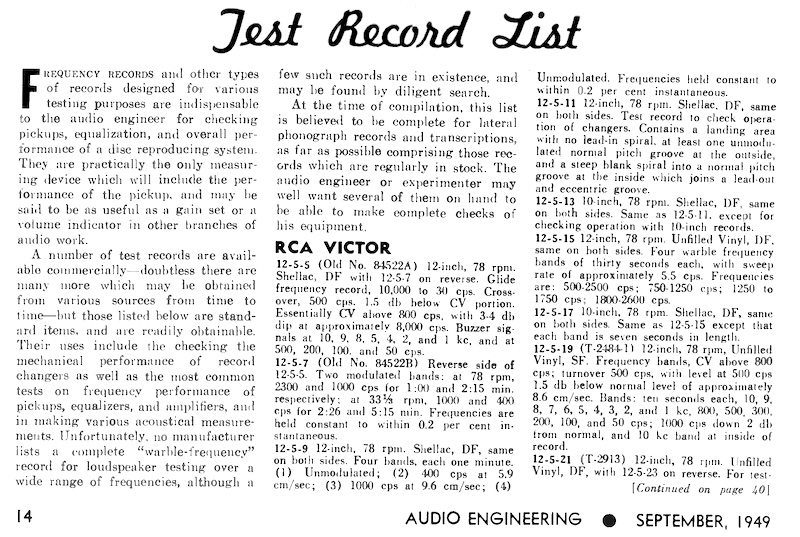
source: Audio Engineering, Vol. 33, No. 9, Sep. 1949, pp. 14, 40-43.
執筆者は記されていませんが、錚々たる専門家の名前を連ねる編集顧問委員会を備えた Audio Engineering 誌ですから、オーディオ工学専門家の知見が反映されている記事と考えて良いでしょう。
The authors are not specified, but since Audio Engineering magazine has an editorial advisory board of eminent experts, it is safe to assume that this article reflects the knowledge of audio engineering specialists.
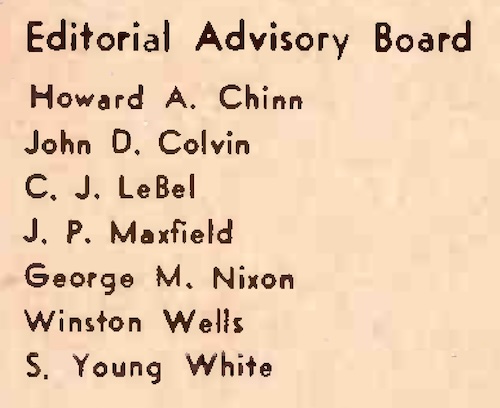
source: Audio Engineering, Vol. 33, No. 9, Sep. 1949, p 3.
Audio Engineering 誌1949年9月号の目次に記された、編集顧問委員会メンバの名前
オーディオの歴史を紡いできた錚々たる研究者・開発者の名前が並んでいる
先ほどの Radio-Electronics 誌の記事同様、ここで紹介されているテストレコードもすべて、再生機器の周波数特性をチェック・計測・調整するための厳密な「計測用テストレコード」で、1949年ですから、当然ながら依然すべてモノーラル盤です。
Like the Radio-Electronics magazine article mentioned earlier, most of the test records introduced here are also strictly “measurement test records” for checking, measuring, and adjusting the frequency response of playback equipment. Again, all are still monaural.
この「Test Record List」が掲載された1949年9月という時期は過渡期にあたります。1948年6月登場の Columbia マイクログルーヴ 33 1/3回転 LP 盤(Pt. 11 参照)、1949年1月発表〜4月販売開始の RCA Victor マイクログルーヴ45回転盤(Pt. 13 参照)の直後であり、従来からの78回転盤とあわせて3スピードのフォーマットが一般市場に存在していた時期でした。
September 1949, when this “Test Record List” was published, was a transitional period — a year after the debut of Columbia Long Playing 33⅓rpm microgroove records (see: Pt. 11), and just after the debut of RCA Victor 45rpm microgroove records (see: Pt. 13): the three-speed format, 33⅓, 45 and 78, was in existence in the general market.
また、16インチ33 1/3回転ワイドグルーヴ放送局用トランスクリプション盤の 1942 / 1949 NAB 録音再生規格(Pt. 8 および Pt. 10 参照)を除き、民生用レコードおよび機器には確固たる録音再生規格がまだ一切存在していない時期でした。
It was also a period when no recording/reproducing standards yet existed for consumer records and equipment, except for the 1942 / 1949 NAB Recording and Playback Standards for 16-inch 33⅓rpm widegroove broadcast transcription discs (see: Pt. 8 and Pt. 10).
同時に、フィードバック技術を用いたカッターヘッドや、加熱スタイラスによるカッティングなど、カッティング技術の進化が一気に進むことになる1950年代の直前の時期、つまり、78回転盤時代の技術の延長線上にあった時期でもありました。
At the same time, it was an extension of the technology of the 78rpm era, i.e. before the rapid advances in recording/reproducing technology that heralded the 1950s, including heated stylus cutting technology and feedback cutterheads.
当該記事の冒頭では、次のように書かれています。
The article begins with the following:
FREQUENCY RECORDS and other types of records designed for various testing purpose are indispensable to the audio engineer for checking pickups, equalization, and overall performance of a disc reproducing system. They are practically the only measuring device which will include the performance of the pickup, and may be said to be as useful as a gain set or a volume indicator in other branches of audio work.
周波数レコードや、各種テスト用に設計されたレコードは、オーディオエンジニアにとって、ピックアップ、イコライゼーション、ディスク再生システムの全体的な性能をチェックするために不可欠なものである。これらは、ピックアップの性能測定を含めたデバイス測定用の唯一の測定装置であり、他のオーディオ機器の分野でいうゲインセットやボリュームインジケータと同じくらい有用なものと言える。
A number of test records are available commercially — doubtless there are many more which may be obtained from various sources from time to time — but those listed below are standard items, and are readily obtainable. Their uses include the checking the mechanical performance of record changers as well as the most common tests on frequency performance of pickups, equalizers, and amplifiers, and in making various acoustical measurements. Unfortunately, no manufacturer lists a complete “warble-frequency” record for loudspeaker testing over a wide range of frequencies, although a few such records are in existence, and may be found by diligent search.
何種類ものテストレコードが市販されており入手可能である。もちろん、これ以外にも様々な種類のものがその時々に入手可能であるが、以下に挙げるのは標準的なテストレコードであり、容易に入手可能なものである。これらの使用用途として、レコードチェンジャーの機械的性能のチェック、ピックアップやイコライザ、アンプの一般的なテスト、および各種音響測定があげられる。残念ながら、広範な周波数帯域でのスピーカテスト目的の完全な「ワーブルトーン」レコードを出しているレーベルはないが、実はそのようなレコードは極く少数存在し、丹念に探せば見つけることが可能である。
At the time of compilation, this list is believed to be complete for lateral phonograph records and transcriptions, as far as possible comprising those records which are regularly in stock. The audio engineer or experimenter may well want several of them on hand to be able to make complete checks of his equipment.
本リスト作成時点においては、横振動レコードおよびトランスクリプション盤向けのテストレコードのうち、コンスタントに在庫があるものは可能な限り完全に網羅されていると考える。オーディオエンジニアや実験を行う者は、自身の使用する機器の完全なチェックを行うべく、これらのレコードから何枚かは手元に置いておきたいと思うであろう。
“Test Record List”, Audio Engineering, September 1949, pp. 14, 40-43.続いて、米国で当時入手可能だったテストレコード一覧が掲載されています。78回転盤時代から再生機器製造メーカ、スタジオエンジニア、放送局オペレータなどを念頭に製造されていたテストレコードですが、この記事が公開された1949年9月時点では、我々が予想するよりはるかに多くの種類が流通していることに驚かされます。また、当時の Audio Engineering 誌の主たる読者であったオーディオ工学従事者のみならず、当時のオーディオマニア向けにも紹介されていたことが伺えます。
The next section lists the test records available in the U.S. at the time. Although tests records had been manufactured primarily for playback equipment manufacturers, studio engineers and broadcast operators since the 78rpm era, I see that there were far more variations of test records in circulations that I expected. It is also apparent that they were being introduced not only to the audio engineering professions (who were the primary audience for Audio Engineering magazine at the time), but also for avid audio hobbyists (audiophiles) of the day.
RCA Victor 10種、Columbia 6種、London Gramophone 3枚組セット、Clarkstan 3種、Standard Radio 1種、Cook 1種と紹介されており、それぞれの盤の材質(シェラック or ヴィニライト)、サイズ(7/10/12インチ)、回転数(33⅓/45/78)、収録内容などがリストアップされています。
The list includes 10 RCA Victor, 6 Columbia, 3 London Gramophone, 3 Clarkstan, 1 Standard Radio and 1 Cook. It also lists the material (shellac or vinylite), size (7/10/12-inch), revolutions-per-minute (33⅓/45/78) and recorded contents.
| Cat. No. | Content |
|---|---|
| RCA Victor | |
| 12-5-5 (Old No. 84522A) |
Shellac, 12-inch, 78rpm, glide freq., 10kHz to 30Hz 500N-FLAT |
| 12-5-7 (Old No. 84522B) |
flipside of 12-5-5 Shellac, 12-inch, 78rpm & 33⅓rpm, 2300Hz and 1000Hz (78), 1000Hz and 400Hz (33⅓) FLAT |
| 12-5-9 | Shellac, 12-inch, 78rpm, glide freq., 10kHz to 30Hz 500N-FLAT |
| 12-5-11 | Shellac, 12-inch, 78rpm, to check operation of changers (unknown) |
| 12-5-13 | Shellac, 10-inch, 78rpm, to check operation of changers (unknown) |
| 12-5-15 | Vinyl, 12-inch, 78rpm, four warble frequency bands (500-2500Hz, 750-1250Hz, 1250-1750Hz, 1800-2600Hz) (unknown) |
| 12-5-17 | Shellac, 10-inch, 78rpm, four warble frequency bands (500-2500Hz, 750-1250Hz, 1250-1750Hz, 1800-2600Hz) (unknown) |
| 12-5-19 (T-2484-1) |
Vinyl, 12-inch, 78rpm, 10,9,8,7,6,5,4,3,2,1kHz, 800,500,300,200,100,50Hz 500N-FLAT |
| 12-5-21 (T-2913) |
Vinyl, 12-inch, 78rpm, three modulated bands of 936Hz tone for “wow” check (unknown) |
| 12-5-23 (T-2914) |
flipside of 12-5-21 Vinyl, 12-inch, 78rpm, to indicate limits of standard records (5.9cm/s at 400Hz) (unknown) |
| 12-5-25 (460625-6) |
Vinyl, 12-inch, 33⅓rpm 400/4000Hz intermodulation test; 12,11,10,9,8,7,6,5,4,3,2,1kHz, 700,400,300,200,100,70,50,30Hz 500N-FLAT |
| 12-5-29 | Vinyl, 7-inch, 45rpm microgroove 1000Hz, 400Hz, 1000Hz, last music groove for check of record changer operation (unknown) |
| 12-5-31 | flipside of 12-5-29 Vinyl, 7-inch, 45rpm microgroove 1Hz, 10,9,8,7,6,5,4,3,2,1kHz, 700,400,300,200,100,50Hz, 1kHz 500N-FLAT |
| Columbia | |
| 10004M | Shellac, 12-inch, 78rpm, 1kHz, 10,9,8,7,6,5,4,3,2,1.5,1kHz, 800,500,300,200,150,100,70,50Hz |
| 10003M | Shellac, 12-inch, 78rpm, 1kHz, 10,9,8,7,6,5,4,3,2,1.5,1kHz, 800,500,300,200,150,100,70,50Hz 300N-FLAT |
| YTNY-170-4 | (Vinyl), 16-inch, 33⅓rpm, 1kHz, 10,9,8,7,6,5,4,3,2,1.5,1kHz, 800,500,300,200,150,100,70,50Hz 500N-FLAT |
| RD-103 | Vinyl, 12-inch, 33⅓rpm microgroove, 10,9,8,7,6,5,4,3,2,1.5,1kHz, 800,500,300,200,150,100,70,50Hz 500N-FLAT |
| RD-130A | Vinyl, 12-inch, 33⅓rpm microgroove, 10,9,8,7,6,5,4,3,2,1.5,1kHz, 800,500,300,200,150,100,70,50Hz Columbia LP (500C-16) |
| XERD-281 | Vinyl, 12-inch, 33⅓rpm microgroove, glide freq., 10Hz to 50Hz 500N-FLAT |
| London Gramophone | |
| T-4996(A) | part of Album No. LA 32 Shellac, 12-inch, 78rpm glide freq., 14kHz to 3kHz ffrr (300N-5.5) |
| T-4996(B) | part of Album No. LA 32 Shellac, 12-inch, 78rpm glide freq., 3kHz to 10Hz ffrr (300N-5.5) |
| T-4997 | part of Album No. LA 32 Shellac, 12-inch, 78rpm glide freq., 14kHz to 10Hz ffrr (300N-5.5) |
| T-4998(A) | part of Album No. LA 32 Shellac, 12-inch, 78rpm 14,13,12,11,10,9,8,7,6,5kHz 500N-FLAT |
| T-4998(B) | part of Album No. LA 32 Shellac, 12-inch, 78rpm 4,3,2,1kHz, 400,250,100,55,30Hz 500N-FLAT |
| Clarkstan | |
| 1000A | Vinyl, 12-inch, 78rpm sweep freq., 10kHz to 70Hz 500N-FLAT |
| 1000D | Vinyl, 12-inch, 78rpm sweep freq., 15kHz to 5kHz 500N-FLAT |
| 100A | Vinyl, 16-inch, 33⅓rpm sweep freq., 10kHz to 60Hz NAB (500B-16) |
| Standard Radio | |
| Frequency Test Record | Vinyl, 16-inch, 33⅓rpm 1kHz, 10,9,8,7,6,5,4,3,2,1.5,1kHz, 800,500,400,300,200,150,100,70,50Hz, 1kHz 500N-FLAT |
| Cook | |
| Series 10 (Side-A) | Plastic, 10-inch, 78rpm 1kHz, 20,17,15,12,10,9,8,7,6,5,4,3,2,1.5,1kHz, 700,500,350,250,125,62.5,40,35Hz, 1kHz 500N-FLAT |
| Series 10 (Side-B), Band 1 | Plastic, 10-inch, 33⅓rpm microgroove 100Hz, 1kHz, 3kHz, 6kHz, 10kHz “Standard LP characteristic” (500B-16 or 500C-16?) |
| Series 10 (Side-B), Band 2 | Plastic, 10-inch, 33⅓rpm microgroove 100Hz and 7kHz intermodulation test 350N-FLAT |
| Series 10 (Side-B), Band 3 | Plastic, 10-inch, 33⅓rpm microgroove sweep freq., 1kHz to 35Hz 350N-FLAT |
これら大量のテストレコードには、フォーマット別(16インチ 33⅓rpm 放送局トランスクリプション盤、10 or 12インチ78rpm、12インチ33⅓rpmマイクログルーヴLP、7インチ45rpm盤)、収録内容(グライドスイープ信号、スポット信号、ランブルノイズチェック用の無音部など)などのバリエーションがあります。
These large numbers of test records are available by format (16-inch 33⅓rpm broadcast transcription discs, 10 or 12-inch 78rpm, 12-inch 33⅓rpm microgroove LP, 7-inch 45rpm), recorded content (glide sweep tone, spot tones, silent groove for rumble noise checks, etc.).
その大半が、記録された周波数が正しいピッチで再生されているか、また各周波数ごとに指定された記録レベル(例えば 5cm/sec at 1kHz)で再生されるか、などを、測定機材を使ってチェックするためのものですが、中にはオートチェンジャーの動作チェック用テストレコードなんてものもあって面白いです(RCA Victor 12-5-11, 12-5-12, 12-5-29)。
Mos of them are intended to be used to check whether the recorded frequencies are played back at the correct pitch and at the specified recording level (e.g. 5cm/sec at 1kHz) for each frequency, using professional measurement equipment. It is interesting to see that some test records are used to check the operation of record changer equipment (RCA Victor 12-5-11, 12-5-12, 12-5-29).
ここでも、多くの盤が「ターンオーバー周波数500Hz、それより上は定速度特性」、いわゆる 500N-FLAT で記録されています。
Here again, most of these test discs are recorded as “turnover frequency at 500Hz, constant velocity above 500Hz”, so-called “500N-FLAT”.
Columbia のテストレコードのラインアップも非常に興味深く、10003M はターンオーバー周波数300Hz(300N-FLAT、これは1930年より前に使われていたラバーラインレコーダの特性)、10004M はターンオーバー周波数 800Hz(800N-FLAT、こちらは 直下のコラムで補足)、16インチ33⅓rpm放送局トランスクリプション盤用である YTNY-170-4 はターンオーバー周波数 500Hz(500N-FLAT、NAB特性のターンオーバー周波数と同じ)、マイクログルーヴLP用である RD-103 と XERD-281 もターンオーバー周波数 500Hz(500N-FLAT、Columbia LP特性のターンオーバー周波数と同じ)、RD-130A は Columbia LP (500C-16) での収録、と紹介されています。
Columbia’s lineup of test records, according to this article, is also interesting — 10003M having a turnover frequency of 300Hz (300N-FLAT, a characteristic of “rubber-line” recorders used before 1930; 10004M having a turnover frequency of 800Hz (800N-FLAT: this is supplemented in the column immediately below); YTNY-170-4, a 16-inch 33⅓rpm broadcast transcpription disc with a turnover frequency of 500Hz (500N-FLAT, the same as the turnover frequency of the NAB recording characteristics); RD-103 and XERD-281 having a turnover frequency of 500Hz (500N-FLAT, same as the turnover frequency of Columbia LP recording characteristics); and RD-130A being cut with Columbia LP recording characteristics (500C-16).
上でみた通り、Radio-Electronics 誌では 10004M のターンオーバー周波数が 500Hz と書かれ、この Audio Engineering 誌の当該記事では、10004M のターンオーバー周波数が 800Hz と書かれています。
As seen above, Radio-Electronics magazine lists the turnover frequency of the 10004M as 500Hz, while this Audio Engineering magazine article lists the turnover frequency of the 10004M as 800Hz.
もし後者が正しいのであれば、なぜ(Columbia が過去に使ったことが確認されていない)ターンオーバー 800Hz のテストレコードが存在したのか、不思議でなりませんでした。実物は所有していませんが、ちょうど eBay で 10004M が出品されており、その写真を確認すると、いろいろ分かってきました。
If the latter is correct, I couldn’t help but wonder why there existed a test record with a turnover of 800Hz (which Columbia had never been confirmed to have used in the past). I don’t own the actual record, but I just saw 10004M listed on eBay, and after checking the photos of it, I know a lot more.
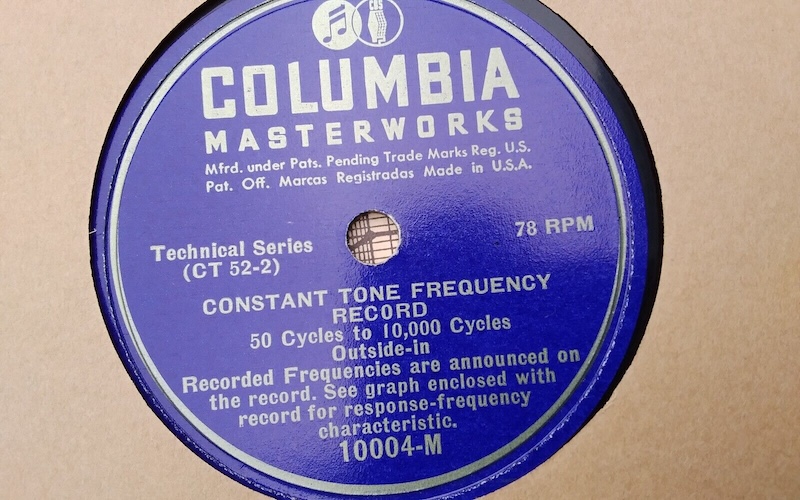
source: eBay listing by debbie6438 (retrieved: May 15, 2024).
同封されているグラフをみると、1kHz 以上が定速度フラット、それ以下は 1942 NAB 録音特性となっています。つまり、このディスクはターンオーバー 800Hz での記録(800N-FLAT)ではなく、500N-FLAT でもなく、1942 NAB 録音特性 (500B-16) の 1kHz より上の帯域を定速度フラットにしたもの、いわゆる 500B-FLAT のようです。Radio-Electronics 誌の記事と Audio Engineering 誌の記事の記載が間違っていた、ということでしょう。
The enclosed graph shows a constant velocity flat above 1kHz, and 1942 NAB Recording Characteristics below that. In other words, this disc is not cut with a turnover of 800Hz (800N-FLAT), nor is it a 500N-FLAT, but a 1942 NAB (500B-16) with the frequencies above 1kHz flattened to a constant velocity, so-called 500B-FLAT. So, I guess that the articles of Radio-Electronics and Audio Engineering magazines were incorrect.

source: eBay listing by debbie6438 (retrieved: May 15, 2024).
“The low frequency section from 50 to 1,000 cycles of the special test record follows the Transcription characteristic exactly. The high frequency section is flat.”
したがって、この Columbia 10004M における 500B-FLAT は、のちの RIAA 時代、JVC などの一連のテストレコードにおける 500R-FLAT と同様、高域プリエンファシスのみオフにしたカーブで記録されている、ということになります(Pt. 19 セクション 19.2.6 のコラム も参照)。
Consequently, Columbia 10004M was 500B-FLAT, cut with NAB curve except the high-frequency pre-emphasis turned off, as was the 500R-FLAT on a series of test records from the later RIAA era, such as JVC and others (see also: Pt. 19 Section 19.2.6 column).
もちろん、1kHz 以上がフラット記録されたテストレコードが大半の中、1949年当時に使われていたディスク録音特性 にあわせてカッティングされた盤もあります。
Of course, while most of the test records were recorded flat above 1kHz, some were cut to match the disc recording characteristics used in 1949.
例えば Columbia RD-130A は全周波数帯域で Columbia LP 特性(500C-16)、Clarkstan 100A は全周波数帯域で NAB 特性(500B-16)、London Gramophone 4996 / 4997 は全周波数帯域で 78回転用 ffrr 特性(300N-5.5)での記録、さらに Cook Series 10 の B-1 は 100Hz, 1kHz, 3kHz, 5kHz, 10kHz で「標準LP特性」(500B-16 または 500C-16)、となっています。
For example, Columbia RD-130A has Columbia LP characteristics (500C-16) over the entire frequency range; Clarkstan 100A has a NAB characteristics (500B-16) over the entire frequency range; London Grammophone 4996 / 4997 have ffrr (78) characteristics (300N-5.5) over the entire frequency range; and the track B-1 of Cook Series 10 has “Standard LP characteristcs” (500B-16 or 500C-16) at 100Hz, 1kHz, 3kHz, 5kHz and 10kHz.
当然ながら、これらは再生フォノEQと組み合わせたフォノカートリッジの再生特性のテストや微調整用に製造されたものだったのでしょう。
Naturally, these were arguably manufactured for testing and fine-tuning the reproducing characteristics of phono cartridges paired with reproducing phono EQs.
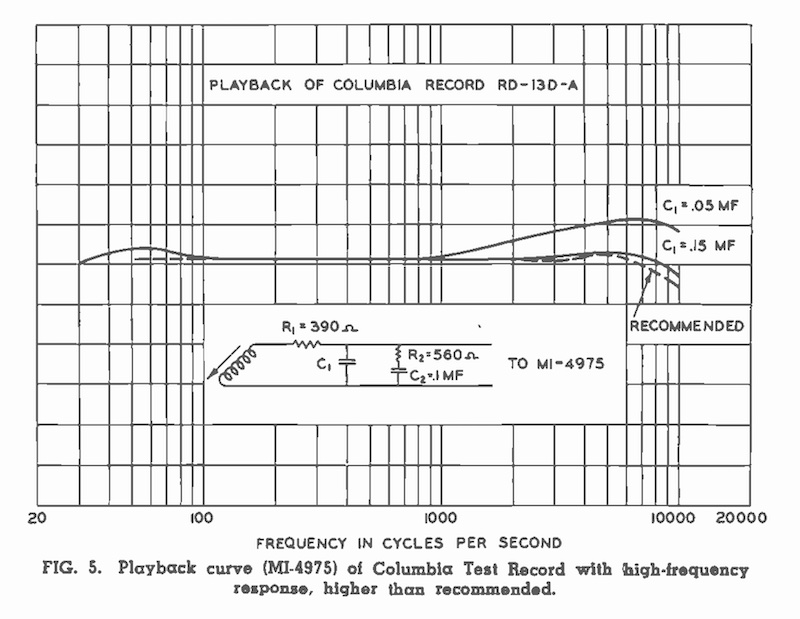
source: RCA Broadcast News, No.58, March-April, 1950, pp.4-6.
Pt. 12 セクション 12.2.5 でも紹介した、技術雑誌 RCA Broadast News の1950年3/4月号に登場する Columbia RD-130A
Columbia LP対応フォノEQ回路を(放送局用ターンテーブル用にすら)RCA Victor が用意できていなかった1950年春の記事で、NAB カーブ対応の RCA MI-4975 フォノイコの前段にどのような補正回路を追加すればフラット再生できるか、RD-130A テストレコードを使って実証した際の補正回路図と応答グラフ
なお、Cook Series 10 はユニークで、当初「A面78回転」「B面33⅓回転」「B-2 と B-3 はターンオーバー周波数 350Hz」でしたが、のちに Cook Series 10-LP という型番の「両面33⅓回転」「B-2 と B-3 はターンオーバー周波数 500Hz」に置き換わっていきました。いずれも、ANM (Anti-Noise Modulation) V-groove スタイラスのカッティングにより、2.5ml / 1mil のどちらの針でも再生可能と謳われていたようです。
The Cook Series 10 is unique in that it started out with “78rpm on Side-A”, “33⅓rpm on Side-B”, “Turnover frequency for tracks B-2 and B-3 set to 350Hz”; then the succeeding release, Cook Series 10-LP, is with “33⅓rpm on both sides”, “Turnover frequency for tracks B-2 and B-3 set to 500Hz”. Both records were claimed to be playable with either 2.5mil / 1mil needle, as they were cut with the ANM (Anti-Noise Modulation) V-groove precision stylus.

source: brochure of Cook Laboratories Test Records Series 10.
For more information, take a look at an excellent article at Preservation Sound website.
Cook Series 10 パンフレットに掲載された ANM V-groove の説明
その他 Cook テストレコードに関する貴重な情報は Preservation Sound の記事に詳しい
21.2.3 “TEST RECORDS for STEREO” by Chester Santon (Radio-Electronics, Mar. 1959)
次は、RIAA録音再生標準規格が策定されて5年後、ステレオLPが登場して1年後、Radio-Electronics 誌1959年3月号 に掲載された、「TEST RECORDS for STEREO」という1ページ記事です。
The following is a one-page article entitled “TEST RECORDS for STEREO”, which appeared in the Mar. 1959 issue of the Radio-ELectronics magazine. It was five years after the formulation of the RIAA Recording and Reproducing Standards, and one year after the stereo LP was introduced.
執筆者はニューヨークの WQXR ラジオ局のアナウンサー Chester Santon 氏で、当時同局で “Adventures in Sound” というコーナーを担当し、ステレオレコードやオープンリールステレオテープをかけていたそうです(New York Times 1993年11月25日号に掲載された追悼記事)。ですので、オーディオ工学の専門家ではなさそうです。
The writer is Chester Santon, an announcer at the WQXR radio station in NYC, who at that time had an “Adventures in Sound” segment on the station, playing stereo records and reel-to-reel stereo tapes (obituary in the New York Times, Nov. 25, 1993). So he does not seem to be an expert in audio engineering.
冒頭に紹介されているのは、Westrex 1-C Stereo Disk Test Record で、1957年11月に Westrex が 3,000枚ほど作った最初のテストレコード(恐らく 1-A)を置き換えるものと書かれています。0.5cm/s at 1kHz, 45°を基準レベルとして、50Hz〜10kHz のトーン信号が収録されているほか、多様なトーン信号が記録されている、とあります。RIAA 再生カーブでのテストを目的とした盤のようです。いろいろ調べてみましたが、この Westrex 1-C テストレコードに関するその他の情報は残念ながら見つけられませんでした。
The article introduces Westrex 1-C Stereo Disk Test Record, which is described as a replacement for the first Westrex test record (probably 1-A), of which Westrex made about 3,000 in Nov. 1957. The 1-C test record contains various tone signals, including 50Hz to 10kHz frequency tones, with 0.5cm/s at 1kHz, 45° reference level. It appears to be intended for testing with the RIAA playback curve. Unfortunately, I have not been able to find any other information on this Westrex 1-C test record.
続いて、London PS-131 が紹介されます(のちほど セクション 21.3.5 で現物を紹介します)。こちらも RIAA 再生カーブでのテストを目的とした盤で、1cm/s at 1kHz, 45° を基準レベルとしています。
Next, London PS-131 is introduced (to be shown later in Section 21.3.5). This also is designed to be tested with the RIAA playback curve, with 1cm/s at 1kHz, 45° as the reference level.
RCA Victor 12-5-71 が数ヶ月前から出回り出していることにも触れています。こちらは 1kHz〜20kHz のテストトーンを収録しており、定速度フラットでカッティングされている、と書かれています。この記事では「これは RCA が元々開発した RIAA カーブを捨てて独自カーブに進むということを意味するのか?」と頓珍漢なことが書かれています(笑)が、当然ながら、計測目的のテストレコードですから、1kHz 以上がフラットなのは目的通りであり、それと RIAA 録音特性はなんの関係もありません。当該記事著者の理解不足と考えられます。
It also mentions that the RCA Victor 12-5-71 has been available for several months. It says that this particular disc contains test tones from 1kHz to 20kHz, cut at constant velocity flat. Interestingly, this article irrelevantly continues as: “If RCA, under the stress of stereo, has abandoned the RIAA curve which is originally sponsored, and interesting theory suggests itself” — of course, this is a test record for frequency measurement purposes, so flatness above 1kHz is exactly what is intended, and apparently has nothing to do with the RIAA recording characteristics. I believe this incorrect explanation may be due to the author’s lack of understanding.
続いて Components Corporation No.58 というテストレコードの説明が続きます(Components Corporation については、のちほど セクション 21.3.6 で説明します)。7インチLPで価格は1ドル、録音レベル 5cm/s の 1kHz が、両チャンネル、左チャンネル、右チャンネル、と記録されているだけとのことです。
Such ridiculous paragraph is followed by a description of yet another test record, Components Corporation No.58 (Components Corporation will be discussed later in Section 21.3.6), a 7-inch LP, priced at $1.00, and recorded at 1kHz at a recording level of 5cm/s, for both channels, for left channel only, and for right channel only. These are all the contents on this particular record.
最後に、このステレオLP最初期の記事において、「ステレオカートリッジによってチャンネルセパレーション(クロストーク)が 6〜8dB も差がある」「オープンリールステレオテープに比べて高域のチャンネルセパレーションが劣っている」「よって(ステレオLPは)『時期尚早だ』と言う人がいるのも理解できるだろう」と締めくくっています。
Finally, in this article of the early stereo LP years, the author mentions the “differences of 6 to 8 db in channel separation among stereo pickups”, and concludes that “channel separation is more serious problem (compared with stereo tapes)”, and “…you’ll understand why some observers have been saying, ‘It’s earlier than you think’.”
以上のような内容であり、当時出ていたステレオテストレコードを確認するのには役立ちますが、記載された内容の信憑性はあまり高くないと考えた方がよさそうです。
So, while this article is still useful to check the stereo test records that were available at the time, it should be noted that the credibility of the information provided here is not veyr high.
21.2.4 “A Short Guide to Test Records” by R.D. Durrell (High Fidelity, Dec. 1963)
次に紹介するのは、RIAA録音再生標準規格が策定されて9年後、ステレオLPが登場して5年後、High Fidelity 誌1963年12月号 に掲載された、「A Short Guide to Test Records」という記事です。執筆者はオーディオ評論家の R.D. Durrell 氏です(New York Times 1988年5月7日号に掲載された追悼記事)。
The next “Test Record List” is an article entitled “A Short Guide to Test Records”, appeared in the Dec. 1963 issue of the High Fidelity magazine. It was nine years after the formulation of the RIAA Recording and Reproducing Standards, and five year after the stereo LP was introduced. The author is an audio critic R.D. Durrell (obituary published in the May 7, 1988 issue of the New York Times).
この記事では、プロフェッショナルユースの「計測用テストレコード」よりも、セミプロ向け、オーディオマニア向けのテストレコードの方がが多く紹介されています。
This article presents more semi-professional and audiophile test records than professional “measurement test records”.
記事の書かれ方も、計測機器を使った厳密なチェックというよりは「聴感チェック」を前面に押し出しています。
The way the article is written also puts forward an “listening check” rather than a rigorous check using measuring instruments.
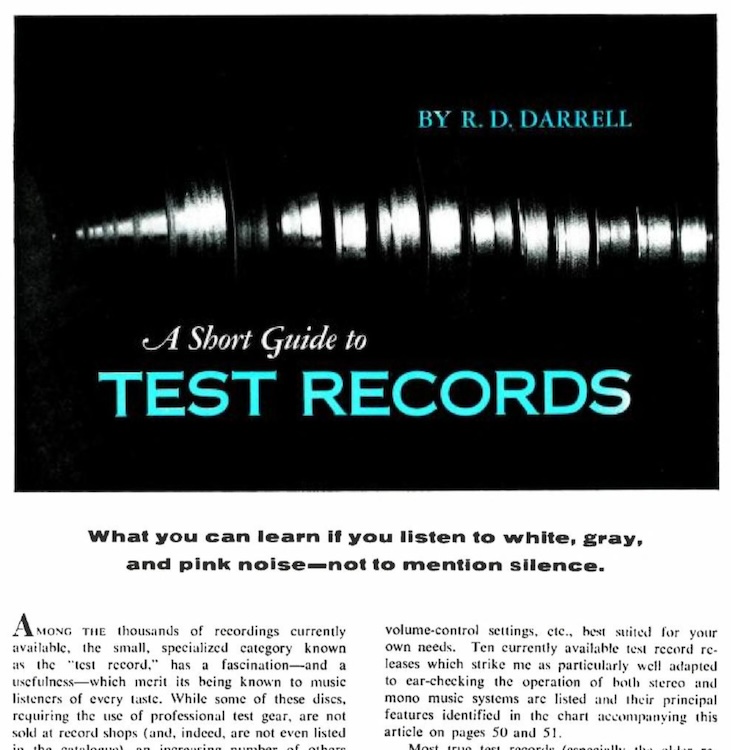
source: High Fidelity, Dec. 1963, pp.48-51, 118.
A really serious defect of course demands professional servicing, and these records are not intended to supplant the audio specialist with his meters and oscilloscopes. However, a home checkup often serves to reveal symptoms of audio ills — from incorrectly phased speakers to a worn stylus — and sometimes permits curing minor ailments. At the very least, the use of test records can alert the owner to the need for professional servicing.
本当に深刻な欠陥はもちろん、専門家による修理が必要である。これらテストレコードは、メータやオシロスコープを持つオーディオ専門家にとって変わるものとして意図されたものではない。しかし、家庭でのチェックを行うことは、位相の合わないスピーカから摩耗した再生針に至るまで、オーディオ機器の不適切なセッティングの兆候を明らかにするのに役立ち、軽度の不具合の修正につながることもある。少なくとも、テストレコードを使用することで、(オーディオ機器)所有者に対し、オーディオ専門家による修理が必要であると警告できる。
Aside from these functions, test records can also serve as guides in setting up a new system, in matching a new component to an existing system, and in determining the speaker locations, pickup-arm adjustments, tone- and volume-control settings, etc., best suited for your own needs.
これら以外にもテストレコードは、新しくシステムをセットアップする際や、新しいコンポーネントを既存のシステムに追加する場合、またスピーカの位置やトーンアームの調整、トーンコントロールやボリュームコントロールの設定など、それぞれのニーズに最適なセッティングを決定する際のガイドとして役立つ。
Ten currently available test record releases which strike me as particularly well adapted to ear-checking the operation of both stereo and mono music systems arc listed and their principal features identified in the chart accompanying this article on pages 50 and 51.
現在入手可能なテストレコードのうち、ステレオとモノーラルの両システムの動作を耳でチェックするのに特に適していると筆者が考える10枚を、本記事中50ページと51ページの表に列挙し、それぞれの主な特徴を記載してある。
“A Short Guide to Test Records”, by R.D. Darrell, High Fidelity, December 1963, p. 48.この記事で紹介されているテストレコードは、以下の10タイトルです。
The test records featured in this article are the following 10 titles:
| Label | Cat. No. | Title |
|---|---|---|
| Audio Fidelity | FCS 50000 | Stereo Test Record RIAA, except A-4 (1kHz〜) with constant velocity and A-5 (〜1kHz) with constant amplitude |
| CBS Laboratories | STR 100 | Stereophonic Frequency Test 500N-FLAT |
| CBS Laboratories | STR 140 | Professional Test Record – RIAA Pink Noise Acoustical Test RIAA |
| Command | CSC 100 | Stereo Check Out RIAA |
| Components / Lafayette | PR-14 | Lafayette Hi-Fi Test Record Stereo-Monaural RIAA |
| Concert-Disc | PTX 10 | PROFESSIONAL test RECORD RIAA |
| Cook Labs | Series 60 | Chromatic Scale Test Record RIAA, but with Fletcher-Munson compensation on Side-A |
| Vanguard | VSD 100 | Vanguard Stereolab Test Record RIAA |
| Westminster | SRX | A Comprehensive Tool For Testing Equipment RIAA |
| Ziff-Davis HiFi/Stereo Review |
Model 211 | Stereo Test Record For Home and Laboratory Use RIAA |
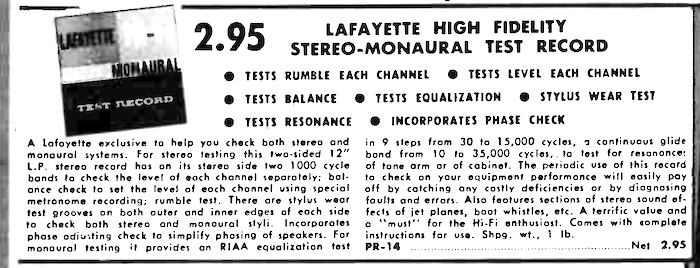
source: Lafayette Catalog 1960, p.7.
1960年 Lafayette 社の総合カタログに掲載された PR-14 テストレコードの広告
これらの10タイトルの中には、片面がテスト目的、もう片面が音楽が収録されたデモンストレーション目的、というものもあります(Audio Fidelity、Command、Westminster、Ziff-Davis)。
Some of these 10 titles are for testing purpose on one side and for demonstration purposes with music recorded on the other side (i.e. Audio Fidelity, Command, Westminster, Ziff-Davis).
また、一部を除き、ほとんどのテストレコードが RIAA 録音特性 でカッティングされています。
With a few exceptions, most of these test records were cut with the RIAA recording characteristics.
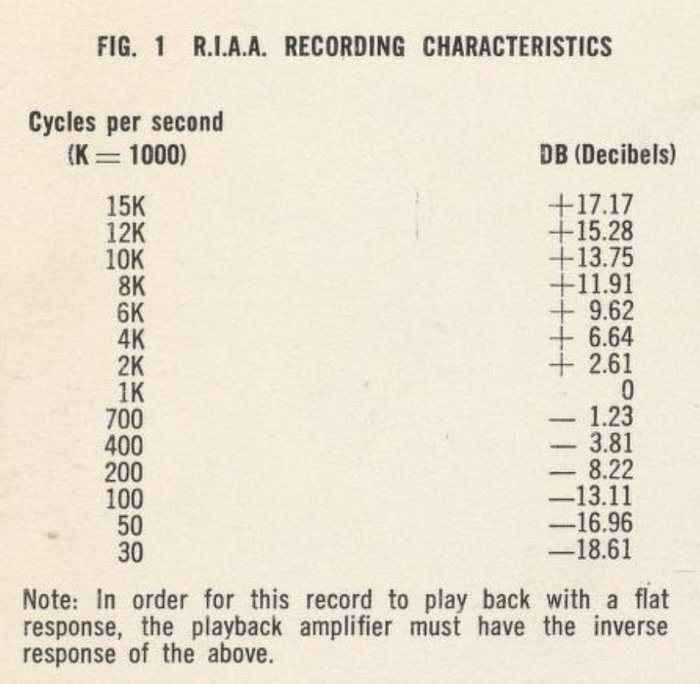
source: Vanguard Stereolab Test Record (Vanguard VSD-100), archived at Internet Archive.
Vanguard VSD-100 のジャケ裏解説より、本盤は RIAA で再生すること、と指示する箇所
当該記事における数少ない例外の1枚である Audio Fidelity FCS 50000 は、A面のトラック4 “High-frequency sine-wave tone tests” は、RIAA のプリエンファシスなしで、1kHz およびそれ以上のトーン(5cm/s)が収録されています。一方、続くA面トラック5 “Low-frequency sine-wave tone tests” は、RIAA 規格に則って、1kHz およびそれ以下のトーンが収録されています。つまり、この両トラックについては、プロフェッショナル向け計測テストレコードと同様に 500R-FLAT で収録されていることになります。
One of the few exception in this article, Audio Fidelity FCS 50000, track A-4 “High-frequency sine-wave tone tests” contains test tones at 1kHz (5cm/s) and above without RIAA pre-emphasis. On the other hand, track A-5 “Low-frequency sine-wave tone tests” contains test tones at 1kHz (5cm/s) and below, in accordance with the RIAA Recording Standards. In other words, both tracks are recorded with 500R-FLAT as in the professional measurement test records.
BAND 4: High-frequency sine-wave test-tones
These tones are recorded in phase in both channels at a constant stylus-velocity of 5 cm per second — that is without the standard RIAA pre-emphasis. Therefore, they should be played back “Flat” — without the corresponding RIAA de-emphasis — to give the correct impression of overall system frequency response above one thousand cycles.
A面トラック4: 高域サイン波テストトーン
これらのトーンは、左右チャンネル共に同位相で、5cm/s 等速度で記録されている。すなわち標準の RIAA プリエンファシス なし で記録されている。よって、本トラックは「フラット」に(つまり RIAA デエンファシス なしで)再生されなければならない。これによって、1kHz 以上の帯域におけるシステムの総合的な周波数応答を聞き取ることができる。
BAND 5: Low-frequency sine-wave test-tones
These tones are recorded at levels varying (from 5 cm per second at 1000 cycles) downward according to the RIAA curve. Consequently, they should be played back with RIAA equalization to check the low-frequency end of the system.
A面トラック5: 低域サイン波テストトーン
これらのトーンは、1kHz で 5cm/s に始まり、RIAA カーブに従って低周波帯域に向かって記録されている。すなわち、システムの低域チェックを行うには、本トラックは RIAA イコライゼーション あり で再生されなければならない。
また、プロフェッショナル用途の CBS Labobarories STR-100 は、周波数応答計測用の A-1, A-2 を含め、多くのトラックが 500N-FLAT(400Hz〜500Hz は定振幅、500Hz〜20kHz は定速度)で収録されています。
In addition, many tracks of the CBS Laboratories STR-100 (for professional use) are recorded with 500N-FLAT (constant amplitude from 400Hz to 500Hz, constant velocity from 500Hz to 20kHz), including A-1 and A-2 for frequency response measurements.
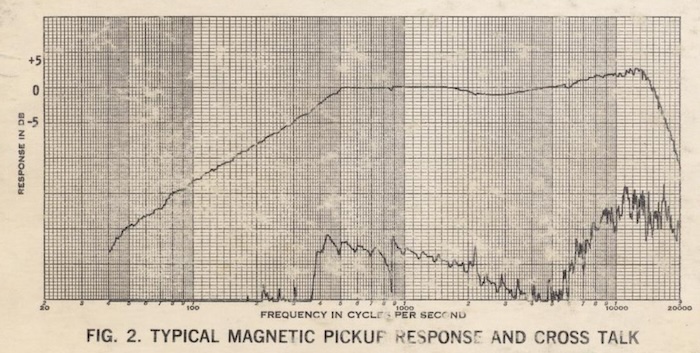
source: Stereophonic Frequency Test Record (Issue 1) (CBS Labs STR-100), archived at Internet Archive.
CBS Labs STR-100 のジャケットに掲載された、マグネットカートリッジを使いイコライズなしで再生した場合の応答曲線とクロストーク特性
CBS Labs STR-100 のリリースは1961年ないし1962年で、General Radio Type 1521-A グラフィックレベルレコーダと組み合わせて使用する前提で制作されたものでした。1961年秋のAESコンヴェンションでお披露目されたのが最初のようです。
The CBS Labs STR-100 was released in 1961 or 1962, and was designed to be used with the Genral Radio Type 1521-A graphic level recorder. It was first unveiled at the AES Convention in the fall of 1961.
CBS Labs 社のエンジニア4名によって執筆された、Audio誌1962年2月号 pp.18-22 の記事「Test Record for Evaluating Stereophonic Systems」では、STR-100 と General Radio Type 1521-A グラフィックレベルレコーダを使って、周波数応答とクロストークのプロットを自動化する仕組みについて解説されています。上に載せたグラフもこの組み合わせでプロットされたものです。
The article “Test Record for Evaluating Stereophonic Systems” in the Feb. 1962 issue of Audio magazine, pp. 18-22, written by four engineers from CBS Labs, describes how the STR-100 and General Radio Type 1521-A graphic level recorder are used to automate the plotting of frequency response and crosstalk. The graph posted just above was also plotted using this combination.
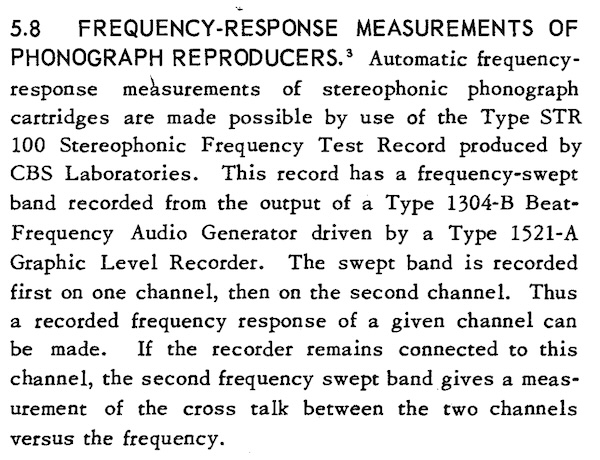
source: General Radio Type 1521-B Graphic Level Recorder Instruction Manual, p.28.
1521-B 取説にも、CBS Labs STR-100 テストレコードを使い周波数応答計測する、という使用例が記されている
また、General Radio 社が毎月発行していた General Radio Experimenter誌、その1962年1/2月号 pp.15-21 にも、CBS Labs 副代表の B.B. Bauer 氏による解説記事「Automatic Measurement of Phonograph Reproducers」が掲載されています。
Also, Jan./Feb. 1962 issue of the General Radio Experimenter (a monthly magazine published by General Radio), pp. 15-21, carried an article entitled “Automatic Measurement of Phonograph Reproducers”, authored by B.B. Bauer, Vice President of CBS Labs.
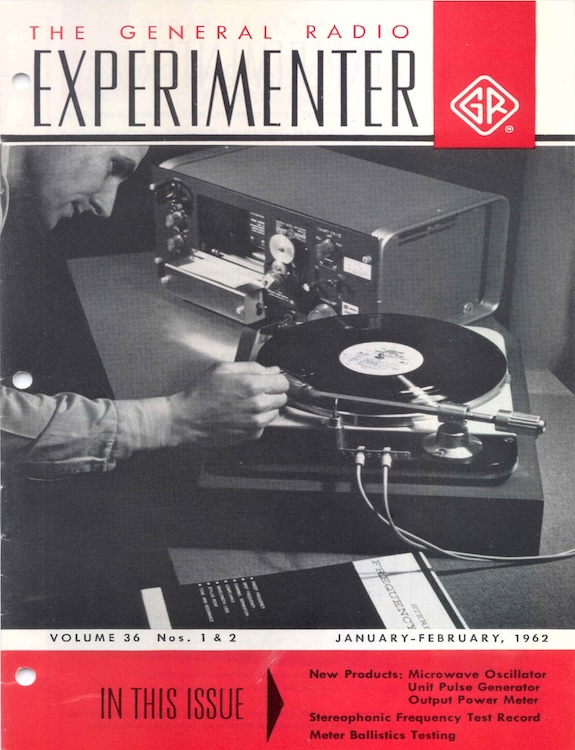
source: The General Radio Experimenter, Vol. 36, Nos. 1 & 2, Jan./Feb. 1962
当該号表紙には、General Radio 1521-A グラフィックレベルレコーダを使い、CBS Labs STR-100 テストレコードを計測する様子が捉えられている
両記事には、STR-100 の A-1 と A-2 の冒頭 1kHz 基準トーンでレベル合わせをし、周波数応答グラフと共にクロストークのグラフもあわせてプロットする、CBS Labs 開発の自動化回路が掲載されています。これにより、フォノカートリッジの特性計測が格段に楽になったのでしょう。
Both articles describe an automated circuit developed by CBS Labs that level-matches the STR-100’s tracks A-1 and A-2 with a 1kHz reference tone at the beginning of each track, and plots a frequency response graph and crosstalk graph as well. Thsi must have made it much easier to measure the characteristics of phono cartridges.
これら FCS-50000 と STR-100 の2種は、計測機器を使った正確な測定ができるテストレコード、ということになりますが、一方で面白いのが Cook Labs Series 60 で、B面(RIAAカーブ)と同一内容がA面に収録されているのですが、なんと Fletcher-Munson ラウドネス補正をかけて収録しています。つまり、全帯域で聴感上同一レベルと感じられるように補正をかけているということです。
These two records, FCS-50000 and STR-100, are test records that can be accurately measured using measurement equipment. On the other hand, Cook Labs Series 60 is very interesting: both sides have the same content, but Side-A is cut with Fletcher-Munson loudness compensation! In other words, Side-A can be checked by human ears, so that listeners perceive a constant loudness.
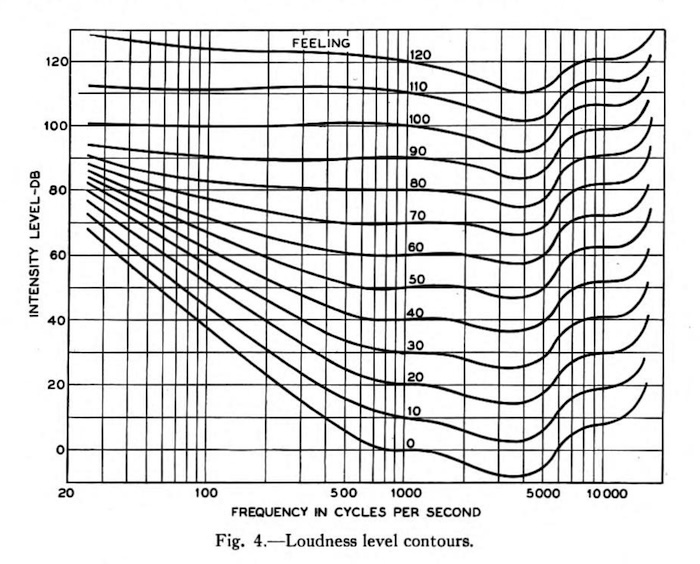
source: “Loudness, Its Definition, Measurement and Calculation”, Harvey Fletcher and Wilden A. Munson, The Bell System Technical Journal, Oct. 1933, pp.377-430.
Fletcher-Munson 曲線(等ラウドネス曲線)のオリジナル論文に掲載されたグラフ
このように、High Fidelity 誌1963年12月号の当該記事で紹介された10枚のテストレコードのほとんどは、カートリッジの特性テストなど、ある特定のコンポーネントを厳密にチェックする目的ではなく、むしろセットアップされたシステム全体に対するカジュアルな聴感テストを目的としていることになります。
As seen above, most of these ten test records presented in the High Fidelity Dec. 1963 article were not intended as rigorous checks of any one particular component, such as cartridge’s frequency response tests, but rather as casual listening tests on the entire set-up system.
よって、当時の業界標準である RIAA カーブでカッティングされた盤が大半である、ということになります。
Therefore, most of them were cut with the RIAA curve, which was the industry standard at that time (and still is now).
21.2.5 “Test Records” by Arnold Schwartz (db, Apr. 1969)
さらに時代が進んで1969年、放送局エンジニアやスタジオエンジニア向けの専門誌 db 誌1969年4月号 に、その名もずばり「Test Records」という記事が掲載されています。
Then the Apr. 1969 issue of db, a magazine for broadcast / studio engineers, published an article simply entitled “Test Records”.
筆者は Arnold Schwartz 氏、CBS Laboratories 所属時代には同社の 一連のテストレコード 制作に関わっていた人物で、本記事執筆時にはカッティング針メーカの Micro-Point Inc. 社長でした。
The author is Arnold Schwartz, who was involved in the production of a series of CBS Labs test records when he was working there, and at the time of this writing was president of Micro-Point Inc., manufactuer of recording styli.
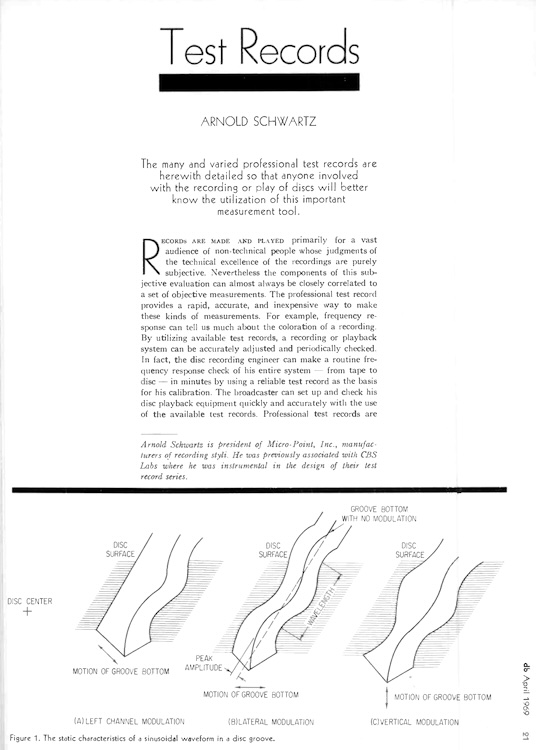
source: db magazine, Vol. 3, No. 4, Apr. 1969, pp.21-24.
この記事では、数あるテストレコードの中から、db 誌読者層である放送局/スタジオエンジニア向けに、RCA Victor、CBS Labs、NAB のテストレコードのみに絞って解説されています。
This article focuscs on only the test records of RCA Victor and CBS Labs, as well as NAB test record, for the broadcast / studio engineers who are the primary audience for the db magazine.
「標準基準レベル」「周波数応答」「クロストーク」「トラッキング性能」「ターンテーブル性能」「位相とバランス」をそれぞれチェックするにはどのレコードを使えば良いか、計測用テストレコードの詳細について非常に分かりやすく説明されており、必読です。
This article is a must-read, with very clear explanation of which records to used to check each of “standard reference level”, “frequency response”, “crosstalk”, “tracking performance”, “turntable performance” and “phase and balance”, as well as details of each test records.
| Label | Cat. No. | Title |
|---|---|---|
| CBS Laboratories | STR 100 | Stereophonic Frequency Test Record |
| CBS Laboratories | STR 111 | Square Wave, Tracking and Intermodulation Tests |
| CBS Laboratories | STR 130 | RIAA System Response Test Record |
| CBS Laboratories | BTR 150 | Broadcast Test Record |
| NAB | 12-5-98 | NAB Test Record (33⅓rpm 12-inch) |
| RCA Victor | 12-5-37 | Intermodulation Test Record (45rpm 7-inch) |
| RCA Victor | 12-5-39 | Intermodulation Test Record (78rpm 12-inch) |
| RCA Victor | 12-5-49 | “New Orthophonic” Frequency Test Record (33⅓rpm 10-inch) |
| RCA Victor | 12-5-50 | Lateral Frequency Record (33⅓rpm 12-inch) |
| RCA Victor | 12-5-51 | “New Orthophonic” Frequency Test Record (45rpm 7-inch) |
| RCA Victor | 12-5-65 | Wow and Rumble Test Record |
| RCA Victor | 12-5-67 | Banded Frequency Record (78rpm 12-inch) |
| RCA Victor | 12-5-71 | 45/45 Stereo Banded Frequency Record (78rpm 12-inch) |
| RCA Victor | 12-5-73 | Channel Separation Test Record (33⅓rpm 12-inch) |
| RCA Victor | 12-5-75 | Vertical Frequency Test Record (33⅓rpm 10-inch) |
| RCA Victor | 12-5-77 | Stereo Balance / Level / Phase Test Record (33⅓rpm 10-inch) |
これらプロフェッショナル用計測用テストレコードのうち、録音再生特性のチェック専用の盤は、CBS Labs STR 130、RCA Victor 12-5-49 / 12-5-50 / 12-5-51 となります。
Among these test records for professional measurement, CBS Labs STR-130, RCA Victor 12-5-49 / 12-5-50 / 12-5-51 are used exclusively for checking recording and playback characteristics.
CBS Labs BTR 150 の A-4 “Spot Frequencies, 50-16,000 cps, -14 db re 5 cm, per sec, rms at 1kc” や、NAB 12-5-98 の A-3 “Frequency Response. 14 Db Below NAB Reference Level.” も、録音再生特性チェック用に用意されたスイープ音のトラックです。
Track A-4 “Spot Frequencies, 50-16,000 cps, -14 db re 5cm, per sec, rms at 1kc” in CBS Labs BTR-150, as well as track A-3 “Frequency Response. 14 Db Below NAB Reference Level.”, are also sweep tones provided for checking recording and reproducing characteristics.
当然ながら、全て RIAA カーブ(= 1964 NAB カーブ)での記録です。
As is obvious, these are all cut with the RIAA (= 1964 NAB) curve.
CBS Labs STR 130 は、Columbia / CBS の標準録音レベル 5cm/s at 1kHz(3.54cm/s at 1kHz, 45°)に対して -14dB のレベルで、40Hz〜20kHz のスイープ信号が記録されています。これは上述の通り、低いレベルでないと、RIAAカーブなどプリエンファシスありで高域のカッティング / 再生がうまく行えないため、全体のレベルを下げているわけです。
The CBS Labs STR-130 record contains a sweep signal from 40Hz to 20kHz at a level of -14dB relative to the standard Columbia / CBS recording level of 5cm/s at 1kHz (3.54cm/s at 1kHz, 45°). This is because, as previously mentioned, the overall level has to be lowered to allow for good high-frequency cutting/reproduction with pre-emphasis, such as RIAA.
一方、放送局用に制作された CBS Labs BTR 150 のトラック A-4 は、同じく標準録音レベル 5cm/s at 1kHz に対して -14dB のレベルで、50Hz〜16kHz のスイープ信号が記録されています。周波数帯域は異なるものの、同様の収録となっています。
On the other hand, track A-4 of CBS Labs BTR-150, which was produced for broadcast use, also contains a sweep signal from 50Hz to 16kHz at a level of -14dB relative to the standard level of 5cm/s at 1kHz. Although the frequency range is different, BTR-150 carries a similar sweep tone as STR-130.
同じく放送局用の NAB Test Record は、1964年 NAB 規格で定められた標準基準録音レベル(ASA Standard C16.5 1961 と同一)である 7cm/s at 1kHz(ステレオ片チャンネル換算では 5cm/s at 1kHz, 45°)に対して、やはり -14dB のレベルで 15kHz〜30Hz の23信号が記録されています。このレコードは、1964年3月に策定された NAB 録音再生標準規格にあわせてリリースされたもので、当然ながらこの NAB 規格における録音再生特性は、RIAA のそれと同一定義です。
The NAB Test Record, also for broadcast stations, recorded 23 signals from 15kHz to 30Hz at a level of -14dB, compared to the standard reference recording level of 7cm/s at 1kHz (equivalent to 5cm/s at 1kHz, 45°, for stereo single channel), which is the same as the standard level specified in the 1964 NAB Standards (also the same as ASA Standard C16.5 1961). This record was released in accordance with the NAB Recording and Reproducing Standards established in March 1964, and of course the recording / reproducing characteristics in the NAB Standards are the same as those defined by the RIAA.
RCA Victor 12-5-49 / 12-5-50 / 12-5-51 は、のちほど セクション 21.3.2 で紹介する通り、1952年暮れ〜1953年初頭に初めてリリースされた、New Orthophonic 特性(= RIAA 録音特性)で記録されたテストレコードです。この盤では RCA の標準録音レベル 5.5cm/s at 1kHz に対して 15kHz〜10kHz は -20dB で、10kHz〜30Hz は -14dB で、それぞれスポット信号が記録されています。
RCA Victor 12-5-49 / 12-5-50 / 12-5-51 are test records cut with New Orthophonic characteristics (= RIAA recording characteristics), which were first released between late 1952 and 1953, as is described later in Section 21.3.2. In these records, spot tones are cut at -20dB from 15kHz to 10kHz, and at -14dB from 10kHz to 30Hz, compared to the standard RCA recording level of 5.5cm/s at 1kHz.
再生用フォノEQを含めた再生環境の周波数帯域テストのために、これら RIAA / NAB (1964) 特性でスイープ信号やスポット信号が記録されたテストレコードが存在し、スタジオでの試聴環境用、放送局の再生機器用、オーディオマニア向け再生機器用、などに使用されていたわけです。
Such test records — with a sweep tone and/or spot tones cut with RIAA / NAB (1964) characteristcs — existed for frequency response tests of playback environments, including phono EQ for playback, and were used for studio listening environments, for playback equipment at broadcast stations, and for audiophile playback equipment, etc.
NAB Test Record (1964) は、放送局のみならず、米国内の多くのマスタリングスタジオでも実質的なリファレンステストレコードとして使われていたことが知られています。この NAB Test Record の制作は RCA Victor が行いました。
It is known that The NAB Test Record (1964) had been a “de facto standard” reference test record, not only at broadcast studios but also at most mastering studios in the U.S. This NAB Test Record was manufactured by RCA Victor.
The standard reference for cutting in the US is the vintage NAB test record. The one side took 14 tries (based on the matrix number) by the best engineers at RCA since making proper test materials is very difficult.
米国でのカッティングの基準となるリファレンスレコードは、ヴィンテージの NAB Test Record だ。適切なテスト素材の制作は非常に困難を極めるもので、RCA の当時の最高のエンジニアが片面につき(マトリクス番号から推察すると)14回の試行錯誤の末に完成させたものだ。
quoted from the email from Nicholas Bergh, on April 3, 2024さらに、Gotham Audio の社長 Stephen F. Temmer 氏がが1966年に配布したドキュメント「Trouble Shooting in Disk Cutting Systems」でも、業界標準として使われてきた RCA Victor 12-5-49 に代わり、今後は「もはや全カッティングルームに装備されていると言っていい」NAB Test Record をリファレンスとして使うことを推奨する記載が見られます。
Furthermore, the document “Trouble Shooting in Disk Cutting Systems” distributed in 1966 by Stephen F. Temmer, president of Gotham Audio, recommends the use of the NAB Test Record as a reference, replacing RCA Victor 12-5-49, which had been used as the industry standard.
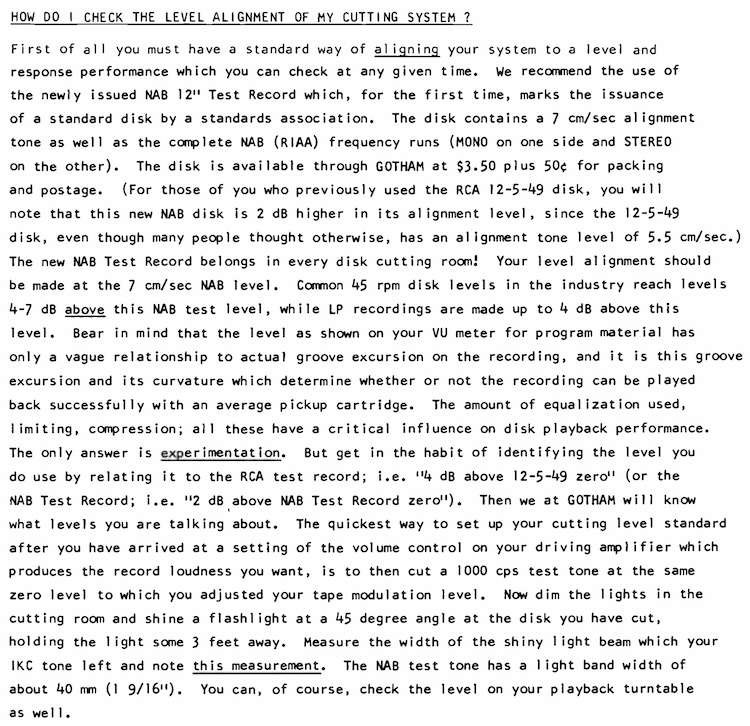
excerpt from “Trouble Shooting in Disk Cutting Systems” by Stephen F. Temmer.
source: Gotham Audio 1966 Brochure.
長らく業界標準の RCA Victor 12-5-49 に代わり、今後はカッティング時には NAB Test Record をリファレンスにすべし、と記載がある
21.2.6 “Test Discs” by Hugh Ford (Studio Sound, Feb. 1975)
最後に、プロフェッショナルスタジオエンジニア向けに英国で発行されていた Studio Sound 誌1975年2月号に掲載された「Test Discs」です。当時入手可能だった多種多様なプロフェッショナルユースのテストレコードが大量にリストアップされており、その収録内容や使用目的が簡潔にまとめられています。
Finally, here’s the article “Test Discs”, which appeared in the Feb. 1975 issue of Studio Sound magazine, a British publication for professional studio engineers. It lists a large number and variety of test records for professional use that were available at the time, and also briefly summarizes their recorded content and purpose of use.
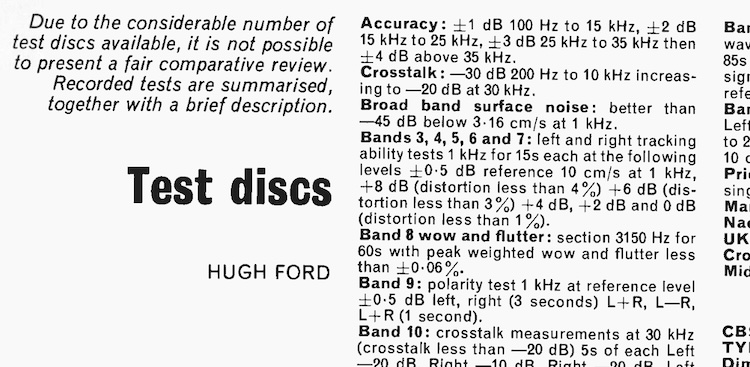
source: Studio Sound, Vol. 17, No. 2, Feb. 1975, pp.38-44.
執筆者は元EMIエンジニアの Hugh Ford氏です(AES論文誌1987年7/8月号に掲載された追悼記事)。英国の雑誌であることから、米国製のみならず英国・欧州のテストレコードも多数掲載されています。
The author is a former EMI engineer Hugh Ford (obituary in the Jul./Aug. 1987 issue of the Journal of the Audio Engineering Society). Being a British magazine, this article features many test records not only from the U.S. but also from the U.K. and Europe.
今までみてきたものと同様、その多くが、1kHz 以上は定速度(特定の録音カーブから高域プリエンファシスを抜いたもの)のパターンか、特定の録音カーブそのものでの収録となっています。
As with those we have seen so far, most of them are either “constant velocity above 1kHz” (i.e. without high-frequency pre-emphasis from a specific recording curve) or a specific recording curve itself.
興味深いのは後者で使われる録音カーブで、「RIAA standard」「IEC standard」「B.S.1928:1955」「B.S.1928:1960」「DIN 45 536/546/547」の表記が登場します。
It is interesting to note that the recording curves used in the latter case appear as either of: “RIAA Standard”, “IEC Standard”, “B.S. 1928:1955”, “B.S. 1928:1960” and “DIN 45 536/546/547”.
「IEC standard」は、もしや、時定数7950μsを追加した、サブソニック/ランブル対策の RIAA-IEC 再生カーブ(1976年策定)のことか?!と一瞬思ってしまいましたが(笑)、本記事は1975年2月号発行ですので、「RIAA standard」と「IEC standard」は同一、単なる表記の違いだけということでしょう。「B.S.1928:1955」「B.S.1928:1960」「DIN 45 536/546/547」は言わずもがな。
I wondered for a moment if “IEC standard” referred to the RIAA-IEC playback curve (established in 1976), which added a time constant of 7,950μs to prevent subsonic/rambling 🙂 However, since this article was published in the Feb. 1975 issue, it is clear that “RIAA Standard” and “IEC Standard” are identical — just a difference in notation. It goes without saying that it also applies to “B.S. 1928:1955”, “B.S. 1928:1960” and “DIN 45 536/546/547”.
以下、当該記事でリストアップされているテストレコードを、可能な限り Discogs で特定してみました。
Below, I have tried to identify all the test records in Discogs as many as possible.
まずは、デンマークの高精度計測器メーカである Brüel & Kjær のテストレコードから。
The list starts with the test records of Brüel & Kjær, a Danish manufacturer of high-precision measuring instruments.
QR 2009 と QR 2010 の2枚は 500R-FLAT、QR 2011 は 500R-13.7 (RIAA) での収録となっています。
QR-2009 and QR-2010 are cut with 500R-FLAT, while QR-2011 is recorded with 500R-13.7 (RIAA).
録音レベルは、QR 2009 が 3.16cm/s at 1kHz(2.24cm/s at 1kHz, 45°)、QR 2010 が 10cm/s at 1kHz とレーベル上に記載があります。QR 2011 はピンクノイズ収録なので、基準信号がなく、録音レベルの記載もありません。
Recorded level are listed on the label as 3.16cm/s at 1kHz (2.24cm/s at 1kHz, 45°) for QR-2009, and 10cm/s at 1kHz for QR-2010. No recording level is specified for QR-2011, because this record contains pink noise (thus no reference signal).
| Cat. No. | Title & Contents |
|---|---|
| Brüel & Kjær | |
| QR 2009 | Stereophonic gliding frequency recording 45rpm 12-inch IEC standard without treble pre-emphasis (constant velocity above 1kHz) |
| QR 2010 | Comprehensive laboratory disc 33⅓rpm 12-inch IEC standard without treble pre-emphasis (constant velocity above 1kHz) |
| QR 2011 | for testing and adjustment of hi-fi systems with pink noise 33⅓rpm 12-inch IEC standard (=RIAA) |
これら3枚のテストレコード、および計測ユニット Brüel & Kjær 4416 のマニュアルがオンラインで閲覧できます。
A Manual for these three test records as well as the dedicated response test unit Brüel & Kjær 4416 is available online.
続いて CBS Laboratories です。上でも紹介してきたテストレコードも含め、網羅されています。
Next, the list of test records of CBS Laboratories. It covers many titles, including the ones we’ve already seen above.
STR-120 は、A面は 500Hz〜50kHzを定速度フラットに、B面は10Hz〜500Hzを定振幅フラットに収録、とありますので、両面を通して 500N-FLAT での収録、ということができるでしょう。
Side-A of STR-120 contains 500Hz〜50kHz test tones cut with constant velocity; Side-B’s 10Hz〜500Hz test tones with constant amplitude. So this particular record is cut with 500N-FLAT as a whole.
| CBS Laboratories | |
|---|---|
| BTR 150 | Broadcast test record 33⅓rpm 12-inch RIAA (= 1964 NAB) |
| STR 100 | Stereophonic frequency test record 33⅓rpm 12-inch (500N-FLAT) |
| STR 101 | Seven steps to better listening 33⅓rpm 12-inch (RIAA) |
| STR 111 | Square wave, tracking and intermodulation test record 33⅓rpm 12-inch (RIAA) |
| STR 120 | Wide range pickup response test record 33⅓rpm 12-inch Side-A: 500Hz〜50kHz, constant velocity (FLAT) Side-B: 10Hz〜500Hz, constant amplitude (500N) |
| STR 130 | RIAA Frequency response test record 33⅓rpm 12-inch RIAA |
| STR 140 | RIAA pink noise acoustical test record 33⅓rpm 12-inch RIAA |
| SQT 1100 | SQ (System Quadraphonic) test record 33⅓rpm 12-inch RIAA |
続いて 英Decca ですが、有名な SXL 2057 1枚のみが掲載されています。
Next is UK Decca — only one test record, the famous SXL 2057, is listed.
記録レベルは 1cm/s at 1kHz, 45°で、全周波数帯域が B.S.1928:1955 すなわち RIAA と同一特性で記録されています。
Recorded level is 1cm/s at 1kHz, 45°, and the entire frequency range is cut with B.S. 1928:1955 Standard, which is identical to the RIAA Characteristics.
| Decca | |
|---|---|
| SXL 2057 | Stereophonic frequency response test disc 33⅓rpm 12-inch B.S. 1928:1955 (=RIAA) |
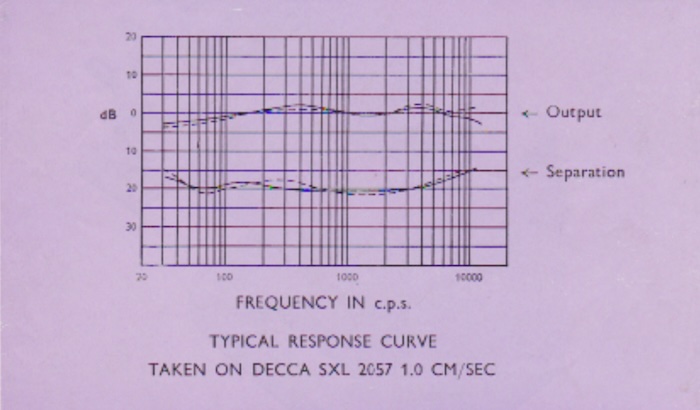
source: “BSR (Monarch) Ceramic Cartridge Type C1 Technical Data”.
BSR C1 セラミックカートリッジで Decca SXL 2057 を再生した場合の周波数応答特性グラフ
圧巻は Deutsche Grammophon Gesellschaft で、大量のテストレコードの存在を初めて知りました。
The highlist is a long list of Deutsche Grammophon Gesellschaft — I never knew that Grammophon had released such a large number of test records.
録音特性として DIN 45 536(45rpm モノーラル)、DIN 45 546(45rpm ステレオ)、DIN 45 547(33⅓rpm ステレオ)とありますが、時定数は全てに共通して 3,180μs / 318μs / 75μs であり、RIAA と同一です。
Recording characteristics used for these test records are: DIN 45 536 (for 45rpm monaural), DIN 45 546 (for 45rpm stereo) and DIN 45 547 (for 33⅓rpm stereo), all of which have the same time constants of 3,180μs, 318μs and 75μs. Thus, these are all the same characteristics as RIAA.
| Deutsche Grammophon Gesellschaft | |
|---|---|
| 1001 941 | testing and adjustment of turntables 45rpm 7-inch (unknown) |
| 1001 942 | measuring wow and flutter using the Tonhöhenschwankungsmesser J60 45rpm 7-inch (unknown) |
| 101 944 | measuring wow and flutter using the EMT 418 45rpm 7-inch (unknown) |
| 101 495 | Schallplatte zur prüfung von stereo wiedergabegeräten 45rpm 170mm 7-inch DIN 45 536 (3180-318-75μs) (=RIAA) |
| 101 496 | Disque de contrôle pour appareils stéréophoniques same as 101 495, text in French |
| 101 497 | setting up stereo equipment same as 101 495, text in English |
| 1099 008 | measuring wow and flutter using Tonhöhenschwankungsmesser J60 33⅓rpm 12-inch (unknown) |
| 1099 010 | measuring wow and flutter using the EMT 418 33⅓rpm 12-inch (unknown) |
| 1099 011 | Mess-Schallplatte für Intermodulationsverzerrungen 45 U/m 45rpm 12-inch DIN 45 546 (3180-318-75μs) (=RIAA) |
| 1099 014 | Demonstrations-Schallplatte für die Hörbarkeit linearer verzerrungen 33⅓rpm 12-inch DIN 45 547 (3180-318-75μs) (=RIAA) |
| 1099 015 | Hörbarkeit nichtlinearer Verzerrungen 33⅓rpm 12-inch DIN 45 547 (3180-318-75μs) (=RIAA) |
| 1099 103 | Pegel-Messplatte für mono und stereo (1000Hz Vollaussteuerung) 33⅓rpm (Side-A) / 45rpm (Side-B) 12-inch FLAT |
| 1099 106 | Frequenz-Mess-Schallplatte: frequenzgang nach DIN 45 547 33⅓rpm 12-inch DIN 45 547 (3180-318-75μs) (=RIAA) |
| 1099 108 | Differenzton-Verzerrungsmessplatte 33⅓rpm 12-inch (unknown) |
| 1099 109 | Wobbelfrequenz-Mess-Schallplatte 45rpm 12-inch (unknown) |
| 1099 111 | Differenzton-Verzerrungsmessplatte 33⅓rpm 12-inch (unknown) |
| 1099 112 | Frequency measurement test disc 33⅓rpm 12-inch DIN 45 547 (3180-318-75μs) (=RIAA) |
| 1641 001 | Hi-Fi stereo test disc 33⅓rpm 12-inch DIN 45 547 (3180-318-75μs) (=RIAA) |
英EMI は 7枚が掲載されていますが、垂直変調(縦振動)専用のテストレコード TCS-105 が用意されていることに驚かされます。すべての盤で記録特性は B.S.1928:1960 (=RIAA)、ただし 10kHz より上の帯域は -6dB での収録、となっています。
Six test discs of EMI are listed. Among them, it is amazing to see the existence of TCS-105, “Hill and Dale” vertical test record. All records are cut with B.S. 1928:1960 (i.e. RIAA), except the level of frequency bands above 10kHz is reduced by 6dB.
TS-201 と TS-202 は B.S.4852 Part 1:1972 準拠のトラッキング性能チェックレコードとのことです。また、ワウテスト用レコードとされる RLPS-22 は「詳細不明」と書かれています。
TS-201 and TS-202 are specified as “for checking tracking ability to British Standard 4852:Part 2:1972”. Also, the Wow Test record RLPS-22 is described as “no further information provided”.
| EMI | |
|---|---|
| TCS 101 | Constant Frequency Bands 33⅓rpm 12-inch B.S.1928:1960 (=RIAA) except the frequencies above 10kHz reduced by 6dB |
| TCS 102 | Frequency Record Stereophonic Gliding Tone 33⅓rpm 12-inch B.S.1928:1960 (=RIAA) except the frequencies above 10kHz reduced by 6dB |
| TCS 104 | Frequency Record Monophonic Lateral 33⅓rpm 12-inch B.S.1928:1960 (=RIAA) except the frequencies above 10kHz reduced by 6dB |
| TCS 105 | Frequency Record Vertical 33⅓rpm 12-inch (“Hill and Dale” vertical recording) B.S.1928:1960 (=RIAA) except the frequencies above 10kHz reduced by 6dB |
| TS 201 (stereo) TS 202 (mono) |
Tracking Test Record 33⅓rpm 12-inch (unknown) |
| RLPS 22 | Wow Test Record (unknown) |
英国の Hi-Fi Sound 誌 がリリースしたテストレコードも1枚掲載されています。この盤については、海外の某web掲示板 で情報が共有されているのを見つけました。
And one test record released by British Hi-Fi Sound magazine. I found some discussions on this particular record at a certain web bulletin board.
| Hi-Fi Sound | |
|---|---|
| HFS 75 | Stereo Test Record 33⅓rpm 12-inch (arguably RIAA) |
そして日本から JVC(日本ビクターの海外向けブランド名)が登場します。日本国内のスタジオだけではなく、世界中のスタジオでも使用されていたのでしょう。
And here’s an entry from Japan — JVC (Victor Company of Japan, Ltd.’s brand name for overseas markets, short for Japan Victor Company). I guess the JVC’s test records were widely used not only in Japan but also worldwide.
ところで、上の セクション 21.1 のコラム で紹介した TRS-1007 は、1978年に発表されたので、ここではまだ掲載されていません。
By the way, TRS-1007, featured in the Section 21.1 column far above, appeared in 1978, thus is not listed here.
| EMI | |
|---|---|
| TRS-1001 | Frequency Response Test: Spot – Mono 33⅓rpm 12-inch Side-A: RIAA except constant velocity above 1kHz Side-B: RIAA |
| TRS-1002 | Frequency Reponse Test: Spot – Stereo 33⅓rpm 12-inch RIAA except constant velocity above 1kHz |
| TRS-1003 | High Frequency Test: Sweep and Spot 33⅓rpm 12-inch constant velocity 3.54cm/s (FLAT) |
| TRS-1004 | Pickup Check for CD-4 Use 33⅓rpm 12-inch (unknown) |
| TRS-1005 | Frequency Response Test Sweep (1kHz〜50kHz) 33⅓rpm 12-inch constant velocity 3.54cm (FLAT) |
| TRS-1300 | High Frequency Response and Crosstalk 33⅓rpm 12-inch (unknown) |
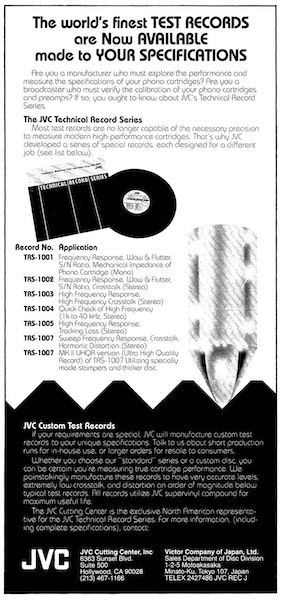
source: AES Journal, Vol. 30, No. 9, p.669.
TRS-1007 featured on the Ad in 1982 AES Journal
special UHQR version of TRS-1007 is also listed there
1982年発行の学会誌に掲載された広告では TRS-1007 が掲載されている
しかも TRS-1007 の特製 UHQR バージョンもラインアップにある
残るは Ortofon、Shure、および日本の Sansui です。
The last bunch from this article features test records of Ortofon, Shure and Sansui of Japan.
Ortofon は Bruel & Kjaer QR-2010 を参照、とあります。また、SANSUI のQS方式4チャンネルテストレコードについては情報を見つけられませんでしたが、型番から The Total Sound PR401QS と同一レコードと判断しています。
Ortofon test record is simply noted as “Details as per Bruel & Kjaer QR-2010, comprehensive laboratory disc.”. I have not found any more information on SANSUI’s QS quadrophonic test record, but I assume it is identical to The Total Sound PR401QS (which shares exactly the same catalog number).
| Ortofon | |
|---|---|
| Details as per Bruel & Kjaer Type QR-2010 Comprehensive Laboratory Disc |
|
| SANSUI (The Total Sound) | |
| PR401QS | Project 3 / Popular Science Test Record (To Set Up / Calibrate / Check Out Your Quadraphonic System) (unknown, but arguably RIAA) |
| Shure | |
| TTR-103 | Trackability Test Record 45rpm 12-inch (unknown) |
| TTR-110 | Audio obstacle course – era III, The Shure Trackability Test Record for Stereo Recordings 33⅓rpm 12-inch RIAA |
Shure は純粋な計測テストレコード TTR-103 と、聴感によるテストレコード TTR-110 の 2枚が掲載されています。どちらもトラッカビリティテスト用です。
Two test records from Shure are listed. Both are for checking trackability: TTR-103 (technical recording for use with lab instruments) and TTR-110 (for listening test).
TTR-103 はプロフェッショナルユースです(45rpm、テスト信号のみ、ジャケットなし)。全編が非常に高い録音レベルでのカッティングとなっています(TTR-103 の取説)。
TTR-103 is exclusively for professional use (45rpm, test tones only, no cover), cut with very high recording level.
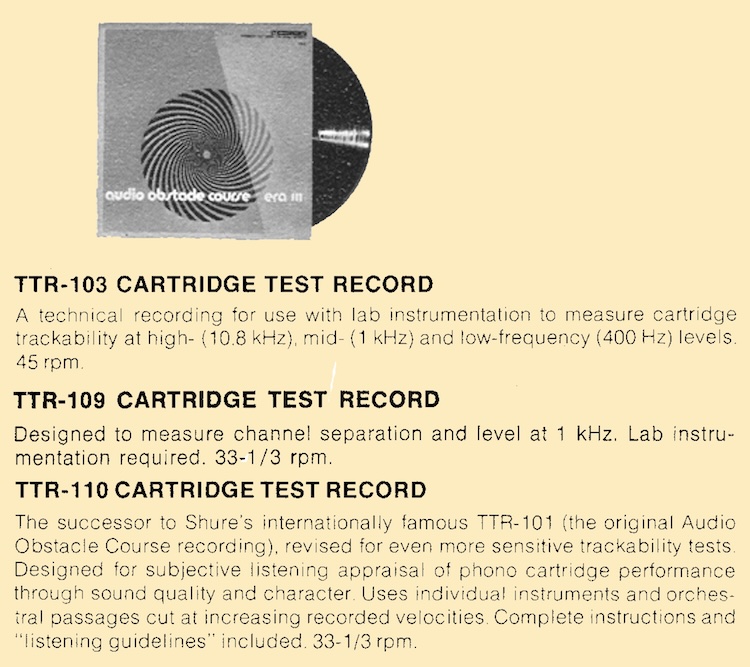
source: Shure 1977 Catalog, p.24.
1977年版 SHURE カタログに掲載された TTR-103 / 109 / 110 テストレコード。
一方 TTR-110 は主観的評価用(33⅓rpm、大半が演奏音源、ジャケットあり)です。A-2 にバランステストと位相テストがある他は、実際の音楽音源が収録されています。こちらも全編が非常に高い録音レベルでのカッティングとなっています。
On the other hand, TTR-110 is for subjective evaluation of tracking ability (33⅓rpm, musical contents in most tracks, with cover). It contains musical contents except A-2 (for balance test and phase test). This record is also cut at very high level.
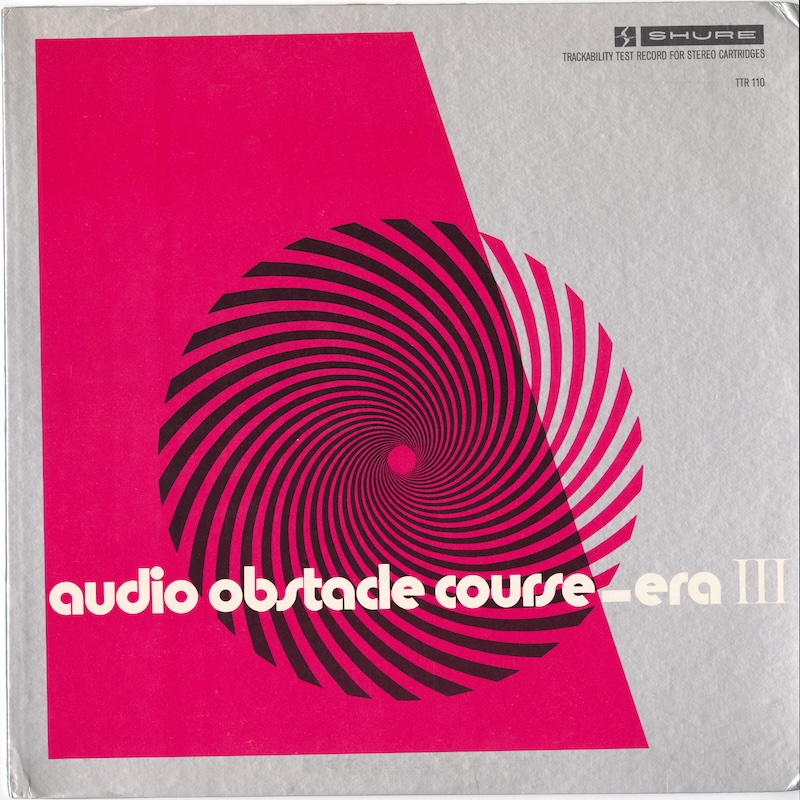
Audio obstacle course – era III, The Shure Trackability Test Record for Stereo Recordings
(Shure TTR-110)
from my own collection
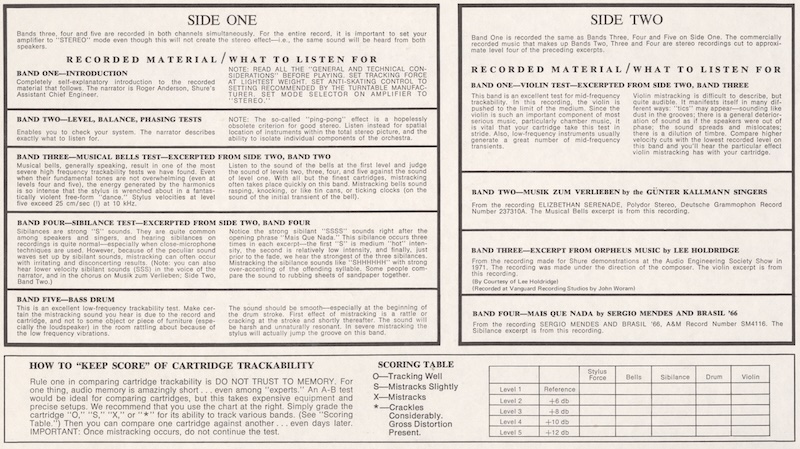
Track listing on liner-notes of TTR-110
TTR-110 ライナーにある収録内容
以上、Studio Sound 誌に掲載された大量のテストディスク一覧をみてきましたが、当然ながら「厳密な計測用テストレコードは RIAA ただし 1kHz 以上は定速度フラット(500R-FLAT)、または 500Hz 以下は定振幅で500Hz以上は定速度(500N-FLAT)」「フォノイコを含めた周波数応答チェック用のテストレコードは RIAA」「デモンストレーションレコードは RIAA」であることが分かります。
…the above is a list of the large number of test discs published in Studio Sound magazine, and it is obvious that almost all of these test records fall into either of the following categories: “test records for strict measurements are cut with RIAA, except constant velocity flat above 1kHz (500R-FLAT), or constant velocity flat above 500Hz and constant amplitude below 500Hz (500N-FLAT)”; “frequency response test record to check the system including phono EQ is cut with RIAA”; “hi-fi demonstration record is cut with RIAA”.
21.3 Some More of the Test Records from My Collection
以上、過去のさまざまなテストレコード一覧記事をみてきましたが、掲載されているものは大半がプロフェッショナルユースの計測テストレコードでした。
So far we have seen many lists of test records in the past. Most of them primarily featured professional calibration test records.
ですが、当然ながら、市販用テストレコードやハイファイデモンストレーションレコードは、枚挙にいとまがない種類がリリースされています。
Of course, however, there are countless kinds of test records, including audio check records and hi-fi demonstration records for consumers.
このセクションでは、一般流通用していた市販用、プロフェッショナルユースの計測用、など、さまざまなテストレコードのうち、私の手元にあるものをいくつか紹介していきます。
This section will feature some of the various test records from my own collection, including consumer test records, professional measurement test records, etc..
21.3.1 Decca Microgroove Frequency Test Record (Decca LXT 2695, c. 1952-1953)
まず最初は、英Deccaが1952年〜1953年頃にリリースしたと思われる、周波数テストレコード Decca LXT 2695 です。
First is a frequency test record, Decca LXT 2695, which was released by UK Decca, probably around 1952-1953.
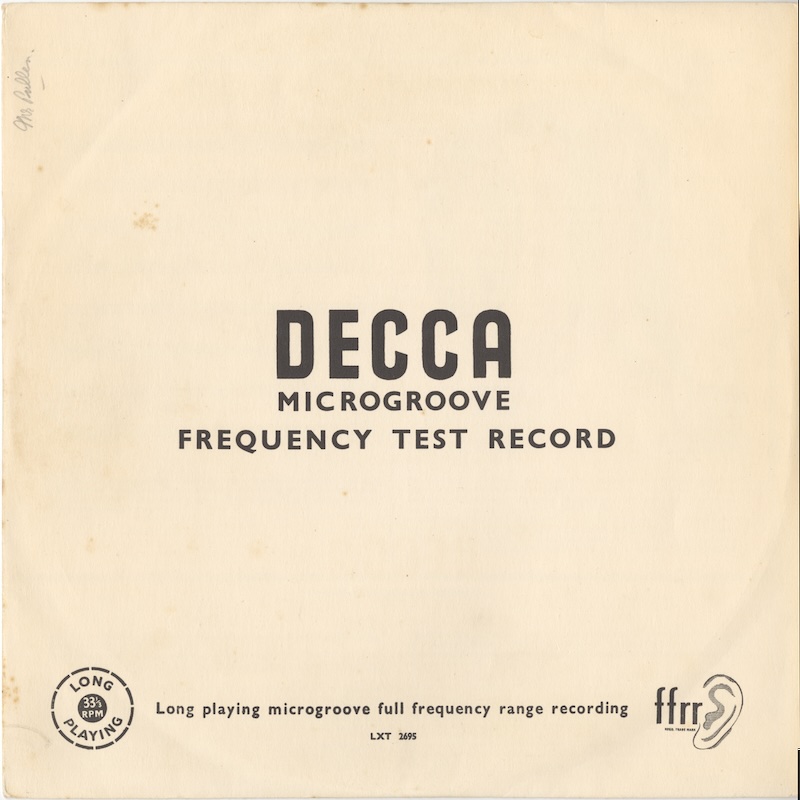
DECCA Microgroove Frequency Test Record (Decca LXT 2695)
early matte (non-glossy) flipback cover
from my own collection
調べた限りにおいては、Wireless World UK 誌 1953年5月号(Vol. 59, No. 5)に掲載された Cosmocord (Acos) 社の広告記事内に登場するのと、1953年発行(1952年校了)の RCA Radiotron Designer’s Handbook 4th Edition のテストレコード一覧補足に出てくるのが最も古い情報でしたので、遅くとも1953年5月までにはリリースされていたことになります。
As far as I have been able todetermine, the earliest information on this record is from an advertisement by Cosmocord (Acos) in the May 1953 (Vol. 59, No.5) issue of Wireless World UK Magazine, and from a supplement to the 1953 RCA Radiotron Designer’s Handbook 4th Edition, published in 1953 (proffed in 1952). So this particular record was released in no later than May 1953.
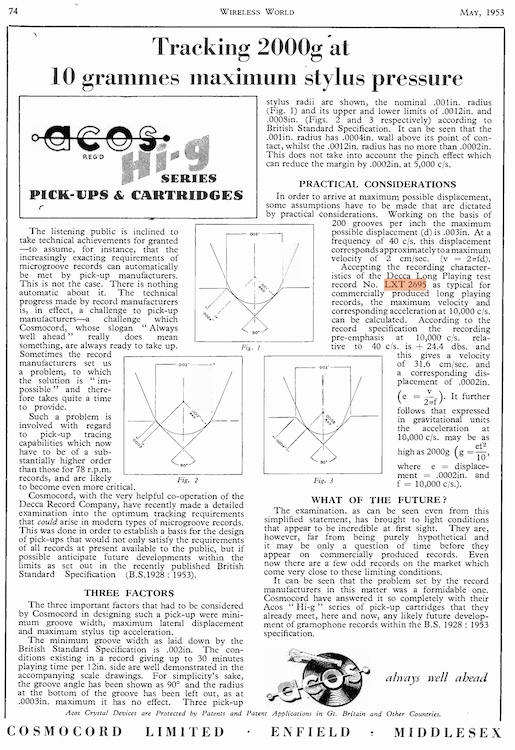
source: Cosmocord (Acos) Ad, Wireless World, May 1953, p.74.
参考のために、(リリース順にはあまりあてにならない)カタログ番号でいうと、前後の LXT 2694 と LXT 2496 は、いずれも1952年リリースということになっているようです。
For reference, in terms of catalog numbers (which do not always indicate release order), it appears that the previous title LXT 2494 and the next title LXT 2496 were both released in 1952.
LX 2695 自体は比較的中古市場で見かけますが、光沢あり(ラミネート)ジャケットのものではなく、ラミネートなしマットジャケットなのはあまり見かけないかもしれません。デッドワックス12時のタックスコード刻印は CT、その他の情報を総合的に考えると、1952〜1953年頃の初版、またはそれに近いリリースと考えられます。
LX 2695 itself is relatively easy to find in the used market, but most of them come with glossy (laminated) cover — we seldom see the early variation with matte cover without lamination. The tax code matrix at 12 o’clock dead wax is CT, and other information taken together suggests that this particular copy is a first or near-first release circa 1952-1953.
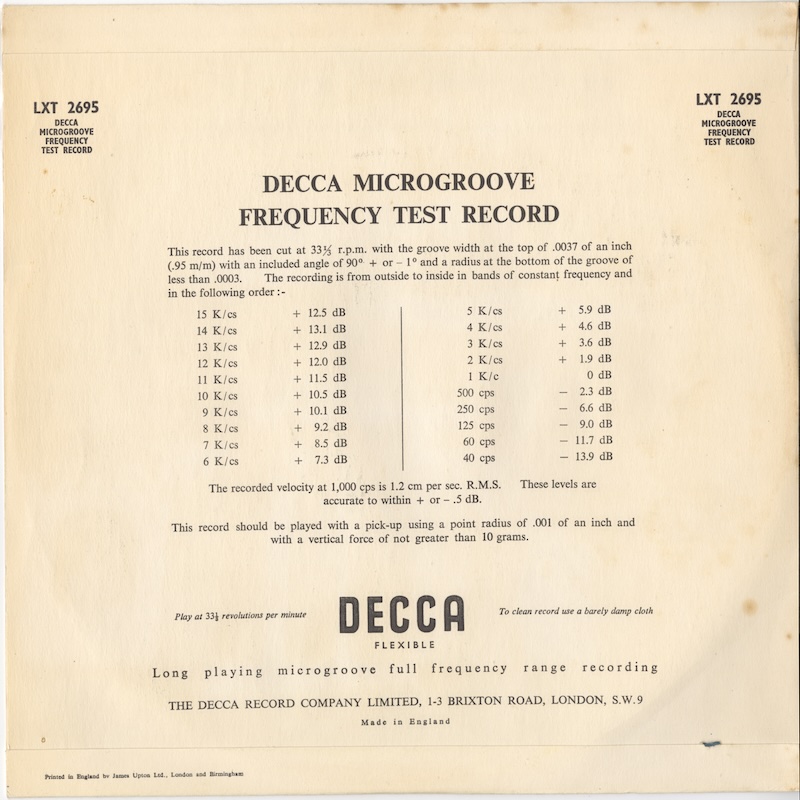
DECCA Microgroove Frequency Test Record (Decca LXT 2695)
early matte (non-glossy) flipback cover
from my own collection
両面とも同一内容で、マトリクス番号も同一の EDP 145-1B です。同一マスターから作られた2枚のスタンパーでプレスされたのでしょう。なお、マトリクス末尾の B は、当時の UK Decca のカッティングエンジニア Ron Mason を指します。
Both sides are identical and share the same matrix number EDP 145-1B, which suggests that both sides have been pressed with two stampers made from the same master disc. BTW the letter B of the matrix suffix refers to Ron Mason, UK Decca’s cutting engineer at the time.
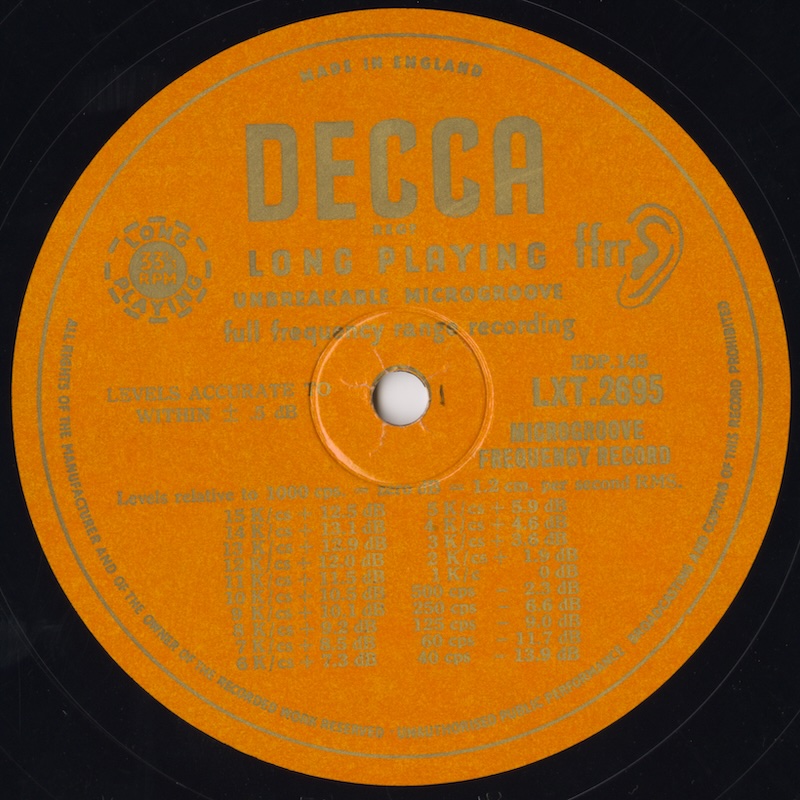
Label of Decca LXT 2695
no tax code on label
from my own collection
収録されているのは 15kHz〜40Hzのテストトーンで、当時の UK Decca LP 用 ffrr 録音カーブ(500N-10.5)でカッティングされています。標準録音レベルは 1.2cm/s at 1kHz です。
The recorded test tones are from 15kHz to 40Hz, cut with the ffrr recording curve (500N-10.5) that was used by UK Decca LP records. The standard recording level is 1.2cm/s at 1kHz.
のちの ラミネートジャケ では、裏ジャケ右下に「Ju.56/6」と印刷があり、1956年6月でも旧 ffrr テストレコード LXT 2695 が存在していたことになります。
Later variation with glossy (laminated) cover has “Ju.56/6” printed in the lower right corner of the back cover, indicating that the old ffrr test record LXT 2695 still existed in June 1956.
ですので、恐らくは、B.S.1928:1955 (=RIAA) 準拠の新 ffrr 周波数テストレコード LXT 5346 が出るまでは、LXT 2695 は流通していたと考えられます。
So, presumably, LXT 2695 was in circulation until the B.S. 1928:1955 (=RIAA) compliant new ffrr frequency test record LXT 5346 was released.
21.3.2 “New Orthophonic” Frequency Test Record (RCA Victor 12-5-49, c. 1952-1953)
Pt. 18 セクション 18.3.3 で紹介済みですが、本稿 Pt.21 前半でも何度となく登場していた RCA Victor 12-5-49 は、カートリッジ + フォノイコ + アンプの周波数応答チェックに特化した周波数テストレコードです。
RCA Victor 12-5-49, already introduced in Pt. 18 Section 18.3.3, and repeately mentioned in the first half of this Pt. 21 article, is a frequency test record dedicated to checking the total frequency response of phono cartridge, phono preamp (phono EQ) and amplifier.
特定の録音特性(New Orthophonic、のちの RIAA)に基づいてテストトーンがカッティングされており、再生機器側で正しくEQ設定が行われているかを確認するためのものです。また同時に、カッティング時の基準録音レベルの確認や録音EQのチェックのための基準レコードとして使われていました。
It is cut with a specific recording curve (New Orthophonic, which later became RIAA), and is used to check the correct compensation (and EQ setting) on the playback equipment. It is also a reference record used at mastering (cutting) studios, to check the reference recording level and the recording EQ.
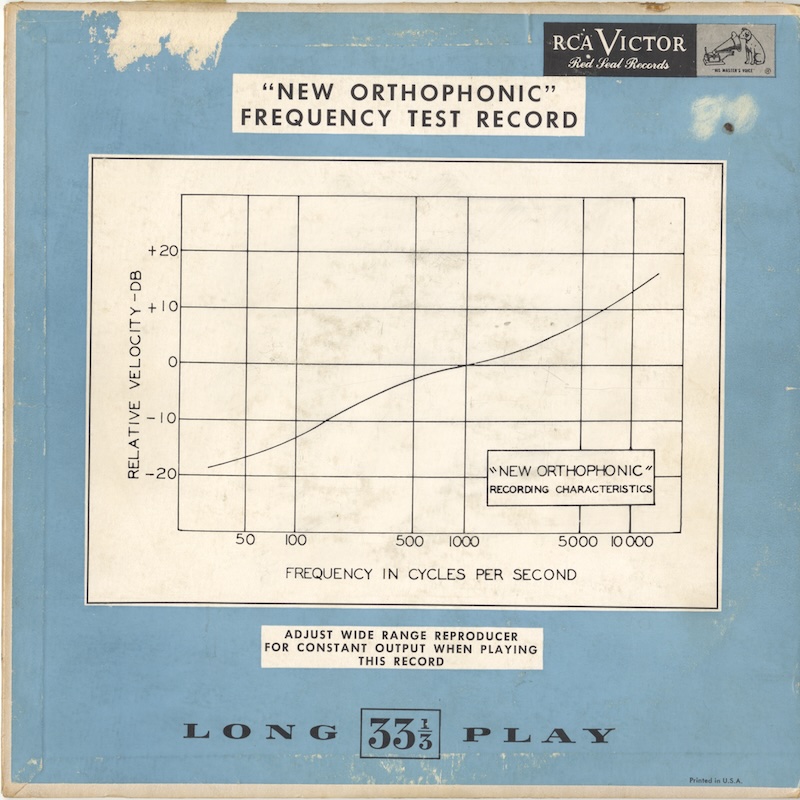
New Orthophonic Frequency Test Record (RCA Victor 12-5-49)
from my own collection
1952年暮れ〜1953年初頭リリース、10インチ33⅓回転マイクログルーヴLP、手元にあるのは片面盤です(バリエーションとして両面盤もあり)。ちなみに 12-5-51 は同内容で45回転バージョン、12-5-50 は放送局用 NARTB テストレコード(つまり New Orthophonic や RIAA と同一特性)です。
It was released in late 1952 or early 1953, and it’s a 10-inch 33⅓rpm microgroove record. The copy I own is a single-sided version (there’s also a double-sided version as well). FYI, 12-5-51 is a 45 rpm version of 12-5-49, and 12-5-50 is a NARTB test record for broadcast stations (i.e. the same characteristics as New Orthophonic and RIAA).
ジャケット裏の解説には、本レコードの収録内容について説明があります。
The liner-notes on the back cover explains the contents of this record.
The record conforms to the above curve with the exception of the outer band containing frequencies from 15 kc to 10 kc which is recorded at a reduced level. This band is recorded 20 db below normal recording level.
当レコードには上述のカーブ(“New Orthophonic” 録音カーブ)に準じているが、周波数帯域 15kHz〜10kHz(のテストトーン)を含む最も外側のトラック(A1)は、録音レベルが下げられている。このトラックは標準録音レベルから 20dB 下げて録音されている。
The next band containing frequencies from 10 kc to 30 cycles is recorded 14 db below normal level.
続くトラック(A2)は、周波数帯域 10kHz〜30Hz(のテストトーン)を含むが、こちらは標準録音レベルから14dB下げて録音されている。
The reduction in level has been made so that the groove curvature at the extreme high frequencies never becomes less than approximately twice the curvature of a normal fine groove stylus, a condition necessary to insure satisfactory tracing of the grooves by the stylus.
このように録音レベルを下げているのは、極端な高周波数における溝の曲率が、通常のマイクログルーヴ用再生針の曲率の2倍以下にならないようにするためであり、これは再生針が記録溝を問題なくトレース可能なよう保証するために必要な条件である。
The third band (1,000 cycles) is the normal reference level for 45 and LP recording.
3つ目のトラック(A3)は 1kHz(のテストトーン)であり、こちらは 45回転盤や LP でのリファレンスとなる標準録音レベルである。
liner-notes of “New Orthophonic Frequency Test Record”, RCA Victor 12-5-49このように、New Orthophonic 録音再生特性(のちの RIAA 標準録音再生特性)のチェック、再生機側をチェックするテストレコードの場合、全周波数帯域を通じて基準レベルでカッティングすると高域を満足に再生できない可能性が高くなるため、高域ではわざとカッティングレベルを下げられています。
Thus, in the case of test records for the purpose of checking the New Orthophonic (RIAA) characteristics and checking the playback equipment side, the cutting level is intentionally lowered in the high-frequency range, because the possibility of unsatisfactory playback in the high-frequency range, if it was cut at the same reference level over the entire frequency range.
本盤の基準録音レベルについてはライナーでは明記されていませんが、5.5cm/s at 1kHz であることが知られています。
The reference recording level of this record is not specified in the liner-notes, but it is known to be 5.5cm/s at 1kHz.

RCA Victor 12-5-49 Label Side-A
from my own collection
続いて、本盤を使用したチェックの方法が丁寧に解説されています。
It is followed by a detailed explanation of how to check using this test record.
In order to check a reproducing system it is necessary only to connect a suitable rectifier or vacuum tube type voltmeter across the loudspeaker terminals, adjust the volume control for normal listening level with music, and play the second band of the frequency record.
再生システムのチェックに際しては、適切な整流器、または真空管タイプの電圧計をラウドスピーカ端子に接続し、ボリュームコントロールを音楽を聴く際の通常のリスニングレベルに合わせ、本周波数レコードの2トラック目(A2)を再生するだけでよい。
High and low frequency tone controls should then be adjusted as required until the meter reading at all frequencies from 10,000 cycles per second down to 30 cycles per second is as nearly constant as possible.
そして、10,000Hz〜30Hzまでの全周波数帯域におけるメータの読みができるだけ一定になるまで、必要に応じて高域/低域トーンコントロールを調整する必要がある。
For those interested in system behavior up to 15,000 cycles the outer band of the record may be used. An ideal system will produce a constant voltage outout from this band, although the actual voltage will be approximately 1/2 of that obtained from the second band of the record.
15,000Hz までのシステム応答に興味のある者は、本レコードの1トラック目(A1)を使用可能である。理想的なシステムにおいては、この帯域から一定の電圧が出力される。ただし実際の電圧は、2トラック目(A2)で得られる電圧の約1/2となる。
liner-notes of “New Orthophonic Frequency Test Record”, RCA Victor 12-5-49このプロフェッショナルユースの計測テストレコード 12-5-49 がリリースされた1952年暮れ〜1953年初頭には、市販の民生用オーディオ機器(マニア向けの「フォノイコ内蔵プリアンプ」も含む)においては、New Orthophonic 特性(のちの RIAA 録音再生規格)に準拠したフォノイコを内蔵したものは、あまり存在していませんでした(Pt. 17 セクション 17.7 を参照)。
When this 12-5-49, professional-use measurement test record, was released in late 1952 or early 1953, few consumer audio devices on the market (including “preamplifiers with built-in phono compensator”) had phono compensation circuit that conformed to the New Orthophonic characteristics (see also: Pt. 17 Section 17.7 for details)
そのため、「トーンコントロールで」調整する、と書かれているのでしょう。
This may be why the liner-notes mentions as “High and low frequency tone controls should then be adjusted as required”.
加えて当時は、放送局や録音スタジオなどプロフェッショナル現場、および当時のオーディオマニアを除き、大多数のリスナー(民生用に市販されていた機器を使いレコード再生を行う消費者)は、クリスタルやセラミックなど圧電式カートリッジを使用していたため、マグネットカートリッジ向けのような再生時補正はあまり考慮されていなかったこともあるでしょう。
In addition, with the exception of professional scenes such as broadcast stations and recording studios, vast majority of of listeners were using the consumer reproducing equipment, equipped with piezo-electric phono cartridges (crystal and ceramic). Such piezo-electric cartridges were probably not considered to achieve the precise reproduction (that magnet pickups could do with phono preamps).
テストレコード 12-5-49 はあくまで専門用途であったため、圧電式カートリッジは関係ないのでは?と思われるかもしれませんが、例えば圧電式カートリッジを装着した家庭用電蓄やオーディオシステムを製造・販売するメーカが、RCA Victor が採用した New Orthophonic 新録音特性にあわせて圧電式ピックアップ用の補正回路を設計したりテストを行ったりする際に、このレコードが使われたりしたと想像できます。
One might think that piezo-electric cartridges are irrelevant to such professional test records as RCA Victor 12-5-49. However, it could be imagined that that manufacturers of household phonographs and consumer audio systems with piezo-electric cartridges using such frequency response test record, in order to design and test compensation circuits for piezo-electric pickups to match the New Orthophonic recording characteristics adopted by RCA Victor.
のちに RIAA 特性が業界標準となってからは、ルームアコースティックやスピーカ特性を除いた条件で、機器側で RIAA カーブで(ほぼ)フラット再生できていることを保証するためのテストレコードとして使われたのでしょう。
And later, when the RIAA characteristics became the industry standard, it was probably used as a test record to guarantee that the equipment could reproduce (nearly) flat using the RIAA curve, under conditions exclusing room acoustics and loudspeaker characteristics.
21.3.3 The Measure of Your Phonograph’s Equalization (Dubbings D-101, 1953)
1953年には非常に興味深いユニークなテストレコード Dubbings Company D-101 が登場します。オーディオ販売業者や修理業者向けにリリースされた、プロフェッショナル向け周波数テストレコードです。
It’s a very interesting and unique measurement test record: the Dubbings Company D-101. This frequency test record for professionals was released in 1953, aimed for audio dealers, resellers and repair shops.
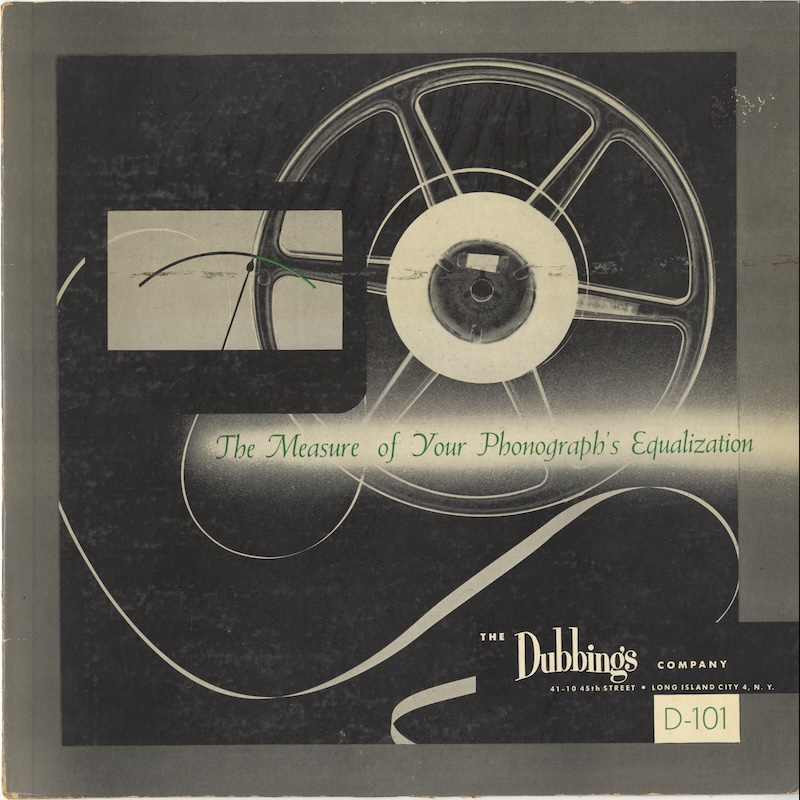
The Measure of Your Phonograph’s Equalization (Dubbings D-101, 1953)
from my own collection
いろんな雑誌等を調べた範囲では、D-101 に触れる最も古い記事は Audio Engineering 誌 1953年12月号 p.40 のものでした。他には、1954年前半の雑誌に広告が掲載されているのを数件みつけました。
As far as I can tell from my research of various magazine back numbers, etc., the earliest mention of the D-101 was in the Dec. 1953 issue of Audio Engineering magazine, p.40. I found several other advertisements in magazines from the first half of 1954.
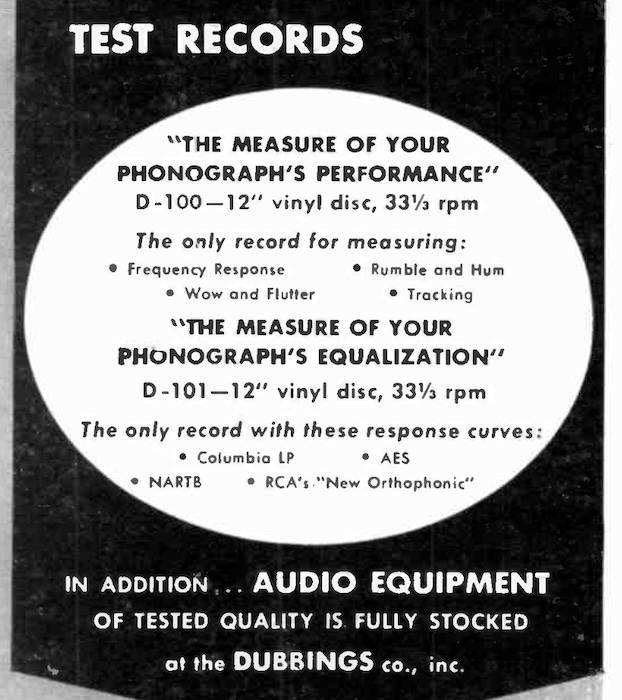
source: Magnetic Film & Tape Recording, Vol. 1, No. 3, March/April 1954.
Magnetic Film & Tape Recording 誌に掲載された Dubbings Company D-101 の広告
1953年12月あるいはそれ以前のリリースですから、RIAA 録音再生標準規格がまだ策定すらされていないタイミング、ということになります。
Since it was released in Dec. 1953 or earlier, it means that the RIAA recording and playback standards had not yet been established at the time of the release.
このテストレコードには、基準トーンである 1kHz に始まり、12kHz、10kHz、8kHz、6kHz、4kHz、2kHz、1kHz、700Hz、400Hz、250Hz、100Hz、50Hz、30Hz のスポット信号が記録されています。
This test record starts with the reference tone at 1kHz, followed by spot signals at 12kHz, 10kHz, 8kHz, 6kHz, 4kHz, 2kHz, 1kHz, 700Hz, 400Hz, 250Hz, 100Hz, 50Hz and 30Hz.
Dubbings D-101 がユニークなのは、上述のトーンシグナルが、A-1〜14 の Columbia LP カーブ(500C-16)、A-15〜28 の RCA “New Orthophonic” カーブ(500R-13.7)、B-1〜14 の 1949 NARTB カーブ(500B-16)、B-15〜28 の 1951 AES カーブ(400N-12)と、4種類の録音再生特性それぞれに対応して収録されている点です。
What makes the Dubbings D-101 unique is, that these tone signals listed above are recorded with four different recording/reproducing characteristics: the Columbia LP curve (500C-16) on A-1 through A-14, the RCA “New Orthophonic” curve (500R-13.7) on A-15 through A-28, the 1949 NARTB curve (500B-16) on B-1 through B-14, and the 1951 AES curve (400N-12) on B-15 through B-28.
frequency test tones
for Columbia LP (500C-16)
and RCA “New Orthophonic” (500R-13.7)
frequency test tones
for 1949 NARTB (500B-16)
and 1951 AES (400N-12)
つまり、まだ民生用レコード向け統一カーブが存在しなかった当時、可変フォノイコ内蔵アンプ、あるいはトーンコントロールのみ備えた一般的なアンプ、それぞれに対して、代表的な4つのカーブでカッティングされたレコードを可能な限りフラットに再生するため調整する目的で製造されたテストレコードでした。
In other words, this particular test record, when the unified recording/reproducing curve for consumer records didn’t yet exist, was manufactured for the purpose of adjusting the playback response of records cut with four typical curves as flast as possible, both for amplifiers with built-in variable phono compensators or general amplifiers only with tone controls.
それにしても、録音カーブではなく再生カーブである AES 特性に合わせたテストレコード、というのは、私の知る限りこれ1種類しかありません。
As far as my research goes, this is the only known test record that matches the AES characteristics, which is a playback curve, not a recording curve.
ジャケット裏には使い方の詳しい解説があります。
The liner-notes describes detailed instruction of how to use this test record.
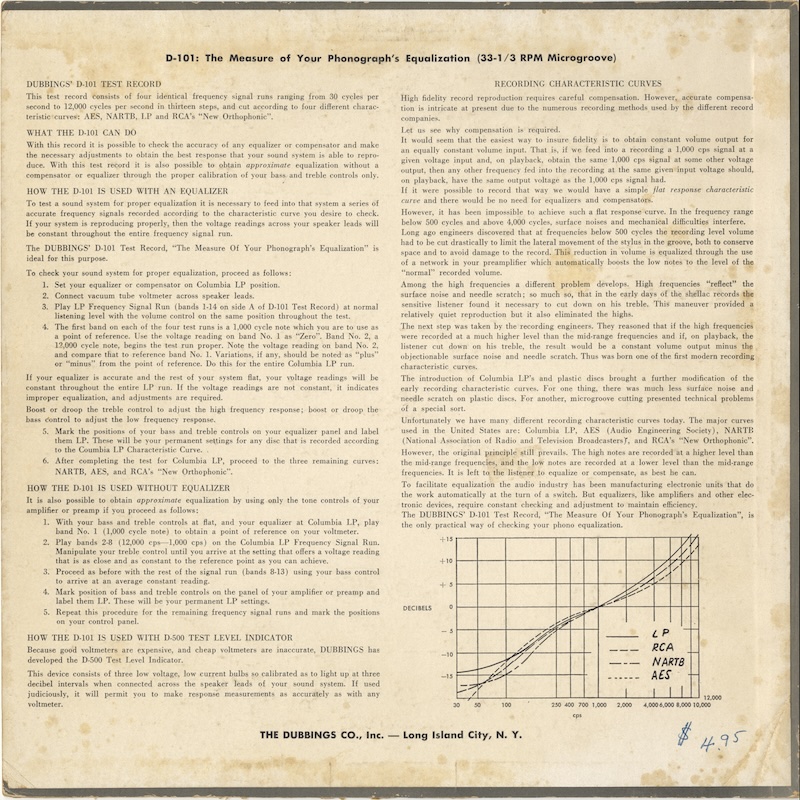
The Measure of Your Phonograph’s Equalization (Dubbings D-101, 1953)
from my own collection
電圧計をスピーカ端子につなぎ、アンプにフォノイコポジションがある場合は Columbia LP にセットし、A-1〜14 を再生して、全ての周波数が同一レベルとなるようにトーンコントロールで調整し、設定が終わったら、トーンコントロールの位置に「LP」とラベルを貼ります。これを残りの New Orthophonic / NARTB / AES についても繰り返す、とあります。
After vacuum tube volmeter is connected across speaker leads, you set the equalizer (compensator) on Columbia LP position, then play A-1 to A-14, then adjust tone controls to get all the frequency signals read flat, and finally mark the positions of the bass/treble controls and label them “LP”. This will be repeated for the rest of the curves: New Orthophonic / NARTB / AES.
アンプにフォノイコがない場合も、同様にトーンコントロールでそれぞれのカーブに対しておおよそフラットになるように調整したのち、カーブごとにラベルを貼るように指示があります。
The liner-notes also describes that “it is also possible to obtain approximate equalization by using only the test controls of your amplifier” by following the similar step as above.
このような複数カーブを対象とした周波数テストレコードは、次に紹介する Folkways FPX-100 / FX-6100 と共に非常に珍しいものでした。一方、1954年に RIAA が業界標準特性を策定後、アンプの内蔵フォノイコの混乱が徐々に収斂するにしたがって、このような特殊なテストレコードは一切見られなくなりました。
Such frequency test records for multiple curves were extremely rare, along with the Folkways FPX-100 / FX-6100 which will be mentioned immediately below. On the other hand, as the 1954 RIAA curve became the industry standard and the confusion over built-in phono preamplifiers gradually converged, we no longer see any such special test records.
21.3.4 Sounds of Frequency (Folkways FX-6100, 1954)
Pt. 17 セクション 17.5.7 のコラム で紹介した、Peter Bartók 制作のレコード「Sounds of Frequency」 (FX-6100) は、1954年リリースです。これも、上の Dubbings D-101 同様、ユニークな内容となっています。
The “Sounds of Frequency” (FX-6100), already mentioned in Pt. 17 Section 17.5.7 was a test record produced by Peter Bartók, released in 1954. Like the Dubbings D-101 above, this is another unique test record.
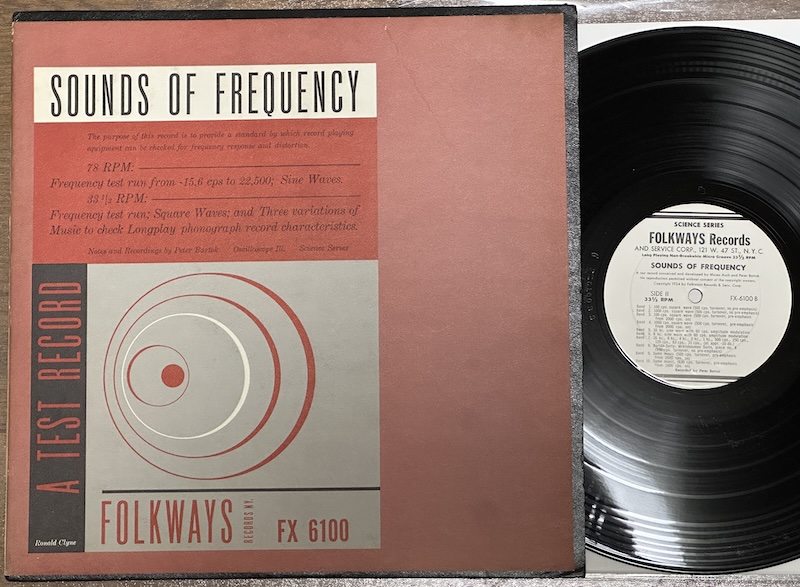
“Sounds of Frequency” (Folkways FX-6100, 1954, probably the reissue of FPX-100)
from my own collection
ファーストプレスが FPX-100 で恐らく1952年〜1953年リリース、RIAA策定後の1954年に改訂版として FX-6100 が出され、後者は1970年代まで販売されていたようです。
Initial issue was FPX-100, probably released in 1952 or 1953, and it was soon followed by a revised version FX-6100, which was released after the formulation of the RIAA Standards, and was probably had been sold until the 1970s.
もちろん、制作が行われたのはニューヨークの Peter Bartók Studios で、カッティングは Peter Bartók 本人によるものです。FPX-100 は RCA Victor で、FX-6100 は Plastylite で、それぞれ委託プレスされました。
Of course, the cutting was done by Peter Bartók himself, and it was produced at the Peter Bartók Studios in New York.
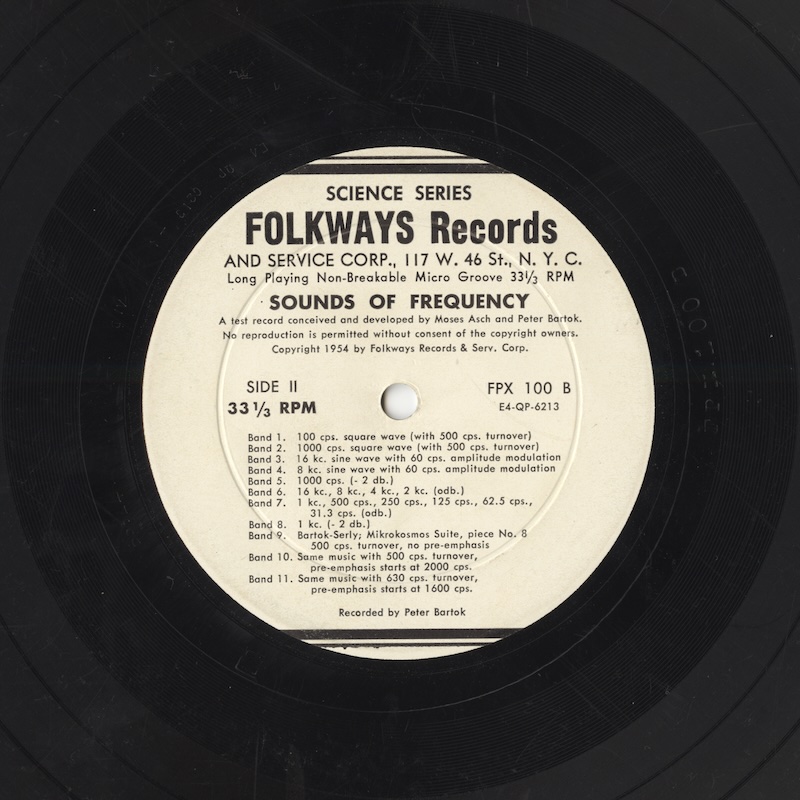
Folkways FPX-100 Label Side-B
Matrix include E4-QP-6213, which indicates the pressing was done at RCA Victor (but lacquer cut by Bartók)
マトリクスの E4-QP-6213 から、RCA Victor プレス(ただしカッティングは Bartók スタジオ)であることがわかる
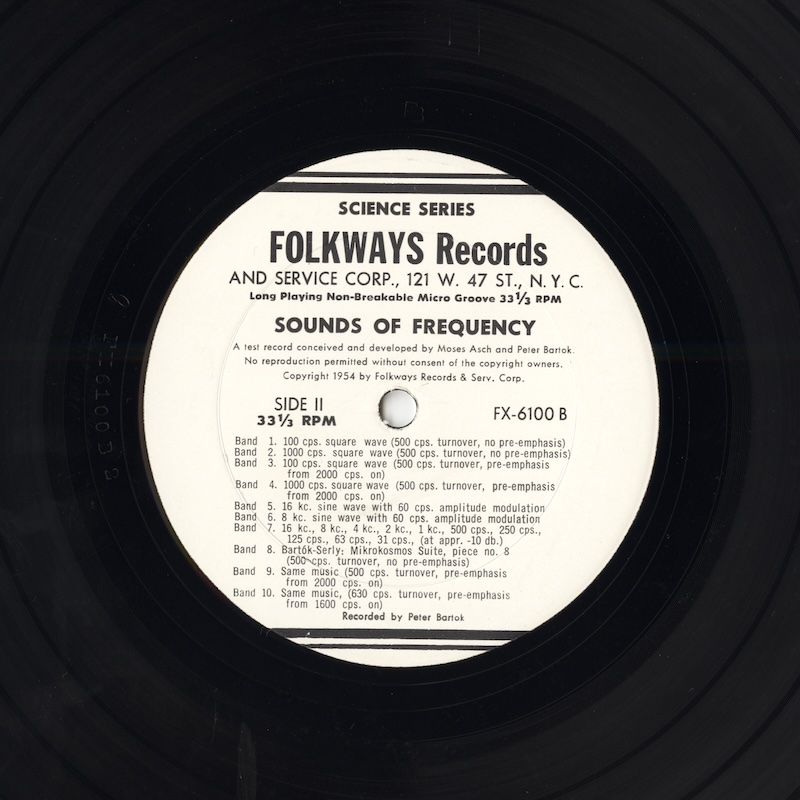
Folkways FX-6100 Label Side-B
infamous “ear” mark indicates that this was pressed at Plastylite
耳マークから、プレスは Plastylite で行われたことが分かる
周波数特性チェックなどを目的としたテストレコードなのに、なぜか Apple Music 上でリリースされているのが面白いです。
It is interesting that it is a test record intended for frequency response checks, etc., but for some reason it is now available on Apple Music.
A面は78rpmマイクログルーヴで、22.5kHz〜15.6Hz までのテストトーンが多数収録されており、録音特性は「ターンオーバー周波数500Hz、高域プリエンファシスなし」、すなわち、いわゆる「500N-FLAT」です。純粋な計測目的の面と言えます。
Side-A is a 78rpm microgroove, with a number of test tones varying from 22.5kHz to 15.6kHz, and the recording characteristics used are “turnover frequency at 500Hz, no high-frequency pre-emphasis”, or so-called “500N-FLAT”. So this side is purely for measurement purpose.
面白いのが、A面冒頭の「1000, 4000, 15000 cps」と、A面最後の「1000, 4000, 15000 cps」で、同一音源を比較することで、レコード最内周でどれくらい高域がロスしているか、どれくらい歪が増えているか、を確認するためのトラックです。
Interesting tracks are the first track A-1 and the last track A-15: both entitled “1000, 4000, 15000 cps”. They are for comparing the same sound source to see how much high frequencies are lost and how much distortion is increased in the innermost part of the record.
一方、B面は33⅓rpmマイクログルーヴで、さまざまな特性でテストトーンやサンプル音源が収録されています。
Side-B, on the other hand, is a 33⅓rpm microgroove, with test tones and sample musical tracks, with various recording characteristics.
FX-6100 の B-7(FPX-100 では B-5〜8)には、Peter Bartók 氏が好んで使用していた、通称「Bartók カーブ」(630C-16)でのテストトーンが収録されています(正確にはターンオーバー周波数は 630Hz ではなく 629Hz)。
The track B-7 on FX-6100 (tracks B-5 to B-8 on FPX-100) contains a test tone cut in accordance with what is known as “Bartók curve” (630C-16), which definitely favored by Peter Bartók (technically, the turnover frequency is 629Hz, not 630Hz).
FX-6100 の B-8〜10(FPX-100 では B-9〜11)には、Bartók BRS-303 (1951) に収録された “Bartók-Serly: Mikrokosmos Suite, piece #8 (Sixth dance in Bulgarian Rhythm)” の抜粋が収録されているのですが、同一音源を3つの録音特性で記録したものとなっています。
Tracks B-8 to B-10 on FX-6100 (tracks B-9 to B-11) contain excerpts from “Bartók-Serly: Mikrokosmos Suite, piece #8 (Sixth dance in Bulgarian Rhythm)”, from Bartók BRS-303 (1951). Interestingly enough, the same performance is recorded with three different recording characteristics.
- B-8: “500 cps. turn-over, no preemphasis”
(500N-FLAT: ターンオーバー 500Hz、プリエンファシスなし) - B-9: “500 cps. turn-over, preemphasis starts at 2000 cps. (RIAA Curve)”
(500R-13.7: ターンオーバー 500Hz、プリエンファシスは 2,000Hz より) - B-10: “630 cps. turnover, preemphasis starts at 1600 cps.”
(630C-16: ターンオーバー 630Hz、プリエンファシスは 1,600Hz より)
この「2,000Hzより」「1,600Hzより」という表記は、後年の時定数による厳密な表記(75μs: 2,122Hz や 100μs: 1,591Hz)とは異なることには注意が必要です。ともあれ、可変フォノイコを使ったこの3トラックの聴き比べは、本当に興味深いです。
It should be noted that these notations “from 2,000Hz” and “from 1,600Hz” are different from the later strict notations based on time constants (75μs: 2,122Hz and 100μs: 1,591Hz). Anyway, it is really interesting to hear a comparison of these three tracks using variable phono EQ pre-amplifier.
1954年以降のリリースであるにも関わらず、500N-FLAT や RIAA だけではなく Bartök カーブのテスト用のトラックを含むテストレコードを1970年代に至るまで出し続けていたのは、非常に例外的で、興味深い例と言えます。
It is a very exceptional and interesting example of a post-1954 release: this record, although included tracks cut with Bartók curve along with 500N-FLAT and RIAA, was continuously released until the 1970s.
それだけ、Peter Bartök 氏は、モノーラル時代には独自開発の録音カーブにこだわっていた、ということなのかもしれません。あるいは、Bartök カーブで自身がカッティングした Folkways のモノーラル旧譜・旧プレスを一般リスナーが再生する際、補正の参考として使ってもらう目的だったのかもしれません。
Perhaps that is why Peter Bartók was so particular about his original recording curves in the monaural era. Or perhaps he wanted to use the Bartók curve track as a correction reference for ordinary listeners when they play back the old Folkways recordings of old monaural pressings he had produced.
21.3.5 Stereophonic Frequency Test Record (London PS-131, 1958)
続いて、米Londonレーベルから1958年にリリースされた周波数テストレコード「Stereophonic Frequency Test Record」です。
The next test record, “Stereophonic Frequency Test Record” from U.S. London label, is released in 1958.
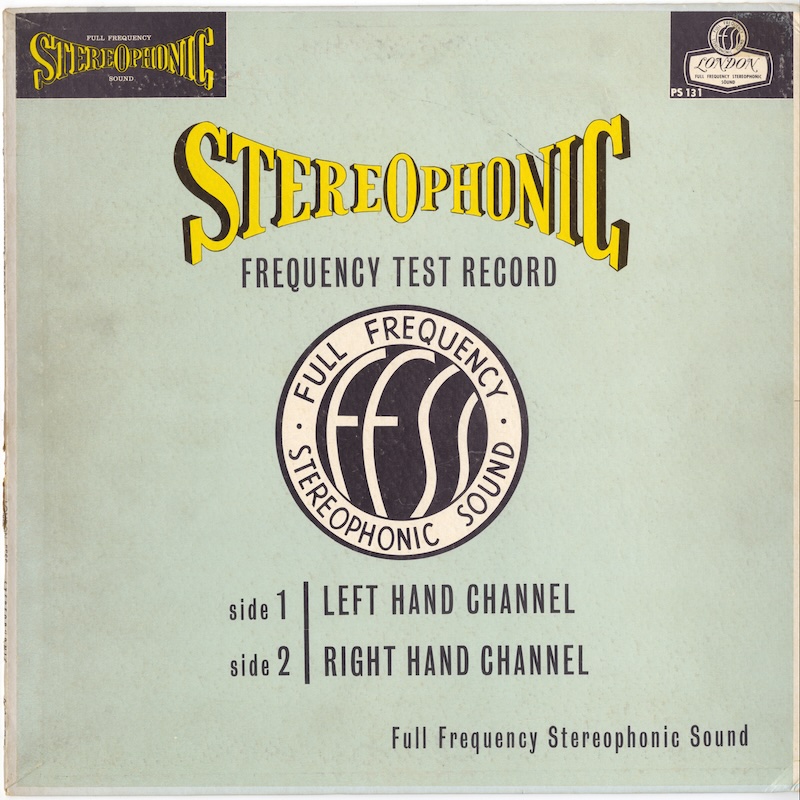
Stereophonic Frequency Test Record (London PS-131)
from my own collection
カタログ番号は London PS-131 で、マトリクス番号は ZAL.4059-1F (A面) と ZAL.4060-1F (B面)、すなわち、英 Decca SXL.2057 と全く同一のレコードです。
The catalog number is London PS-131. Matrix numbers are ZAL.4059-1F (Side-A) and ZAL.4060-1F (Side-B), which are exactly the same as the matrix numbers of U.K. Decca SXL.2057. So London PS-131 and SXL.2057 are identical.
当然ながら制作もカッティングも英国 Decca Studios で、英国プレスです。マトリクス末尾の F は、カッティングエンジニア Cyril Windebank を指します。
Production and mastering was done at U.K. Decca Studios, and pressed in the UK. The letter F of the matrix suffix refers to Cyril Windebank, UK Decca’s cutting engineer at the time.
このテストレコードには、12kHz〜40Hz まで12段階のテストトーンが収録されています。A面は左チャンネルのみ、B面は右チャンネルのみです。
PS-131 contains twelve test tones from 12kHz to 40Hz. Side-A is recorded on left channel only, and Side-B on right channel only.
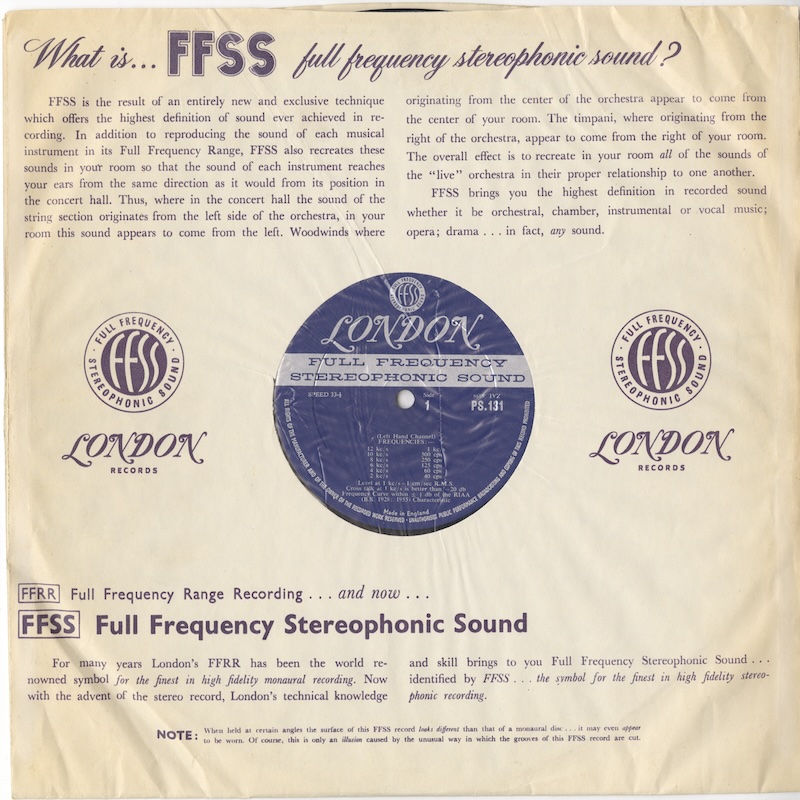
London PS-131 Label Side-A and FFSS sleeve
from my own collection
Pt. 20 セクション 20.1.3 および セクション 20.1.4 でみた通り、米Londonは、1954年春には「新規カッティングについては」RIAAカーブに移行していました。
As mentioned in Pt. 20 Section 20.1.3 and Section 20.1.4, US London had moved to the RIAA curve “for newly cut records” by the spring of 1954.
規格準拠に積極的だった、ということも考えられますが、それよりも、英国プレス米国販売の London の枚数や売り上げは英国販売の Decca より相当多かったでしょうから、米国の業界事情にいちはやく対応した、というのもあるでしょう。
Possibly U.S. London (and U.K. Decca) was proactive in complying with the standard, but it is more likely that they were quick to respond to the U.S. industry situation, since the number of copies and the sales of U.K. pressings in the U.S. sold by London were considerably higher than those of Decca in the U.K.
Decca SXL 2057 と同一盤である、この1958年のステレオテストレコード London PS-131 も、当然ながら RIAA (B.S. 1928:1955) 特性でカッティングされています。
Of course, this 1958 stereo test record London PS-131, identical to Decca SXL.2057, is cut with RIAA (B.S. 1928:1955) characteristics.
本盤では 1cm/s at 1kHz, 45°という録音レベルでの収録となっています。これは、上で見た CBS Labs BTR 150 の「5cm/s at 1kHz, 45°から 14dB 下げたもの」と同一値であり、CBS Labs STR 130(約0.7cm/s at 1kHz)や NAB 12-5-98 Test Record(約1.4cm/s at 1kHz)のスイープ信号と同様、高域プリエンファシスありのカッティングを行うための措置でしょう。
The recording level on this disc is 1cm/s at 1kHz, 45°. This is the same level as “14dB below 5cm/s at 1kHz, 45°” of the CBS Labs BTR 150 seen above. This low-level is probably a measure for cutting with high-frequency pre-emphasis, similar to the sweep signal of CBS Labs STR 130 (approx. 0.7cm/s at 1kHz) and NAB 12-5-98 Test Record (approx. 1.4cm/s at 1kHz).
21.3.6 Stereo Test Record (Riverside RLP-1100, 1959)
あの Riverside レーベルがステレオ最初期に使用していたカタログ番号は 1100番台でしたが、その最初を飾る Riverside RLP-1100 (1959年リリース) は、ステレオテストレコードでした。A面がステレオ、B面がモノーラルとなっています。
The Riverside label used series 1100 for early stereo releases, and its initial release, Riverside RLP-1100 (1959) was a stereophonic test record. Side-A is stereo, and Side-B is monaural.
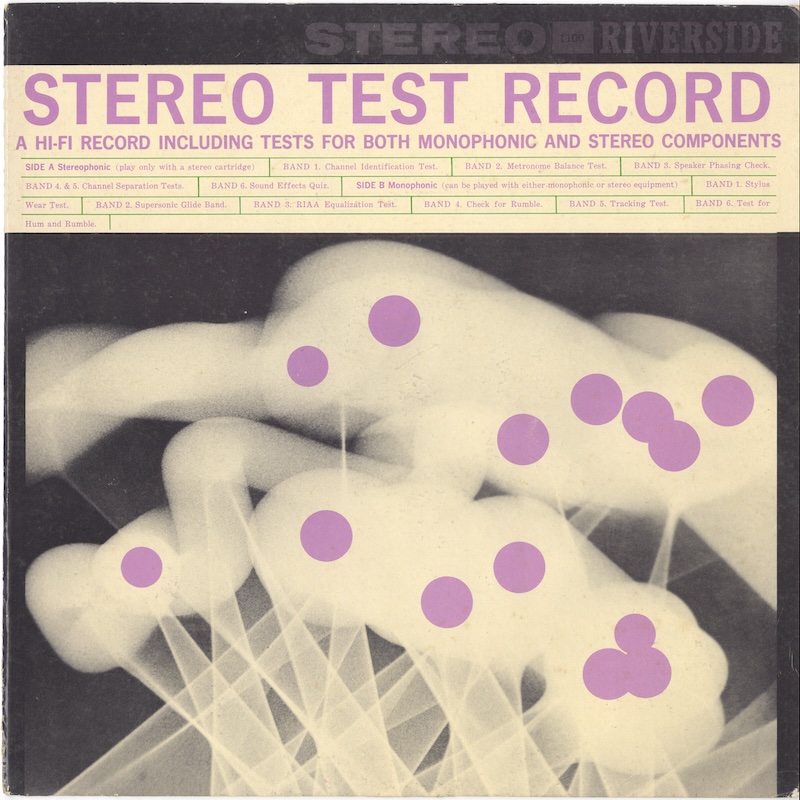
Stereo Test Record (Riverside RLP-1100) Front Cover
from my own collection
このテストレコードの制作・カッティングを担当したのは、ニュージャージー州 Denville にある Components Corporation でした。同社は1943年に設立され、コンポーネントオーディオ製造販売を行っていましたが、Reeves Sound Studios のエンジニア Jack Matthews を引き抜き、1959年に録音部門を設立、主に Riverside レーベルのマスタリングを担っていました。
The company responsible for the production and cutting of this test record was Components Corporation of Denville, New Jersey. The company was founded in 1943 as a component audio manufacturer and distributor, but in 1959, it recruited Jack Matthews of Reeves Sound Studios, to establish a recording division, primarily responsible for mastering for the Riverside label.
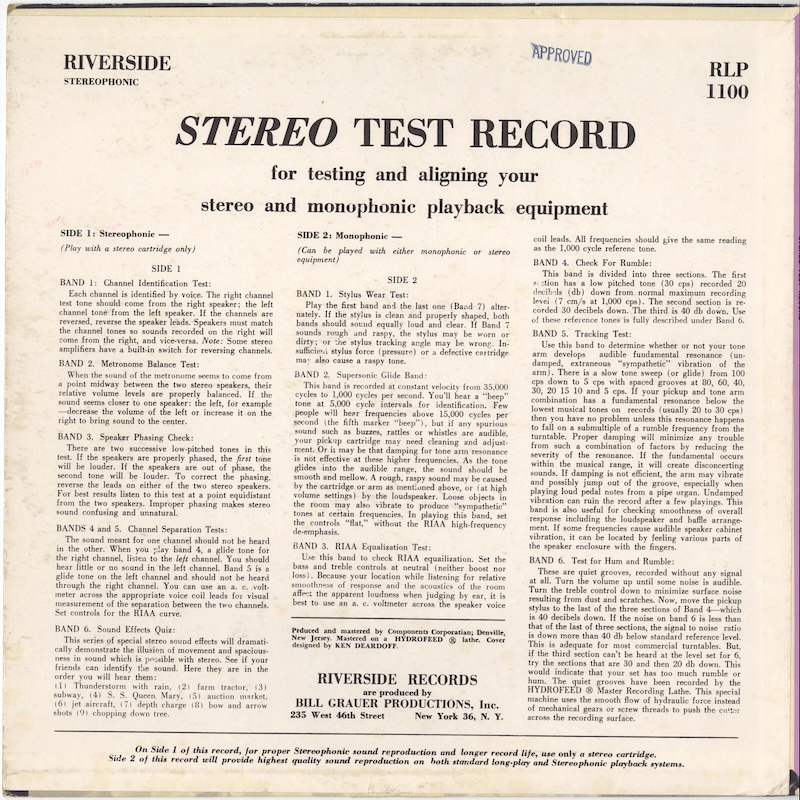
Stereo Test Record (Riverside RLP-1100) Rear Cover
from my own collection
余談ですが、実はこのレコード(Riverside RLP-1100)、収録内容をみてみると、Components Corp. 自身がリリースしていた「Hi-Fi Test Record – Stereo/Monophonic」(Components Corp. no number)と同一内容のようです。
As a side note, according to the track listing, this record (Riverside RLP-1100) actually seems to be identical to the “Hi-Fi Test Record – Stereo/Monophonic” (Components Corp. no number), released by Components Corp. itself.
ステレオのA面は A-1 左右チャンネルテスト、A-2 バランステスト、A-3 位相テストに続き、A-4 と A-5 はチャンネルセパレーションテストで、ここでは「RIAAカーブに設定すること」とライナーノーツに明記されています。A面最後はサウンドエフェクト集で、雷雨の音や農場トラクターの音、ジェット飛行機の音などが収録されています。
Side-A (stereophonic) consists of A-1 “Channel Identification Test”, A-2 “Metronome Balance Test”, A-3 “Speaker Phasing Check”, followed by A-4 and A-5 “Channel Separation Test”, where in the liner notes reads “Set controls for the RIAA curve”. The last track is a series of special stereo sound effects, such as thunderstom with rain, farm tractor, jet aircraft, etc.
モノーラルのB面は B-1 と B-7 が再生針のコンディションチェック用(Folkways FX-6100 の A-1 と A-15 と同様)、B-4 がランブルチェック、B-5 がトラッキングテスト、B-6 が無音(ハムとランブルテスト用)です。
Side-B (monophonic) consists of B-1 “Stylus Wear Test” along with B-7 “Stylus Wear Test” (similar to Folkways FX-6100’s A-1 and A-15), B-4 “Check For Rumble”, B-5 “Tracking Test” and B-6 “Test for Hum and Rumble” (quiet grooves without any signal at all).
B-2 は 35kHz〜1kHz の超高域のグライドトーン(スイープ信号)が収録されており、このトラックは RIAA から高域プリエンファシスを抜いたカーブ(1kHz 以上は定速度フラット)、すなわち 500R-FLAT で記録している、と記されています。とはいえ 1kHz 未満の信号は含まれていないため、単純に「FLAT」と言って差し支えないでしょう。
B-2 “Supersonic Glide Band” is “recorded at constant velocity from 35,000 cycles to 1,000 cycles per second”, which can be said as 500R-FLAT, or simply “FLAT”, because no frequency range below 1kHz is not recorded here.
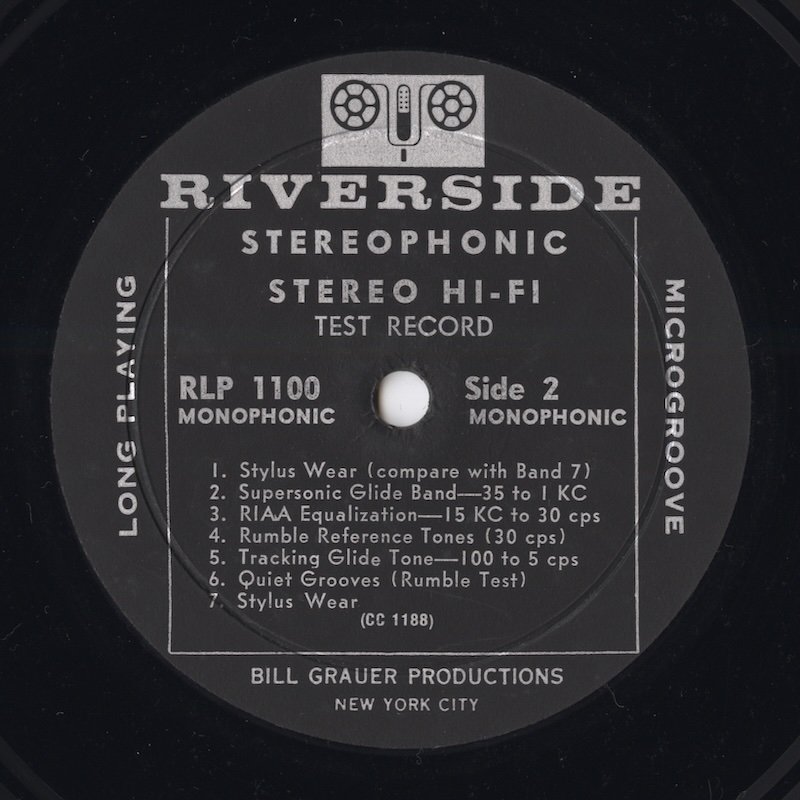
Stereo Test Record (Riverside RLP-1100) Label Side-B
Matrix: CC1188 1100B
from my own collection
B-3 はその名も「RIAA Equalization Test」で、15kHz〜30Hz のテストトーンが収録されており、RIAA カーブでの再生で全周波数帯域で同じレベルになることを確認する目的のトラックです。「耳での判断でも良いが、電圧計をスピーカ端子に接続しチェックすることが望ましい」と書かれています。
B-3 is “RIAA Equalization Test”, which contains test tons from 15kHz to 30Hz, and is intended to confirm that playback with the RIAA curve results in the same level across the entire frequency range. The liner-notes state that “it is best to use and a.c. voltmeter across the speaker voice coil leads”
ただし、本トラックにおける録音レベルについての記載はありません。標準基準レベルの測定などが必要なプロフェッショナルユースの厳密なテストレコードでなく、あくまで RIAA カーブのデエンファシスが正しく行えているかを確認する目的のため、割愛したのでしょう。
It also reads “All frequencies should give the same reading as the 1,000 cycle reference tone”, while no mention of reference recoriing level. It is probably because that this record is not a strict test record for professional use that requires special equipment for measurements. However, it still meets the purpose to confirm that the RIAA de-emphasis is performed correctly.
21.3.7 Frequency Test Record (Victor Japan TRS-1001, c. mid-1960s)
日本には、測定テストレコード用の国内標準規格として、1958年12月に策定された「JIS C 5507 基準レコード」という規格がありました(1971年12月廃止)。
Japan had a domestic standard for measurement test records called “JIS C 5507 Reference Record”, formulated in Dec. 1958 (abolished in Dec. 1971).
その JIS C 5507 に準拠した基準レコード、東芝音楽工業 LF-1003 がリリースされていました。国立国会図書館のエントリ によると、初盤は1962年リリース、赤盤とのことです。
The reference record, Toshiba Musical Industries LF-1003, conforming to JIS C 5507, was released. According to the entry at the National Diet Library, the first release (Everclean red vinyl) was in 1962.
【今週の本紙特選釣果】周波数基準レコード | 東芝音楽工業株式会社 LF 1003 | 製作 東芝音楽工業株式会社 技術部 | 監視 東芝音楽工業株式会社 中央研究所 | JIS C5507 SR-33 | このレコードはJIS(日本工業標準)によって製作された33 1/3r.p.mの微細音ミゾ用30㌢盤(型名 SR-33)の基準レコードです。 pic.twitter.com/VxDPJAtGhC
— rsvp56513 (@rsvp56513) June 12, 2021
それと同じく JIS C 5507 準拠の基準レコードが、本 Pt.21 前半にも登場した、日本ビクター(海外では JVC)のリリースした TRS-1001 です。
The same JIS C 5507-compliant reference record is the TRS-1001 from Victor Company of Japan (JVC for orverseas market), which also appeared in the first half of this Pt. 21 article.
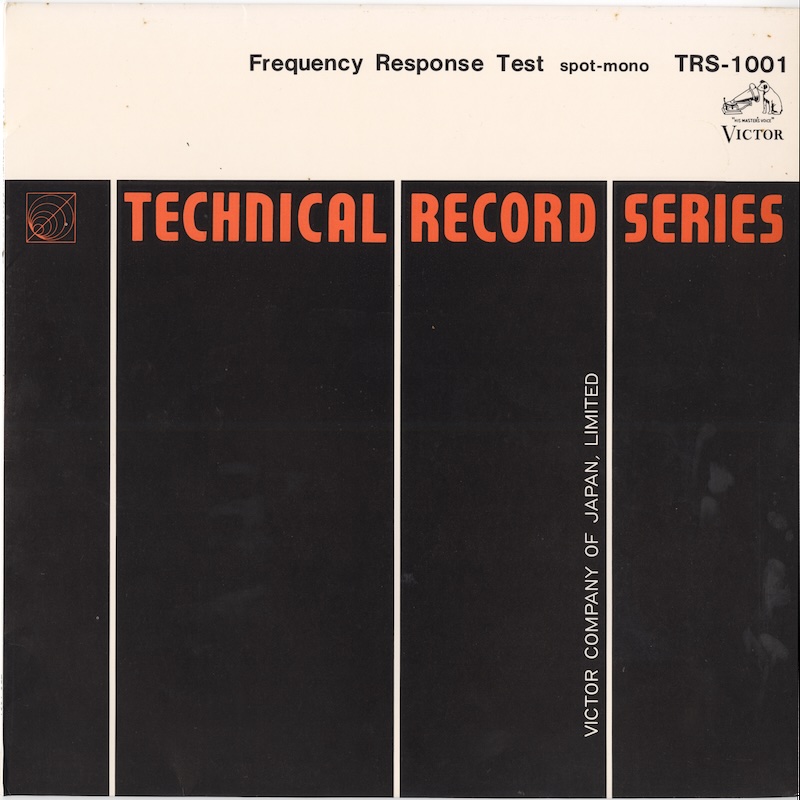
Technical Record Series: Frequency Response Test: spot-mono (Victor TRS-1001)
from my own collection
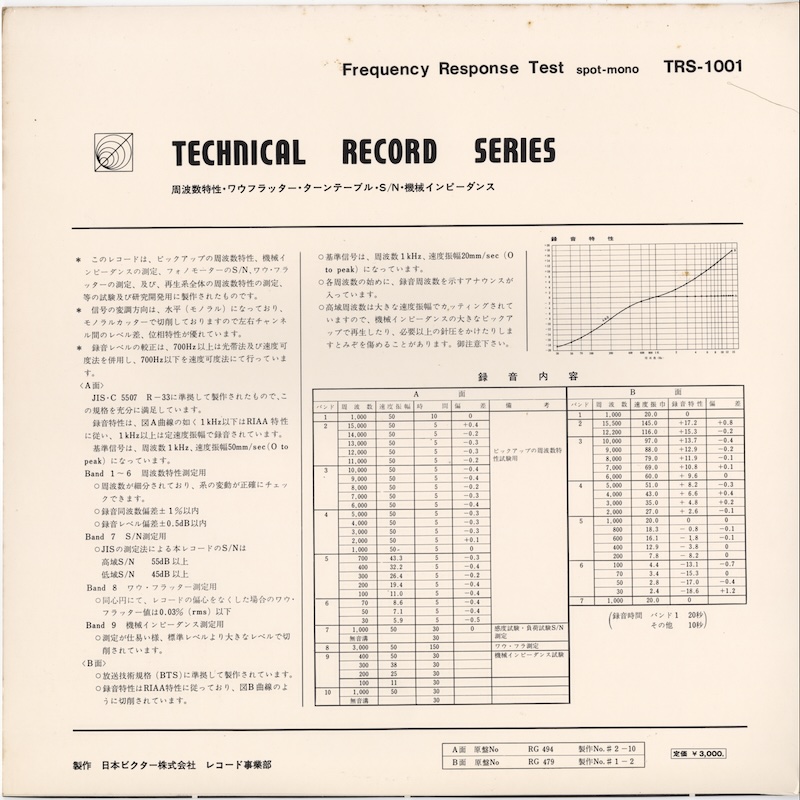
Victor TRS-1001 Rear Cover
from my own collection
この TRS-1001 は、A面が JIS C 5507 R-33 に準拠したテストレコードで、30Hz〜15kHz の信号が収められています。基準信号 1kHz の記録レベルは 5cm/s です。また、1kHz 以下は RIAA 特性、1kHz 以上は定速度フラット、という、いわゆる 500R-FLAT でカッティングされています。
Side-A of this TRS-1001 is a test record conforming to JIS C 5507 R-33, containing signals from 30Hz to 15kHz. The recording level of the reference signal 1kHz is 5cm/s. It is cut in the so-called 500R-FLAT curve, with RIAA characteristics below 1kHz, and constant velocity flat above 1kHz.
一方B面は、NHK の定めた放送技術規格(BTS, Broadcast Technical Standard)に含まれる「BTS 5305 標準周波数レコード/基準円板レコード」に準拠した収録となっており、A面と同じく 30Hz〜15kHz の信号が収められていますが、こちらは全体が RIAA 特性(500R-13.7)でカッティングされています。
Side-B, on the other hand, is in accordance with BTS 5305 Standard Frequency Record / Standard Disc Record in NHK’s BTS (Broadcast Technical Standard). Like Side-A, it contains tones from 30Hz to 15kHz, while this side is cut with RIAA characteristics (500R-13.7).
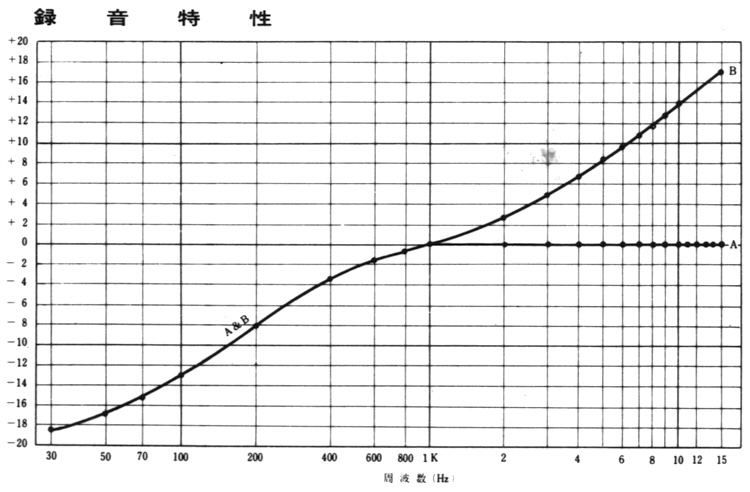
Recording Characteristics of Victor TRS-1001 (Side-A: 500R-FLAT, Side-B: RIAA)
本盤の録音特性
A面が 500R-FLAT、B面が 500R-13.7(RIAA)
オンラインオークション上に「NHK 標準周波数レコード R-25」というテストレコードが出品されていたようです。こちらをみると、レーベルには BTS-5305 という規格番号が書かれているほか、製造は日本ビクター、当該レコードをNHKが受け入れた日が昭和43年(1967年)5月6日、と書かれていますので、Victor TRS-1001 も同じく1960年代中頃に初出のレコードなのではないかと思われます。
A test record called “NHK Standard Frequency Record R-25” was found in an online auction. The label of the record has the standard number BTS-5305, and it also reads that it was manufactured by JVC, and NHK accepted the record on May 6, 1967. Therefore, it is thought that Victor TRS-1001 was also first released in the mid-1960s.
B面は RIAA 録音特性でのカッティングのため、基準信号の 1kHz は 2cm/s と若干さげられていますが、上でみた London PS-131 / Decca SXL 2057 の 1cm/s、NAB Test Record の 1.4cm/s よりも大きめの収録となっているため、高域は非常に大きな速度振幅で記録されていることになります。
Because this Side-B is cut with RIAA recording characteristics, the 1kHz reference recording level was slightly lowered to 2cm/s. However, it is larger 1cm/s of the London PS-131 / Decca SXL-2057 as well as 1.4cm/s of the NAB Test Record. This means that the high frequency range is recorded with a very large velocity amplitude.
そのためか、ジャケット裏の解説には「機械インピーダンスの大きなピックアップで再生したり、必要以上の針圧をかけたりしますとみぞを傷めることがあります。御注意下さい。」と注意書きが入っています。
This may be the reason why the liner-notes on the back cover says: “Do not use a pickup with a large mechanical impedance or apply more needle pressure than necessary — it may damage the groove. So please be careful”.
21.3.8 Audio Technical Records (DENON / Nippon Columbia XL-7001/3, 1973)
DENON / 日本コロムビアが1973年にリリースした、ボックス入り3枚組テストレコードです。
This is a boxed set of three test records from DENON / Nippon Columbia.
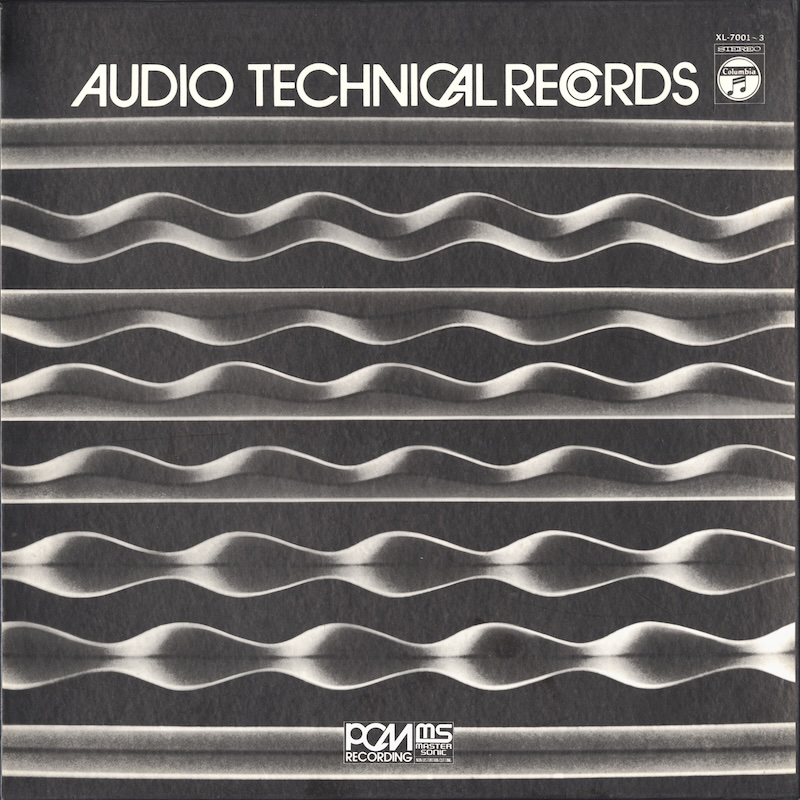
Audio Technical Record (DENON XL-7001/3)
from my own collection
日本コロムビアのサイトに、このレコードが1973年秋に出された、と記載がありました。また、XL-7001/3 は国内向け、XL-7004/6 は輸出用、と書かれています。
Nippon Columbia’s webpage states that these records were issued in the fall of 1973. It also says that XL-7001/3 is for domestic market, and XL-7004/6 for export.
このうち、XL-7001(輸出用は XL-7004)が、周波数応答計測用トラックを含むテストレコードです。この XL-7001(XL-7004)のメタルマスターを使って再プレスされたのが、現在も新品で入手可能と言われる 日本オーディオ協会 AD-1 です。
Of these, XL-7001 (XL-7004 for export) is the test record that includes tracks for frequency response measurement. Repressed using the metal master of this XL-7001 (XL-7004) is Japan Audio Society AD-1 which is said to be still available as new today.
A面冒頭が、20Hz〜20kHz のスイープ信号で、A-1 が左チャンネルのみ、A-2 が右チャンネルのみ、つまり、CBS Labs STR-100 と同等の内容です。
The beginning of Side-A is a sweep signal from 20Hz to 20kHz, with A-1 being the left channel only and A-2 being the right channel only — i.e. equivalent to the CBS Labs STR-100.
STR-100 と異なるのは録音特性です。XL-7001 の A-1 と A-2 は、ターンオーバー周波数 250Hz、それ以下は定振幅、それ以上は定速度、いわゆる 250N-FLAT で記録されています。STR-100 の A-1 と A-2 は、ターンオーバー周波数 500Hz(500N-FLAT)でした。
What differs from the CBS Labs STR-100 is the recording characteristics. XL-7001’s A-1 and A-2 are recorded with a turnover frequency of 250Hz (constant amplitude below that, and constant velocity above that), which is so-called “250N-FLAT”, while STR-100’s A-1 and A-2 are cut with the turnover frequency of 500Hz (500N-FLAT).
そのため、フォノカートリッジの周波数応答特性を正確に計測するには、ターンオーバー 250Hz のみデエンファシスを行う、特別な補償回路(フォノイコ)を用意する必要があります。この補償回路の回路図が、ライナーノーツに掲載されており、Brüel & Kjær 2112 スペクトロメータ + 2305 レベルレコーダで周波数応答特性とクロストーク特性をプロットした測定例が掲載されています。
Therefore, to accurately measure the frequency response characteristics of a phono cartridge, it is necessary to have a special compensation circuit (phono EQ) that de-emphasizes only the 250Hz turnover. A schematic of this compensation circuit is included in the liner-notes, and an example measurement plotting the frequency response characteristics and crosstalk characteristics with Brüel & Kjær 2112 spectrometer + 2305 level recorder is also included.

Recording Characteristics, Replay Compensator Circuits, and Frequency Response of DENON XL-7001 (XL-7004) Tracks A-1 & A-2
from the booklet of DENON XL-7001/3
from my own collection
XL-7001 A-1 と A-2 の録音特性カーブ(250N-FLAT)、専用の再生補償回路図、測定例が掲載されている
Brüel & Kjær 2112 + 2305 は、1965年 B&K カタログに掲載されているのが確認できます。
Brüel & Kjær 2112 + 2305 can be found in the 1965 B&K catalog.
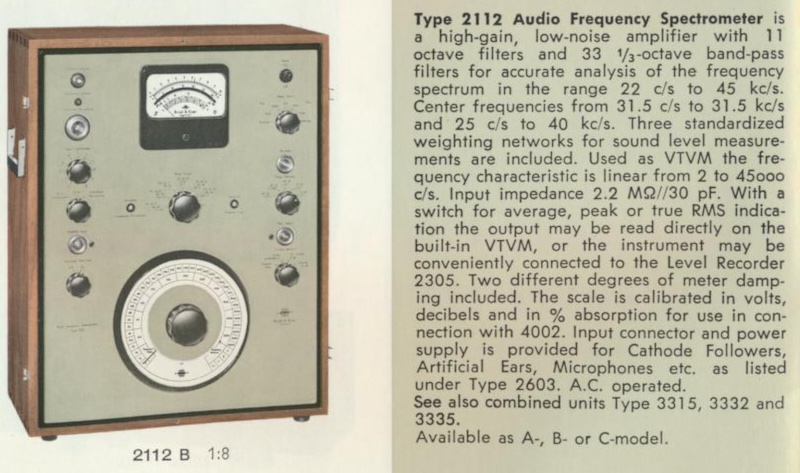
source: Brüel & Kjær Short Catalog, Feb. 1965.
B&K カタログに掲載された、2112 スペクトロメータ
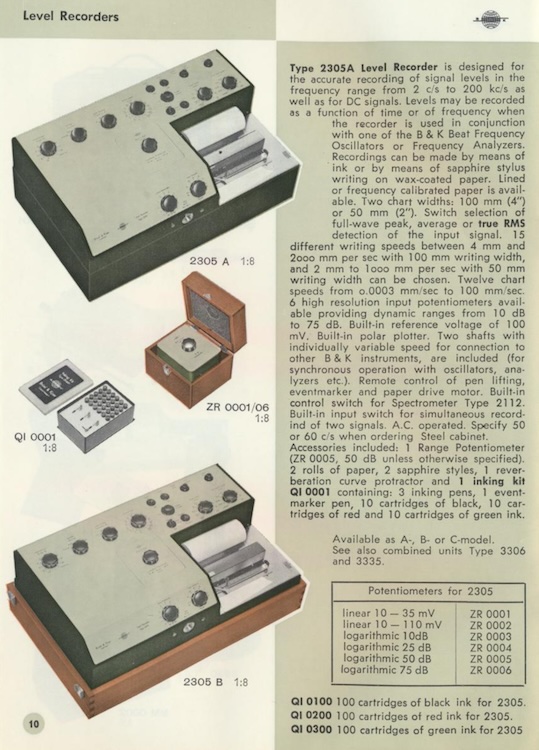
source: Brüel & Kjær Short Catalog, Feb. 1965.
B&K カタログに掲載された、2305 レベルレコーダ
XL-7001(XL-7004)のA面の残りですが、A-3 は機械インピーダンス測定用信号、A-4 は低域共振測定用の4Hz〜100Hzのスイープ信号(ターンオーバー250Hz)、A-5 はワウ・フラッタ測定用の3kHz信号が、それぞれ収録されています。
As for the rest of Side-A of XL-7001 (XL-7004), A-3 is a tone for measuring mechanical impedance; A-4 being a 4Hz to 100Hz sweep signal (turnover 250Hz) for measuring low-frequency resonance; and A-5 being a 3kHz signal for measuring wow and flutter.
B面に収録されているのは、B-1 と B-2 が 25Hz〜16kHz の1/3オクターブ・バンドノイズ(RIAA録音特性)、B-2 と B-3 の間がインサイドフォース測定用、B-3 が位相チェック用信号、B-4 と B-5 が基準レベル(3.54cm/s at 1kHz, 45°)、B-6 が無音溝となっています。
Flipside contains: B-1 and B-2 being 1/3-octave band noise from 25Hz to 16kHz (RIAA recording characteristics); band between B-2 and B-3 for inside force measurement; B-3 being phase check signal; B-4 and B-5 as reference level (3.54cm/s at 1kHz, 45°). B-6 is a silent groove.
XL-7002(輸出用は XL-7005)および XL-7003(輸出用は XL-7006)のテストレコードも非常に凝った内容のトラックが目白押しです。もちろん RIAA 録音特性で記録されています。
Other test records, XL-7002 (XL-7005 for export) and XL-7003 (XL-7006 for export), also feature very elaborate tracks. They are, of course, recorded with RIAA recording characteristics.
ここでは個別詳細は割愛しますが、XL-7002(XL-7005)は特に面白く、「同一オーディオ機器を使い、無響室、和室、洋室、ホールでそれぞれ再生したものをマイクで録音した音源」だったり、「ホールのステージ上での演奏を、マイク設置距離を変えて録音した音源」など、他のテストレコードではなかなか見かけない特徴を備えたトラックが多く収録されており、一般リスナーにもオーディオマニアにもおすすめです。
Although individual details are omitted here, XL-7002 (XL-7005) is particularly interesting, containing many tracks with features not easily found in other test records, such as “microphone recordings made using the same audio equipment and played in anechoic room, Japanese-style tatami room, Western-style room, and hall, respectively” and “recordings of performance on a hall stage at different microphone installation distances”. These are recommended for both general listeners and audiophiles.
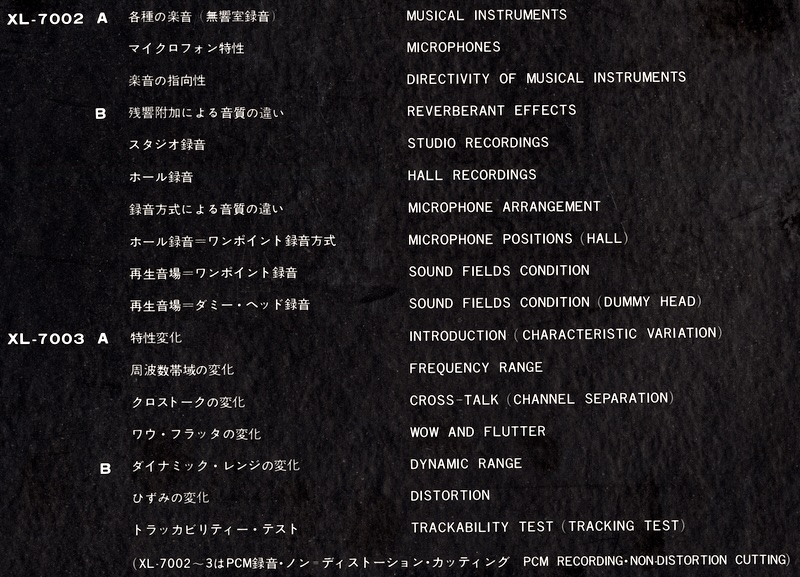
Tracklist for Discs 2 and 3 of Audio Technical Record (DENON XL-7001/3)
from my own collection
21.3.9 Test Record for Cartridge File (SONY YESA-46, 1977)
1977年に日本のソニーから出された非売品のデモンストレーションレコード SONY YESA-46 です。7インチ45回転盤で、A面が計測用テスト用、B面がPCM録音のデモンストレーション用となっています。
This is a not-for-sale demonstration record, SONY YESA-46, 7-inch 45rpm. Side-A is for measurement test, and Side-B for demonstration of PCM recording.
このレコードがどのような経緯で制作されたのかはわかりませんが、付属のブックレットをみる限り、当時の最上位MCカートリッジ SONY XL-55 に関する記述も多いことから、レコード誕生100周年にあわせて、当時販売されていた SONY オーディオ機器の付属品として制作されたのかもしれません。
I do not know how this record was produced, but the accompanying booklet contains many references to the top-of-the-line MC cartridge of the time, the SONY XL-55, so it may have been produced as a complimentary accessory for SONY audio equipment sold at the time, to coincide with the 100th anniversary of the phonograph records.
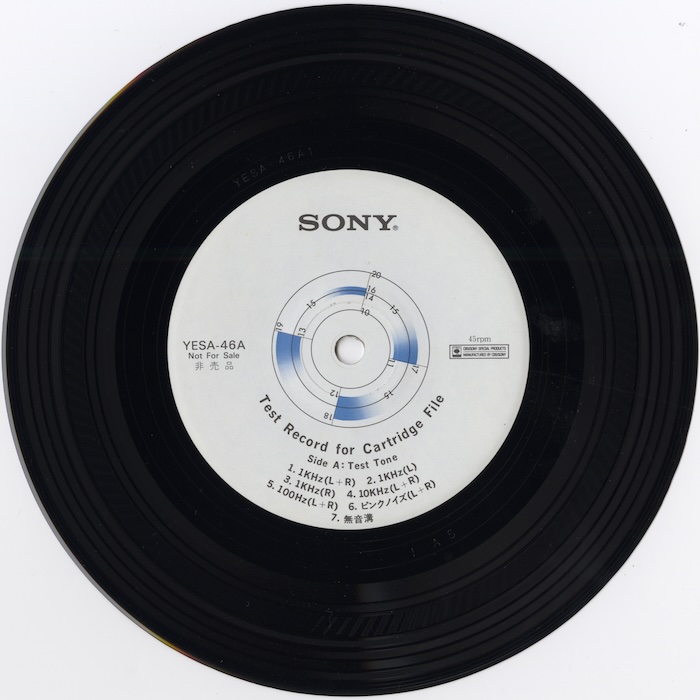
SONY YESA-46 Side-A
from my own collection
A面に収録されているのは、A-1〜3 が 1kHz 基準信号、A-1 はモノーラルで、A-2 が左チャンネルのみ、A-3 が右チャンネルのみです。
Side-A starts off with 1kHz reference tone: A-1 (monaural), A-2 (stereo left channel only) and A-3 (stereo right channel only).
続いて A-4 は 10kHz モノーラル信号ですが、A-1 の 1kHz 基準信号(5cm/s)に比べて -6dB であれば、RIAA フォノイコを通した特性が(RIAA 再生特性的に)フラットであることを確認できる、という目的のトラックです。
Next A-4 is a 10kHz monaural signal. The purpose of this track to confirm that the characteristics through the RIAA-compliant phono preamp is flat (in terms of RIAA playback) if the A-4 signal is 6dB lower than the 1kHz reference signal (5cm/s) of A-1.
A-5 は 100Hz モノーラル信号で、低周波大振幅信号による針飛びチェック用です。A-6 はピンクノイズで、コンデンサ型ヘッドフォンとスピーカの音を聴き比べ、スピーカ特性とルームアコースティクスを聴覚チェックするためのトラックです。最後の A-7 は無音トラックです。
A-5 is a 100Hz monaural tone and is used to check for needle skip due to low-frequency large-amplitude signals; A-6 is pink noise and used to aurally check loudspeaker characteristics and room acoustics by comparing the sound from condenser-type headphones and loudspeakers. The last track, A-7, is a silent track.
B面は、ソニー研究所内のスタジオでのPCM録音で、ミケランジェリが1973年に来日した際に、スタインウェイ工場で特別に選別して空輸したコンサートグランドピアノタイプDを使い、竹沢洋氏が演奏する「キエフの大きな門(組曲『展覧会の絵』より)」です。
Side-B features a piano performance of “La grande porte de Kiev” (from Mussorgsky’s “Pictures at an Exhibition”), by Hiroshi Takezawa. It was recorded at a studio, Sony Lab, using the Steinway Concert Grand Piano type D, that was sorted by Arturo Benedetti Michelangeli and airlifted from Steinway & Sons piano factory, Hamburg.
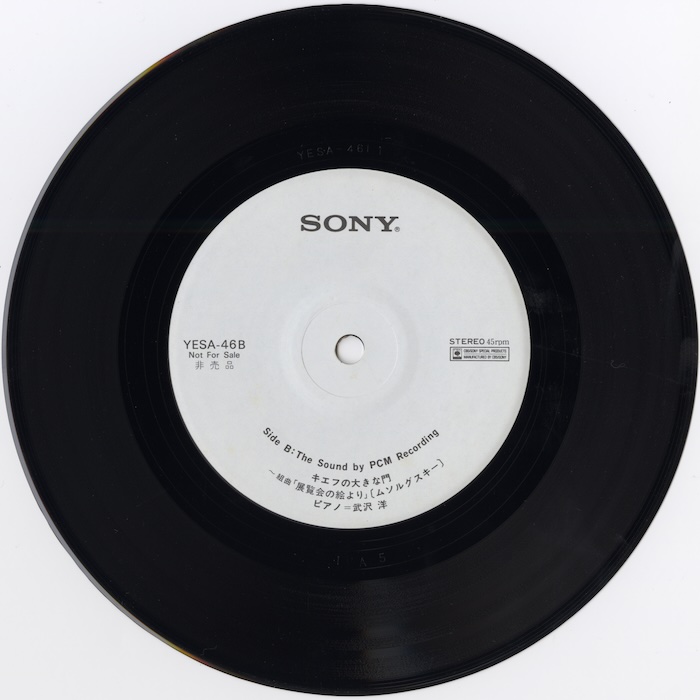
SONY YESA-46 Side-B
from my own collection
また、本テストレコードに付属する豪華36ページブックレットは読み応え満点です。
Also included with this test record is a gorgeous 36-page booklet that is well worth reading.
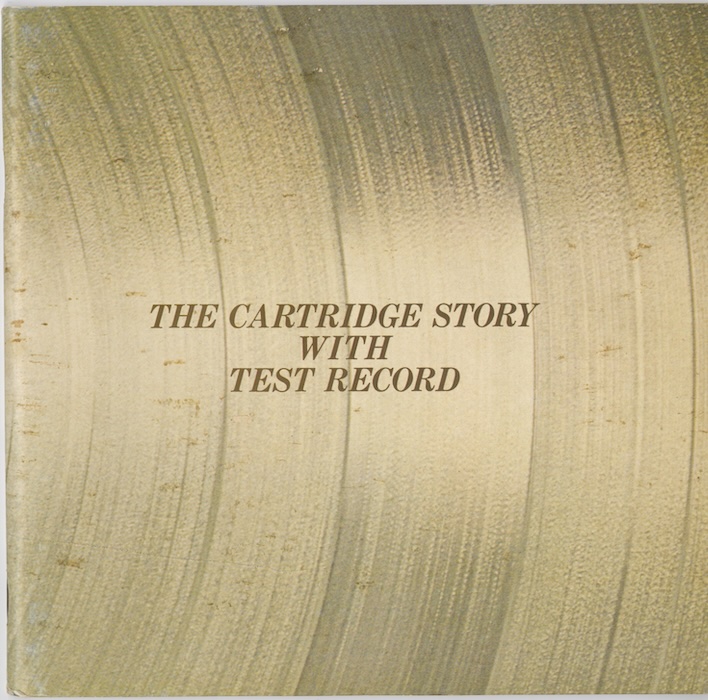
“THE CARTRIDGE STORY WITH TEST RECORD”,
a 36-page booklet that came with “Test Record for Cartridge File” (SONY YESA-46)
from my own collection
1877年に始まったレコードの歴史、カートリッジの内部解説、スタイラスとカンチレバーの話、評論家によるコラム、など、読み応えのある一般リスナー層向けの平易なコンテンツが満載で、1977年当時のオーディオシーンを懐かしく思い出させてくれる内容となっています(私は当時小学校1年生でしたがw)。
The booklet is packed with easy-to-read contents for general listeners, including a history of phonograph records since 1877, and inside look at phono cartridges, stylus and cantilever stories, columns by critics, and much more — all of which will bring back fond memories of the audio scene in 1977 (although I was 7-yrs-old back then).
21.3.10 Testing Your Equipment by DENON/PCM (DENON / Nippon Columbia OW-7401-ND, 1977)
同じく1977年にリリースされた DENON OW-7401-ND は、A面がテスト用トーンが収録され、B面が音楽ソースによる聴覚テスト用です。
DENON OW-7401-ND, also released in 1977, contains test tones on Side-A, and aural check with music tracks on Side-B.
ジャケットカバーには、SN7495AN (7402)、SN7410N (7345)、SN7400N (AHA7334)、SN7483AN (7340) など、懐かしいTTLロジックIC が並んだ基板が大写しになっており、1977年当時のディジタル演算技術のイメージを鮮やかに切り取っています。
The front cover captures a large image of a circuit board with nostalgic TTL logic ICs such as SN7495AN (7402), SN7410N (7345), SN7400N (AHA7334), and SN7483AN (7340) — the typical image of digital arithmetic technology at that time in 1977 is vividly captured.
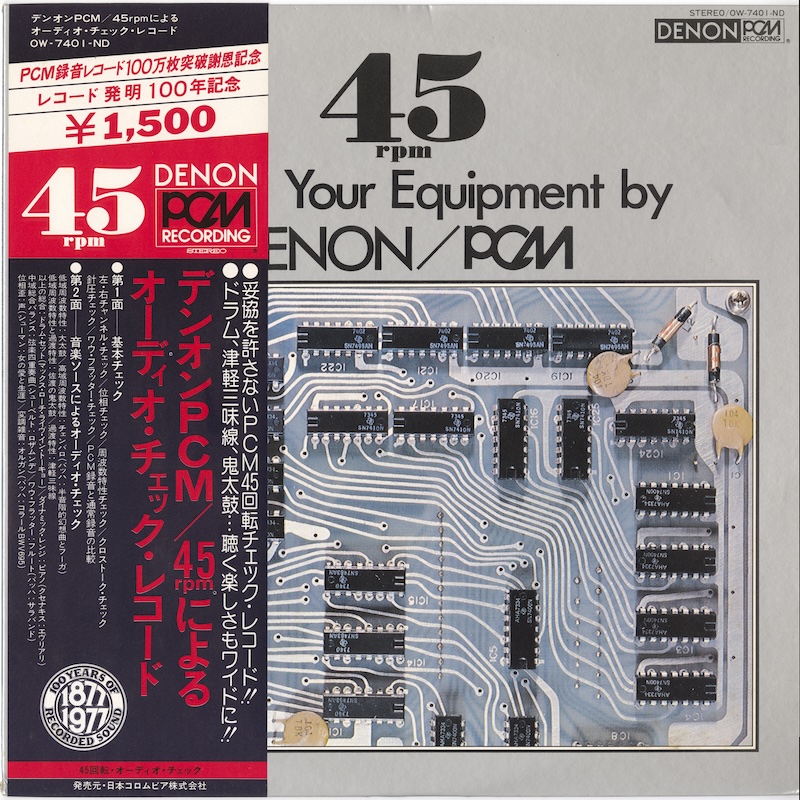
Testing Your Equipment by DENON PCM Recording (DENON OW-7401-ND)
from my own collection
A面が簡易計測用で、標準的な各種テストトラックが RIAA 特性で収録されています。A-7 が基準録音レベルで、5cm/s at 1kHz(3.54cm/s at 1kHz, 45°)で記録されています。A-2「周波数特性テスト」が、「アンプの再生イコライザ特性を含めたカートリッジの周波数特性」をチェックするためのもので、A-7 より低いレベル(明記なし)で 70Hz / 200Hz / 1kHz / 5kHz / 10kHz と収録されており、RIAA 準拠フォノイコで再生した際の偏差をチェックします。
Side-A is for casual measurements, with standard test tracks recorded with RIAA characteristics. Track A-7 is the reference recording level, 5cm/s at 1kHz (3.54cm/s at 1kHz, 45°). A-2 “Frequency Response Test” is for checking “frequency response including the responses of cartridge and the phono EQ”, including 70Hz, 200Hz, 1kHz, 5kHz and 10kHz test tones, cut at a lower level (not specified) than the A-7 reference tone. It is used to check the deviation when played back with RIAA-compliant phono preamp.
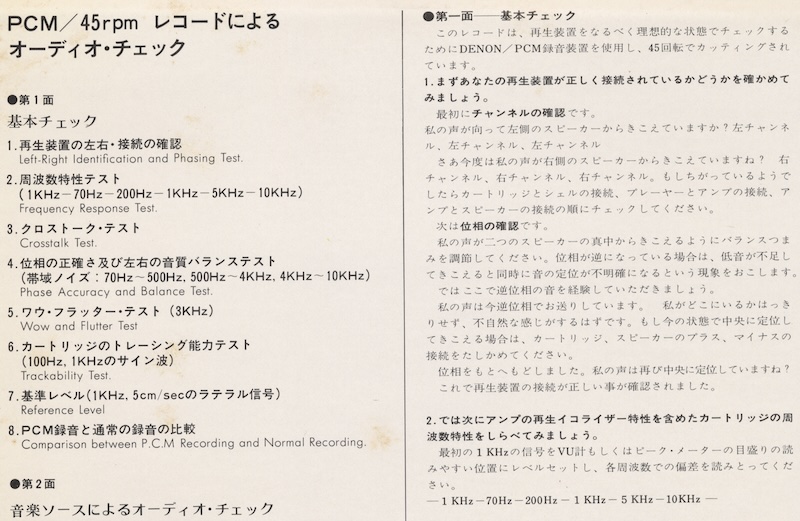
Excerpt from Liner-notes of “Testing Your Equipment by DENON PCM Recording” (DENON OW-7401-ND)
from my own collection
B面は聴感チェック用の実際の音源が収録されており、ライナーでは聴感でのチェックを行うためのポイントが解説されています。もちろん RIAA 特性で記録されています。
Side-B contains the actual sound source for aural check, and the liner-notes explains the key points for listening tests. Of course, it is recorded with RIAA characteristics.
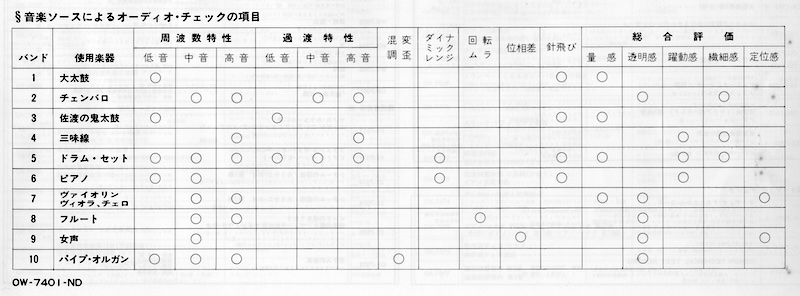
Points to check with the Side-B audio tracks on DENON OW-7401-ND
OW-7401-ND B面に収録された音源のチェックポイントをまとめた表
21.3.11 Audio Test Record (Technics SFC-TR100, c. 1979)
続いて、Technics の非売品テストレコード SFC-TR100 です。
Next is a Technics SFC-TR100 test record, not for sale.
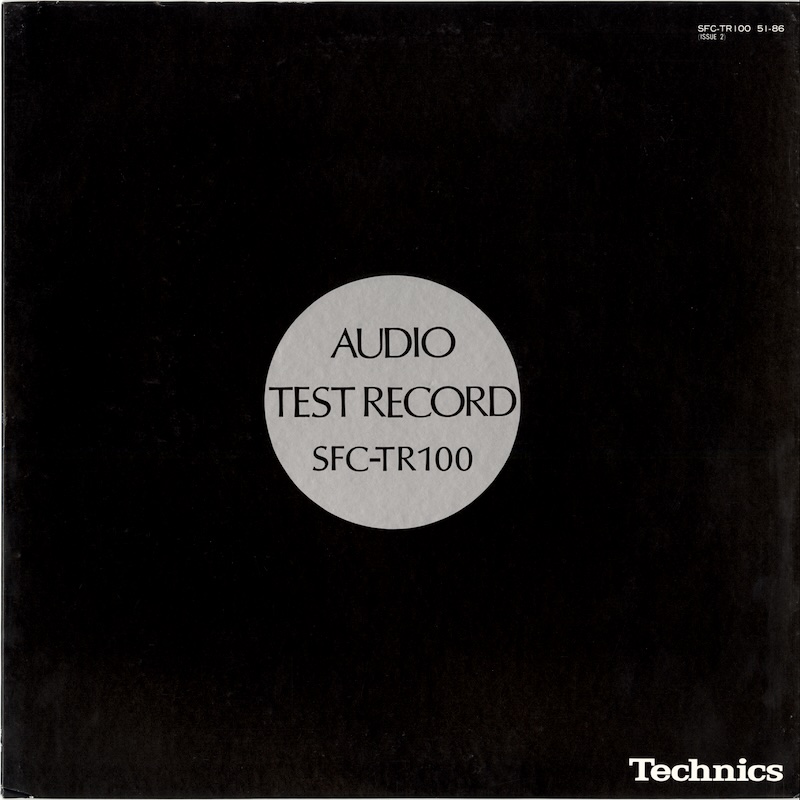
Technics SFC-TR100 Front Cover
from my own collection
Technics が1979年に販売した当時の最高級カートリッジ EPC-100C Mk2、および1981年の EPC-100C Mk3 に付属していたものだそうで、某オンラインオークションに出品された写真で EPC-100C Mk2 のLPボックスサイズ(!)の元箱に収められた SFC-TR100 を拝むことができます。
The SFC-TR100 came with Technics’ top-of-the-line EPC-100C Mk2 cartridge (1979) and EPC-100C Mk3 (1981). According to the photos of the EPC-100C Mk2 in an online auction, you can see SFC-TR100 in the original LP-size box (!!) of EPC-100C Mk2.
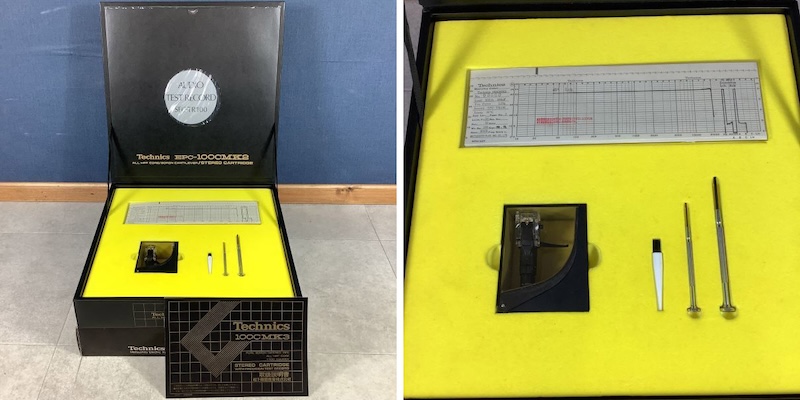
Technics EPC-100Mk2 / SFC-TR100 in original box
source: Aucfan (retrieved: Mar. 31, 2024)
オンラインオークションに出品されていた、元箱入りの EPC-100CMk2(SFC-TR100 付属)
本テストレコードの制作は、1961年〜1999年に松下電器産業傘下だったテイチクレコードです。A面が計測テスト用、B面がデモンストレーション用です。
This particular test record was produced by Teichiku Records, which was under Matsushita Electric Industrial Company from 1961 to 1999. Side-A is for measurement test, and Side-B is for demonstration.
ライナーによると、録音はテイチク杉並スタジオで、カッティングはテイチク奈良本社工場で行われた(カッティングエンジニア:汐見宜三 & 阪口修一)、とあります。また、使用カッティングアンプが Neumann SAL-74 と明記されています。
According to the liner notes, the recording was done at Teichiku Suginami Studio, Tokyo, and the mastering (cutting) was done at Teichiku Nara factory (by cutting engineers Yoshimi Shiomi and Shu-ichi Sakaguchi). The liner also states that the cutting amplifier used was Neumann SAL-74.
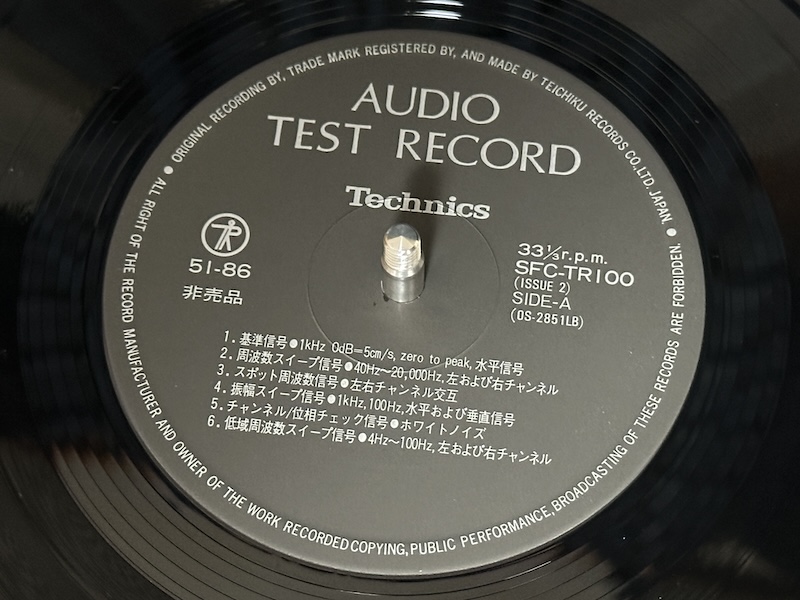
Technics SFC-TR100 Label Side-A
from my own collection
A-1 には 5cm/s at 1kHz のラテラル基準信号が収録されています。そして A-2 と A-3 が周波数応答計測用で、A-2 が 40Hz〜20kHz のスイープ信号、A-3 が 16kHz、8kHz、4kHz、2kHz、1kHz、500Hz、250Hz、125Hz、62.5Hz のスポット周波数信号が収録されています。
Track A-1 contains a 5cm/s at 1kHz latereal reference signal. A-2 and A-3 are for frequency response measurement: A-2 containing a sweep signal from 40Hz to 20kHz; A-3 contains spot frequency signals at 16kHz, 8kHz, 4kHz, 2kHz, 1kHz, 500Hz, 250Hz, 125Hz and 62.5Hz.
A-4 には振幅スイープ信号(1kHz と 100Hz がそれぞれ無音から最大振幅まで)が収録されており、トレース能力のチェックのほか、1kHz の機械インピーダンス、100Hz のコンプライアンスを求めるために使われます。続く A-5 には位相チェック信号が収録されています。
Track A-4 contains amplitude sweep signals (1kHz and 100Hz, from silence to maximum amplitude, respectively), which are used to check tracking ability as well as to determine cartridge’s mechanical impedance at 1kHz and compliance at 100Hz. A-5 contains a phase check signal.
ここまで(A-2〜A-5)は、ライナーノーツの表記いわく「1/2 RIAAカーブ」、すなわち RIAA カーブから高域プリエンファシスを抜いたもの(500R-FLAT)で記録されています。ちょうど Neumann SAL-74 カッティングアンプのスイッチを「RIAA OUT」にした特性と同一です。
The recording characteristics used for tracks from A-2 to A-5 is, according to the liner-notes, “1/2 RIAA curve”, which is the RIAA recording curve without the high-frequency pre-emphasis (i.e. 500R-FLAT). This is equivalent to the recording characteristics of the Neumann SAL-74 cutting amplifier, with the switch set to “RIAA OUT”.
しかし、これらのトラックは ハーフスピードカッティング とのことで、SAL-74 をそのまま使うとこの特性にはなりません。テストトーンのみのカッティングですから、通常速度で再生する際に 500R-FLAT になるように、ハーフスピードカッティング用にオシレータやファンクションジェネレータで記録信号を用意した可能性があります。
However, these tracks are, according to the liner-notes, mastered at half-speed — since the Side-A only contains test tones, it was possible to create the test tones, using the oscilator or function generator when cut at half speed, to get the 500R-FLAT characteristics when reproduced at normal speed.
また、Neumann はハーフスピードカッティング用機材を一切用意していませんでしたから、もし音楽をハーフスピードにカッティングする場合には、時定数を倍にする暫定改造を施すか、SAL-74 をバイパスしてハーフスピードカッティング用の専用回路を一時的に用意するか、いずれかの対応が必要になったはずです。
Also, it is known that none of the Neumann systems were originally designed for half-speed cutting. So, if music was cut at half-speed, the SAL-74 arguably would need eithe to be modified to double the time constants, or to be replaced with some custom-made modules to accommodate half-speed cutting.
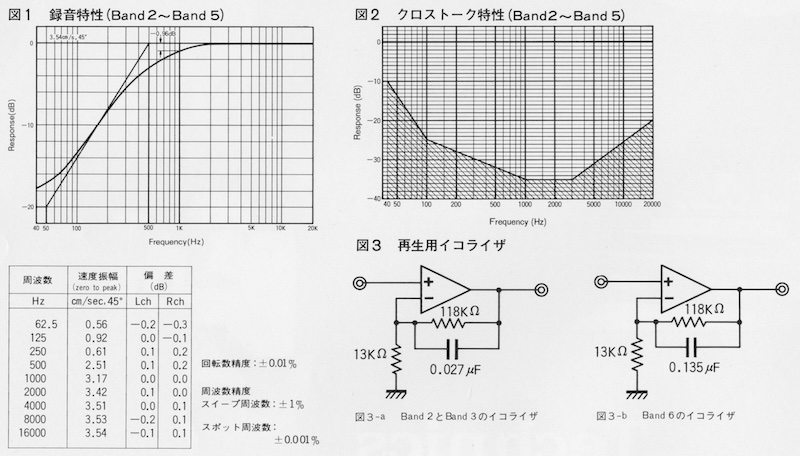
Recording characteristics for SFC-TR100 tracks A-2 to A-5 (RIAA except high-frequency pre-emphasis, a.k.a. 500R-FLAT)
図3-a が、A-2〜A-5 計測用の再生イコライザ回路図
図3-b は A-6 用
一方、A-6 は、4Hz〜100Hz の低域周波数スイープ信号で、トーンアームの共振特性測定用です。こちらはターンオーバー周波数 100Hz、ベースシェルフ 10Hz という、特殊な特性でカッティングされています。
On the other hand, track A-6 is a low frequency sweep signal from 4Hz to 100Hz, and is used to measure the resonance characteristics of the tonearm. This is cut with a special characteristics with a turnover frequency of 100Hz and a bass shelf of 10Hz.
これは、ライナーに書かれている通り、このトラックが 5倍速でカッティング されているためです。つまり、通常のターンオーバー周波数 500Hz(時定数 318μs)とベースシェルフ 50Hz(時定数3,180μs)を使って5倍速でカッティングすることで、通常速度で再生すると時定数が5倍相当になるから、ということでしょう。
This is because, as stated in the liner-notes, only this track is cut at 5x speed. In other words, it is probably because cutting at 5x speed using a normal turnover frequency of 500Hz (time constant: 318μs) and a bass shelf of 50Hz (time constant: 3,180μs) makes the time constant equivalent to 5x when played at normal speed.
上でみた通り、ライナーノーツには、A-2〜A-5 および A-6 を正確に計測するために必要な専用再生用イコライザ回路図が掲載されています。
As seen above, the liner-notes include playback equalizer schematics for precise measurements of A-2 through A-5, and A-6.
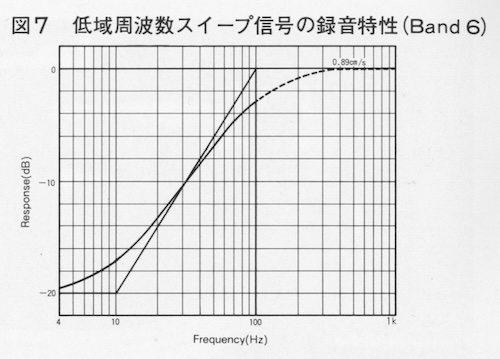
Recording characteristics for SFC-TR100 track A-6
turnover at 100Hz (1,590μs), bass-shelf at 10Hz (15,900μs)
A-6「低域周波数スイープ信号」で使われている録音特性
5倍速カッティングのため、時定数が 1/2 RIAA カーブから5倍になっている
21.3.12 Frequency Vinyl Disc / Service Vinyl Disc (TOYOKASEI TYO-1003, 2010)
最後に、現在でも新品が入手可能な、東洋化成 TYO-1003 です。東洋化成はもちろん、日本を代表するプレス工場で、このテストディスクのカッティングは 手塚和巳 さんによって行われました。
The last example from my own collection is Toyokasei TYO-1003, still available as new. Cutting was done by Mr. Tezuka Kazumi, one of the famous cutting engineers at Toyokasei.
A面がテストレコードで、左右バランス、位相、クロストーク、回転ムラ、スタンディングウェーブなど、聴覚テストができる音源のほか、50Hz〜15kHz の周波数特性チェック用スポット信号も収録されています。最後には、「特別付録:効果音」と題して、卓球、ヘリコプター、レーシングカー、蒸気機関車、トラックの音が収録されています。
Side-A is the test record for aural checkings including L/R balance, in/out phase, crosstalk, wow and flutter, standing wave, etc. Frequency response spot tones from 50Hz to 15kHz are also included. The last tracks of this side are entitled “Sound Effects”: sounds of ping-pong, helicopter, racing car, steam locomotive and truck.
B面はサービスディスクと題され、Eddy Rumbert Trio の 2002年にリリースされたスーパーアナログダイレクト録音シリーズのLPアルバム「J-POP STANDARD JAZZ」(Canary Blue / Analog Corporation KH-0329)収録曲から、サザンオールスターズの「TSUNAMI」と中森明菜の「飾りじゃないのよ涙は」の2曲が抜粋収録されています。残りはループ録音やサインウェーブを使った盤面アートなどが収録されています。
Side-B is entitled “Service Vinyl Disc”, featuring two tracks from the album “J-POP STANDARD JAZZ” (Canary Blue / Analog Corporation KH-0329), originally released in 2002 as one of the “Super Analog Direct Recording Series”. Tracks are jazzy cover versions of “TSUNAMI” (Southern All Stars) and “Kazari ja nai noyo Namida wa” (Akina Nakamori). The rest of Side-B are several loop tracks as well as sin-wave circle (artistic expression on the vinyl surface).
本盤は、両面とも RIAA での収録となっています。
Both sides of this record were cut with the RIAA recording characteristics.
21.4 Even Some More of the Test Records found on the internet
その他、完全網羅はできていませんが、ネット上で目にしたさまざまなテストレコード(主に一般市場向け)を、備忘録として載せておきます。
Varous other test records (mainly for consumers) I have seen on the internet (although not completely exhaustive) are included as a reminder of mine.
| Label & Cat. No. | Title | Country | Year |
|---|---|---|---|
| Nippon Columbia TD-3001 |
コロムビア・ステレオ・テスト・レコード | Japan | 1961 |
| Audio-Technica AT-6601 |
Moving Pulse 耳で聴くステレオ・テスト・レコード | Japan | 1966 |
| SANSUI SSR-101 |
チェック・アンド・プレイ | Japan | 1969 |
| DENON HRS-1060-ND |
PCM録音へのお誘い / Invitation to DENON/PCM | Japan | 1975 |
| Nippon Columbia GA-11 |
オーディオ・テクニカル・チェック | Japan | 1976 |
| Technics SFC-TR100 |
Audio Test Record | Japan | 1976? |
| DENON YW-7401-ND |
ジャズ・ファンのためのPCMオーディオチェック / Invitation to DENON/PCM | Japan | 1978 |
| CBS/SONY 28AG 412 |
Audio Tune Up | Japan | 1979 |
| Audio Fidelity FCS 50000 |
Stereo Test Record | Japan | 1979 |
| Urania URLP-7084 |
High Fidelity Demonstration Record | U.S. | 1953 |
| Trans-World TWLP-201 |
For Hi-Fi Bugs | U.S. | 1957 |
| Urania UPS 1 |
Testing: Popular Science Hi-Fi Test Record | U.S. | 1957 |
| Omega Disk OSD-1 |
Sounds Out Of This World (Balance, Test, Demonstration) | U.S. | 1958? |
| Capitol SWAL-9032 |
The Stereo Disc | U.S. | 1958 |
| Command CSC 100 |
Stereo Check Out | U.S. | 1960 |
| Audiotex 30-200 |
Stereo Test Record | U.S. | 1963 |
| CBS Labs STR-101 |
Seven Steps To Better Listening | U.S. | 1964 |
| Project 3 Total Sound PR 201 SD |
Stereo Test Record – Testing 1,2,3,4 | U.S. | 1967 |
| Stereo Review SRT 12 |
Stereo Review’s Stereo Test Record | U.S. | 1969 |
| Yorkshire 27012 |
RCOA Stereo Systems Test Record | U.S. | 1972 |
| Orion no number |
(untitled) | U.S. | 1977 |
| Gateway GSLP-4503 |
How To Set Up And Test Hi-Fi Stereo Systems | U.S. | 1977 |
| Crown Audio CI 4416 |
Equalization Test Record | U.S. | 1978? |
| Telarc DG-10073/74 |
Omnidisc | U.S. | 1982 |
| Analogue Productions AAPT-1 |
Ultimate Analogue Test LP | U.S. | 2006 |
| U.K. Decca SKL 4861 |
How To Give Yourself A Stereo Check-Out | U.K. | 1967 |
| U.K. Decca PFFS 1 |
A Guide To Better Listening | U.K. | 1967 |
| Audix ADX 301 |
Stereo Test & Demonstration Record | U.K. | 1970 |
| Nad T/MP-2 |
NAD 5120 Test Record | U.K. | 1983 |
| dhfi Platte 2 |
Die dhfi Schallplatte 2: Hörtest- Und Meßplatte | Germany | 1968 |
| RCA / Ullstein Musik RL 30738 |
Hi-Fi Test | Germany | 1981 |
| Lenco 771 |
Prüfplatte NR. 771 | Germany | 1982 |
| Clearaudio LPT 43039 |
Trackability Test Record | Germany | 2005 |
| VEB Deutsche Schallplatten Berlin LB-204 |
Meßschallplatte Übertragungskurve Übersprechdämpfung | GDR (East Germany) | 1972 |
| Hungaroton SLPD 19134 |
Mérőlemez (Test Record) | Hungary | 1984 |
| B&O 3621003 |
Stereo Test and Demonstration | Denmark | — |
| Ortofon 0001 |
Ortofon Pick Up Test Record – Direct Cut | Denmark | 1978 |
| Ortofon 0002 |
Ortofon Pick Up Test Record – Test Of Signals And Music | Denmark | 1978? |
| Ortofon no number |
Ortofon Test Record | Denmark | 2016 |
| CNR 160 501 |
Hifi Stereo Test | Netherlands | 1973 |
| Erato 387005/6 |
Hi-Fi Test | Netherlands | 1973 |
| CNR P 695001 |
Stereo-Test + Demonstratie | Netherlands | 1977 |
| Erato 387012-1/2 |
Hi-Fi Test (2) | Netherlands | 1978 |
21.5 The summary of what I got this time / 自分なりのまとめ
当初は、テストレコードの話題について軽く触れる程度にして、まとめに入る予定でした。しかし、調べれば調べるほど興味深い情報に遭遇し、新たな疑問が発生したため、結局は独立した投稿としました。
Initially, I had planned to only briefly touch on the topic of test records and then begin to summarize the entire series of what I have learned and written so far. However, the more I researched, the more interesting information I came across and new questions arose, so I ended up making this an independent post.
テストレコードそのものについて改めて学ぶことができたほか、78回転盤時代から存在したテストレコードのバリエーションを眺めていくことで、多くの知見を得ることができました。
In addition to learning anew about the test records themselves, I gained a great deal of insight by looking at the variations of test records that have existes since the 78 rpm era.
特に、カートリッジとフォノイコの総合的な周波数応答特性をチェックするテストレコードは、(1953年 Dubbings の業務用テストレコード、1954年 Folkways / Bartók の市販用テストレコード、の数少ない例外を除いて)米国では1950年代中頃から特定の録音再生特性(あるいはその特性のうち1kHz以上を定速度フラットにしたもの)のみしか見つけられなかったことが確認できました。
In particular, I have learned that all the frequency test records since middle 1950s — for checking the overall frequency response characteristics of cartridges and phono EQs — had employed the particular recording / reproducing characteristics (or the one without high frequency pre-emphasis above 1kHz) that was the industry standard. The only exceptions I could find are: the test records for professional use from Dubbings Company (1953), the other being the test record for consumer from Folkways (1954).
さてさて、今回の内容をざっくりまとめると、こんな感じでしょうか。
…so, the rough summary of my understanding in this Pt.21 article would be something like this:
周波数応答特性チェックに代表される各種テストレコードは、放送局や録音スタジオ、再生機器メーカなど、プロフェッショナルユースで長らく使われてきた。その際、厳密な測定は専用の機器などを使って行われた。
Various types of test records, as typified by frequency response characteristic checks, have long been used throughout the professional field, including broadcast stations, recording studios, and audio equipment manufacturers. In such cases, strict tests were conducted using specialized measurement equipment.
プロフェッショナル仕様の厳密なテストレコード以外にも、オーディオブームだった1950年代〜1980年代には、オーディオチェックレコード(ハイファイデモンストレーションレコード)を含め、再生機器の性能を聴感チェックするための民生用テストレコードが多種リリースされていた。
In addition to these strictly professional test records, a wide variety of consumer-use test records, including Hi-Fi demonstration records (a.k.a. “audio check records”), were released from the 1950s to the 1980s, when the audio boom was in full swing for aural checks of the performance of consumer equipment.
フォノカートリッジの応答特性チェックには、従来、ターンオーバー周波数より下を定振幅、それより上を定速度というカーブでカッティングされたテストレコードが使われてきた。この特性は、1950年頃までは、録音EQを抜いたカッターヘッド自体の特性であった。
For checking the response characteristics of phono cartriges alone, most test records were originally cut using a curve with a constant amplitude below the turnover frequency and a constant velocity above it. This curve was the same one as most cutterheads themselves had (without the recording equalizers) prior to around early 1950s.
フラットカッティングが可能になったフィードバックカッターが浸透したおよそ1950年代中頃〜後半頃からは、上のカーブの盤に加え、1kHz 以下は特定の録音特性(通常RIAA)、1kHz 以上は定速度、というカーブでカッティングされたテストレコードが主流となった。これは、当時使われていた主要なカッティングアンプに較正用ポジションとして用意されている特性(高域プリエンファシスのみオフ)、と同じであった。
Since mid-late 1950s, around when the feedback cutterheads (that enabled flat cutting) became penetrated in the mastering studios, most test records had been cut using a curve with a specific recording curve (typically RIAA or its equivalent), except constant velocity above 1kHz. This curve was accomplished by selecting the “TEST/FLAT” position (i.e. without the high-frequency pre-emphasis portion of the recording curve), that most recording amplifiers at the time were equipped with.
一方、カートリッジとフォノEQをあわせた総合応答特性チェックには、当時使用されていた特定の録音カーブでカッティングされたテストレコードが用意されていた。
On the other hand, for checking the overall response characteristics of the phono pickups and phono preamps (phono EQs) combined, test records cut with the specific recording curves that were actually used at the time.
RIAA規格策定前には、1942/1949 NAB カーブ(500B-16)、78回転用 ffrr カーブ(350N-5.5)、LP用 ffrr カーブ(500N-10.5)、Columbia LP カーブ(500C-16)、Bartók カーブ(630C-16)など、さまざまなカーブでカットされた周波数テストレコードが存在していたが、ステレオLP登場の頃には RIAA カーブによる周波数テストレコードしか存在しなくなっていた。
Prior to the establishment of the RIAA Standards, there existed a variety of frequency test records cut with various curves, such as the 1942/1949 NAB curve (500B-16), 78rpm ffrr curve (350N-5.5), LP ffrr curve (500N-10.5), Columbia LP curve (500C-16), Bartók curve (630C-16) and others. However, by the time the stereo LP was introduced, only frequency test records with the RIAA curve (time constants: 75μs, 318μs and 3,180μs) existed.
複数の録音再生カーブで収録された周波数テストレコードが、Dubbings (1953年) と Folkways (1954年) から1枚ずつリリースされていたが、これらは非常に例外的なものであった。
Only two test records containing test tones with multiple recording/reproducing curves — one from Dubbings Company (1953), the other from Folkways (1954) — are known to exist. Such test records are very exceptional and rare.
LP黄金期の米国では、当初は RCA Victor 12-5-49 が、1960年代中頃からは NAB Test Record が、それぞれデファクトスタンダードの基準レコードとして、米国内のほぼ全てのカッティングスタジオで使用されていた。前者は New Orthophonic 特性、後者は1964年 NAB 特性を規定するテストレコードで、共に RIAA 特性と数学的に同一定義である。
During the golden years of LP records, RCA Victor 12-5-49 and NAB Test Record was used as the de facto standard reference records in almost all cutting studios in the States. The former conforms to the New Orthophonic curve, the latter to the 1964 NAB curve — both sharing the same mathematical definition as that of the RIAA curve.
次回は、1950年代中盤以降に米国で販売されていた民生用アンプについてみていく予定です。
My next post will feature the consumer amplifiers sold in the U.S. after mid-1950s.
» 続き / Sequel: “Things I learned on Phono EQ curves, Pt.22” »



